‘Pure Hatred’: An Oral History of the Steelers-Ravens Rivalry

PITTSBURGH — Wearing a gray sweatsuit on a gray day in the ’Burgh, Mike Tomlin walked out of the Steelers’ fieldhouse after practice Wednesday and delivered an encouraging thump to the back of his second-year fullback.
“Embrace your role!” Tomlin boomed. “Whatever we’ve got to do.”
It was four days before the 46th meeting between the Pittsburgh Steelers and the Baltimore Ravens, a Christmas Day encounter with the kind of stakes we’ve only come to expect from this AFC North rivalry. Of the past 45 meetings, 27 have been decided by one score, and 19 have been decided by three points or less; four were playoff games, and in two of those the winner reached the Super Bowl.
This week’s game will play a direct role in determining which team earns the AFC North crown and a chance to contend in the playoffs. If the Steelers win Sunday, they are division champions. If the Ravens win, they can claim the division with another win next week against Cincinnati. Since the NFL realignment created the AFC North in 2002, only four times has a team other than the Ravens or Steelers won the division; and, over the last 16 seasons, one-quarter of the Super Bowl titles belong to the Steelers or Ravens. That’s the bedrock for a rivalry that’s become so intense over a relatively short period of time that the contemporary players have simply been baptized into it, without fully comprehending all the reasons why.
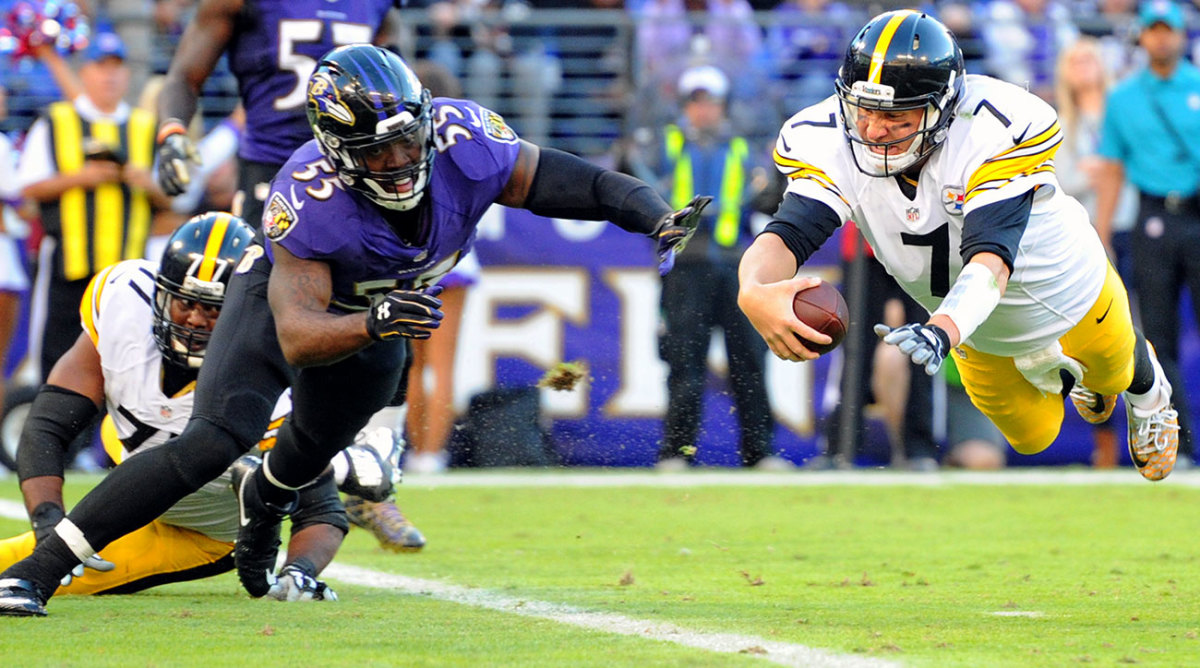
“When I got here, it was just, ‘you don’t like Baltimore,’ ” says safety Mike Mitchell, who joined the Steelers in 2014. “It’s kind of like growing up in the Cold War. You don’t like Russia. That’s just how it is.”
In Baltimore, O.J. Brigance, the Ravens’ senior advisor to player development and a special teams ace on the 2000 Super Bowl team, also serves as a motivator to the team as he’s battled ALS for the past nine years. But this week, he writes in an email message, “There is no motivation needed for this game. The motivation is instilled in the history of bad blood between the two teams!”
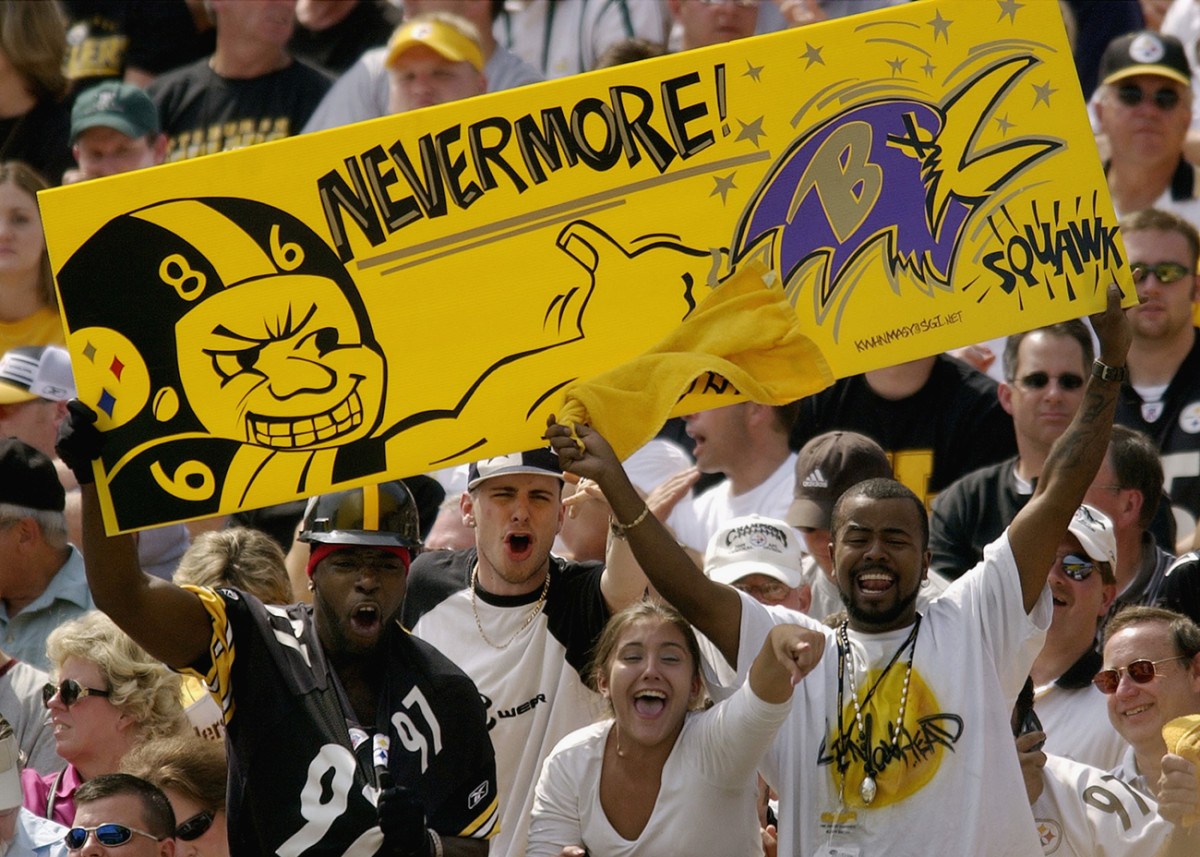
The history of (literally) bone-shattering hits by Ray Lewis and devious crackback blocks by Hines Ward, and the Bart Scott unblocked sack that took Ben Roethlisberger's breath away (again literally), and a hatred that has sparked bounty rumors and confrontations all the way out to the team buses is the prologue for every one of these games. Here are the makings of the rivalry, through the words of those that have lived it.
* * *
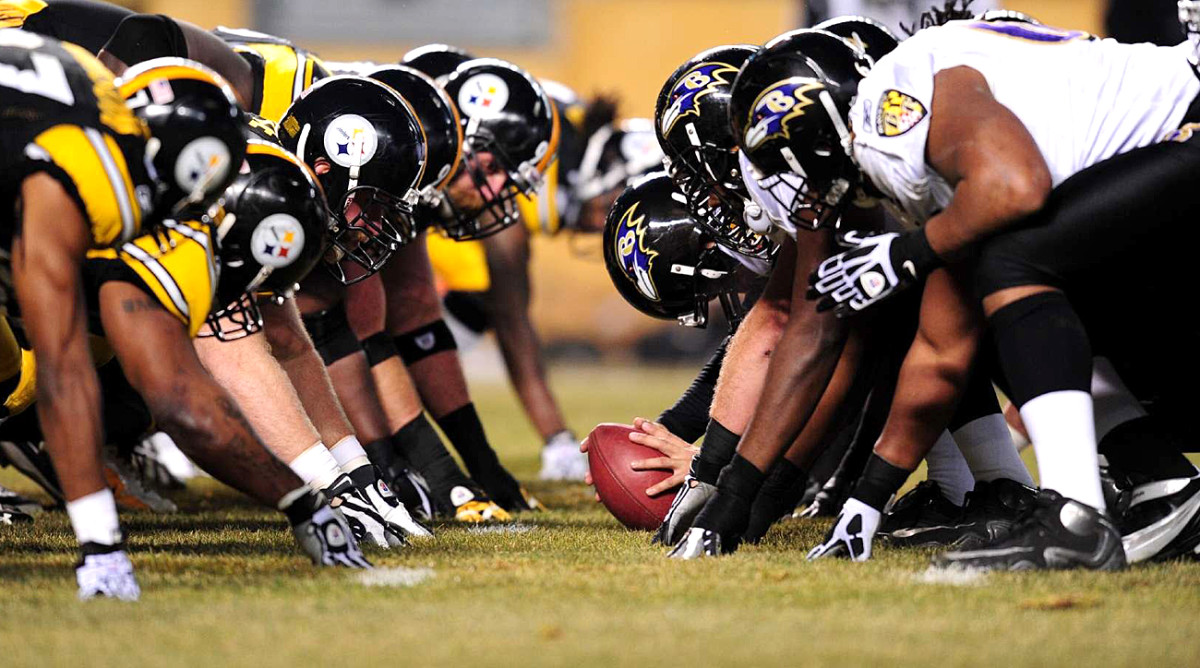
HINES WARD, Steelers receiver 1998-2011: Pure hatred. We hated everything, from the color purple. During Ravens week no one could wear purple in the building. I remember they made the office lady go home because she had a purple blouse on. She had to go change that. If a player had some purple on your Jordans or on your outfit, somehow, it ended up in the trash can. Our motto around the building, excuse my language, was, blank purple. I would just hit anything that had purple on it. I didn’t care if it was a defensive lineman, linebacker, cornerback or safety. Anything.
BART SCOTT, Ravens linebacker 2002-08, CBS studio analyst: The first time I played the Steelers, in 2002, I watched [Steelers receiver] Plaxico Burress and [Ravens cornerback] James Trapp get into a tussle on their side of field, probably about the 20-yard-line. Trapp swung Plaxico Burress around to the ground, then proceeded to jump in the air and land on his chest with his cleats. Plaxico got up and swung at him, and both of them got ejected. That was my introduction to, anything goes here.
TERRELL SUGGS, Ravens outside linebacker, 2003- : To be honest, we’re the only two teams [in the league] that play our style of football, especially our style of defense. You don’t cross paths without a few things in common. I think that’s where the conflict lies.
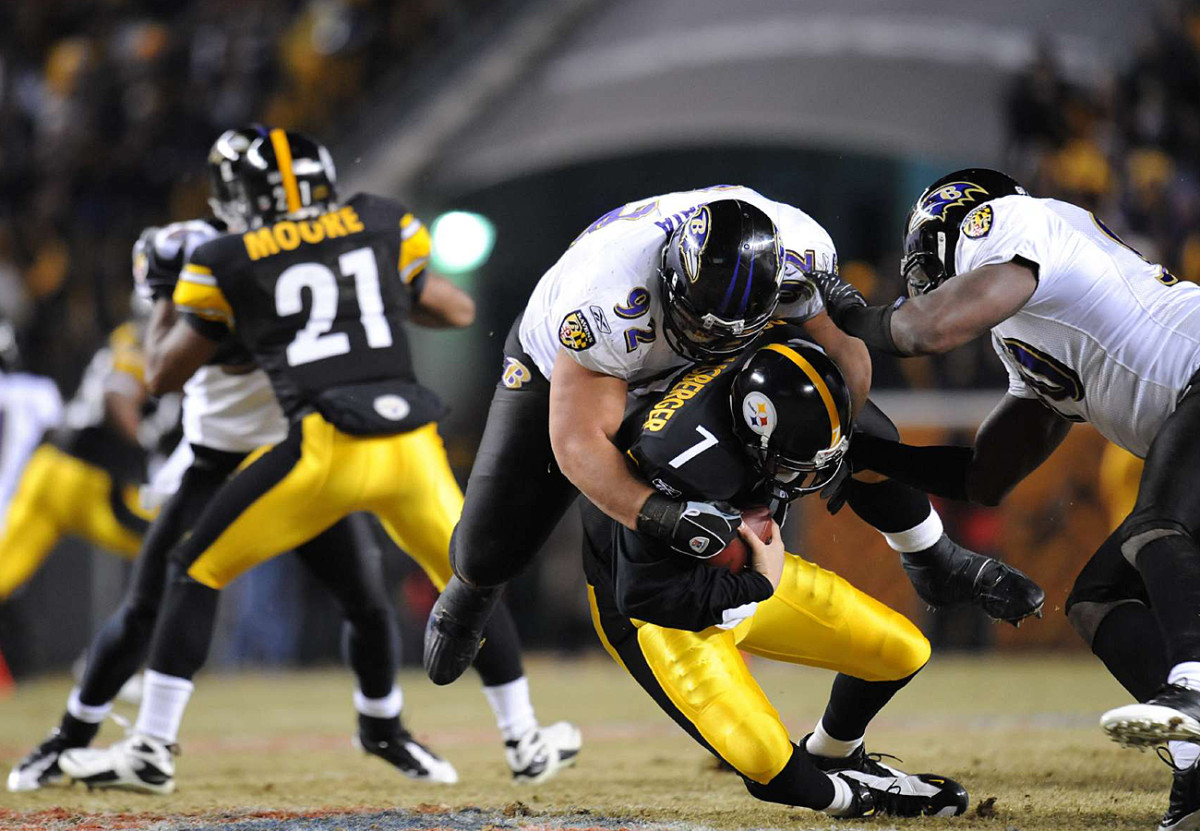
WILLIE COLON, Steelers offensive lineman 2006-12: In the locker room before the game, we would all be biting at the door, ready to go, because we had to have that intensity. Ryan Clark used to say it before we took the field: If you are scared, or if there is anything in your heart that tells you you shouldn’t be playing this game, stay in the locker room. Somebody else will play your position. Because if you walked out that door sleeping, they would decapitate you.
BEN ROETHLISBERGER, Steelers quarterback, 2004- : This game brings out a lot of great memories. [Pause] Lots of bad ones, too.
TREVOR PRYCE. Ravens defense end, 2006-10: One year, Haloti Ngata broke Ben Roethlisberger’s nose.
ROETHLISBERGER: It wasn’t a good situation. He got my nose, and I remember everyone saying it wasn’t that bad. And then afterward, I looked, and it was completely plastered to my face. Just another Raven battle wound, I guess.
• A GIFT FOR FOOTBALL PURISTS: Andy Benoit previews the Steelers-Ravens Christmas Day matchup
ORIGINS, 1996-2000
PRYCE: I came to Baltimore from Denver, where our big rival was the Raiders or the Chiefs. But in the AFC North there is only one rivalry, and that’s Baltimore-Pittsburgh. That football hate—it runs deep in both cities. The weird thing is, I don’t really know where it started. There is more history, I think, with Cleveland and Cincinnati. Or Ravens-Cleveland, because Art Modell moved the team from Cleveland.
BRIAN BILLICK, Ravens head coach 1999-2007: The Ravens history is so brief, relatively speaking. But there is a little bit of a carryover. Not necessarily for the city, but Art Modell and Ozzie Newsome, their history, coming from Cleveland. That was sewn into the fabric of the Ravens.
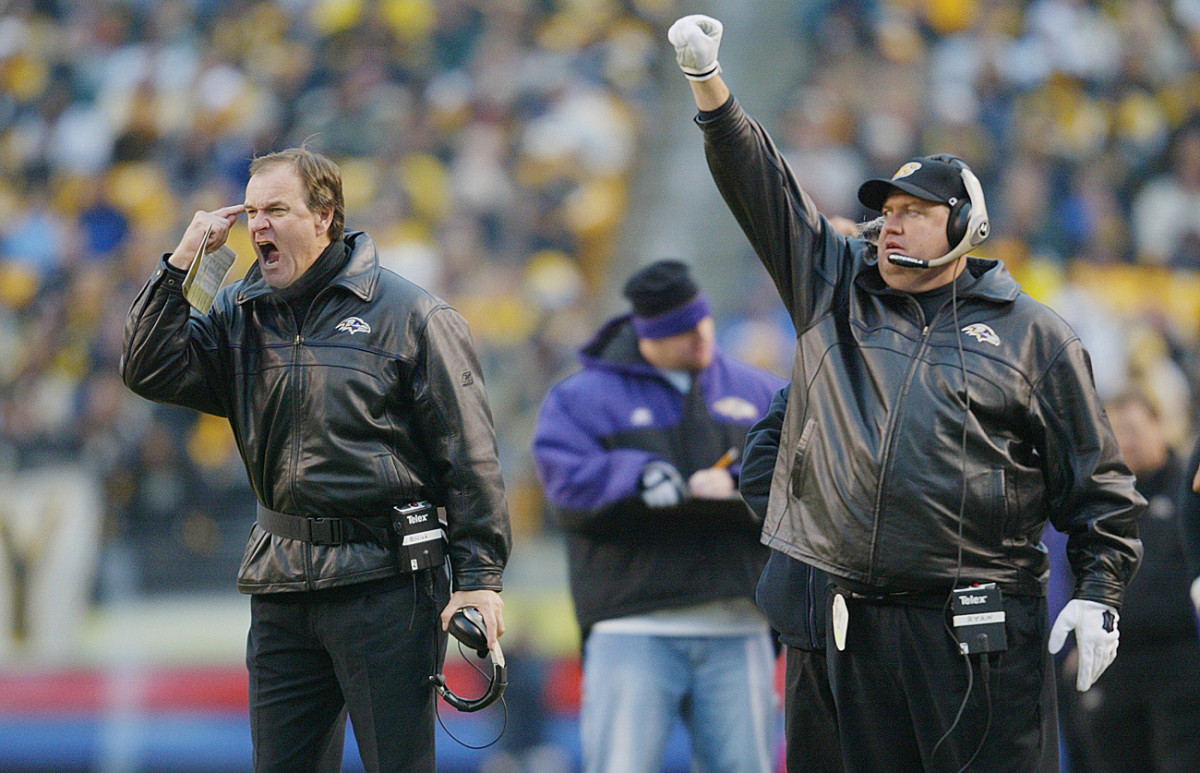
ED BOUCHETTE, Pittsburgh Post-Gazette Steelers beat writer, 1985- : I remember one time, this was at the old Memorial Stadium, so they had just moved not too long ago. The Pittsburgh writers requested a pool report from the referee. Baltimore refused to do it. So we wound up having to get the Steelers PR guy to bring us down to the ref. I have never seen that before.
STAN “THE FAN” CHARLES, Baltimore sports talk radio host, 1983-2001: When the Browns moved to Baltimore [in 1996], for the Modell family, Steelers week was a big deal right away. But I don’t think anybody in the city of Baltimore got that this was supposed to be our rival. They had never been our rival. The Steelers-Baltimore Colts rivalry was not a good one at all. The Baltimore Colts in their heyday didn’t overlap with the Steelers in their heyday. In those first few years [of the Ravens], the Steelers just came in and owned Memorial Stadium. You’d see nothing but Terrible Towels. But about four or five years later, Baltimore got it. These guys are going to be our rivals, because they are in our division, and this is sort of what we aspired to be.
There was a game played on Oct. 5, 1997, that shows up as a 42-34 win by the Steelers. What I remember is we were up, 24-7, at the half, and I was feeling like we had really arrived. Well, within five to 10 minutes, they took that game back over. They ran over our defense. But something was born in that game. Great players don’t take kindly to being mauled like that. I think Ray Lewis said, we are not going to be chumps anymore to these guys. The next year we started to play them close.
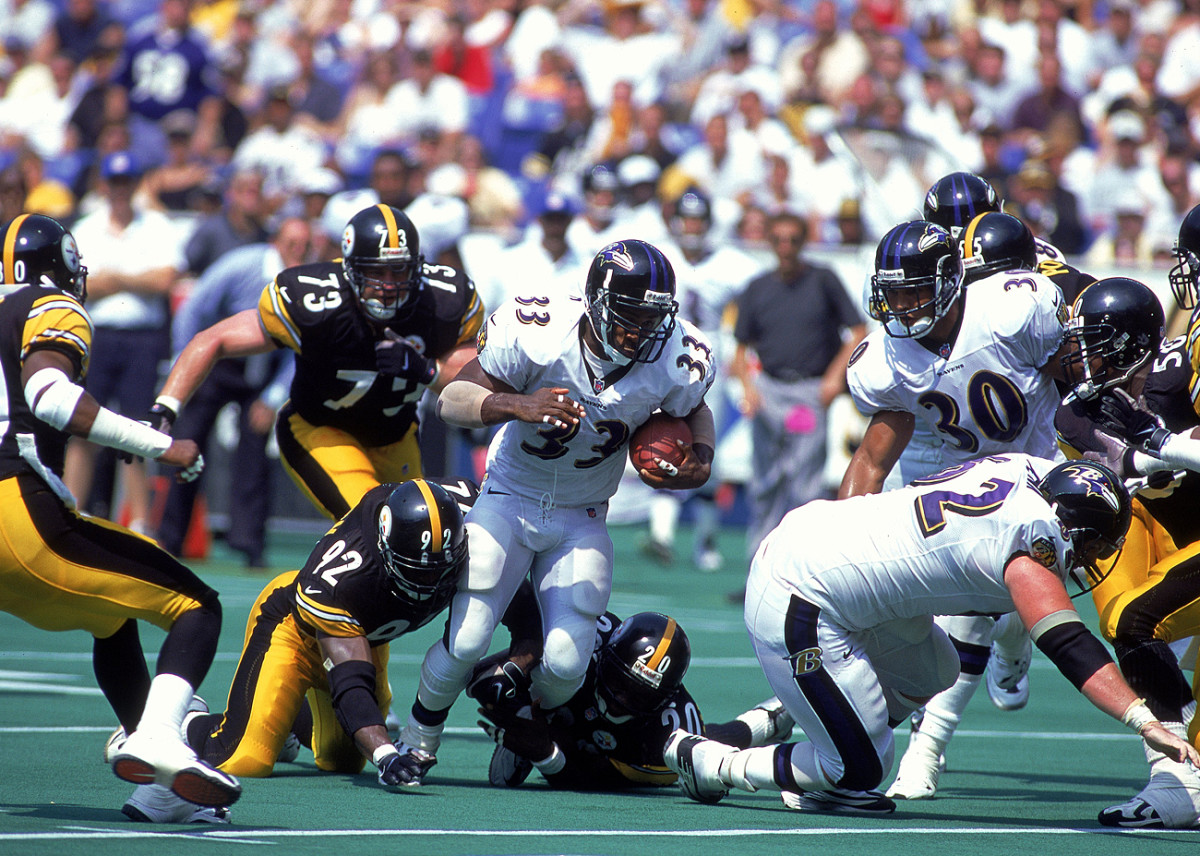
BILLICK: From an organizational standpoint, it had been [10 seasons] since they had beaten Pittsburgh, in Pittsburgh. They had no reference frame. But then in the 1999 season, we were able to win at Pittsburgh, and that was a big deal for us. And for Pittsburgh, it became real. It is not a rivalry when one team is kicking the hell out of the other team.
BOUCHETTE: After the Ravens won the Super Bowl in 2000, that’s when it really started taking off.
• JAMES HARRISON, THE (OLD) MAN OF STEEL: Tim Rohan profiles the ageless, and outspoken, Steelers LB
THE TIME JOEY PORTER CAME FOR RAY LEWIS
BOUCHETTE: Joey Porter was shot in the butt in Colorado when he was out there for a Colorado State game, so he couldn’t play in the Ravens game. He was on the sideline. Joey had a thing where he would kick his right leg [after a big play], and Ray Lewis did the Joey Porter kick. It just incensed Joey. He tried to go after Ray when the Ravens were leaving on the bus. We didn’t find out about it until later.
KEVIN BYRNE, PR chief, Browns-Ravens, 1981- : Ray was on Bus 1, toward the back. Joey comes out to the bus area, a few guys with him, yelling, “Where is Ray Lewis?” I am in the third seat from the front. Ray gets out of his seat, and I said, “Ray, we are not doing this.” He says, “I’m not leaving the bus, but I am going to let him know he’s an idiot.” He yelled at Joey, “Time to grow up! Leave the fight on the field.” And then he went to sit down.
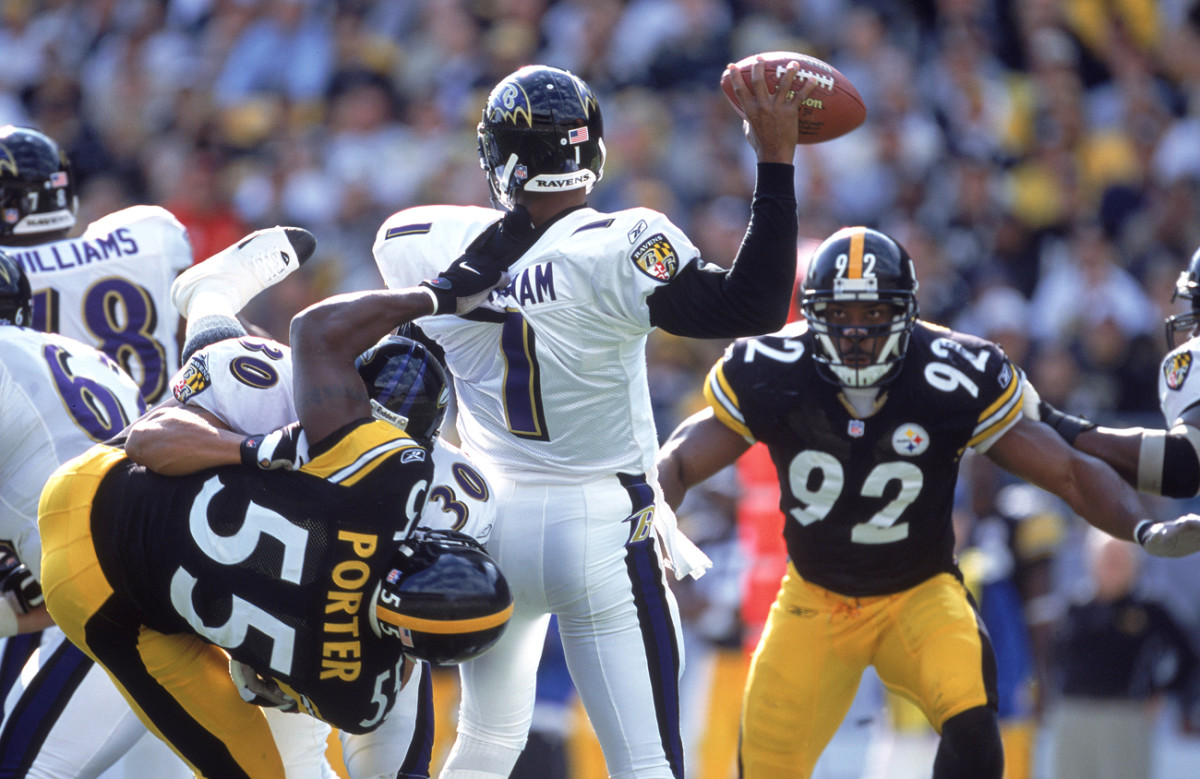
SCOTT: Joey was angry because Ray had said something like, I’m praying for you. Joey thought Ray was being sarcastic. How could anybody on the Ravens be concerned with a Steeler? A younger Ray would have gotten off the bus, but he was already making the transition to “Reverend Ray.” He didn’t get off, but yo, we were ready to ride. You cannot make this s--- up.
THE INDOCTRINATION TALES
COLON: My first career start was against Baltimore [in 2006]. So I got baptized right away. It was around Christmastime. It was cold, and I was the youngest guy on the line, and I didn’t know my ass from my elbow. I was going up against Trevor Pryce, and Trevor Pryce is about 6’7”. He’s just a monster, and if you asked anybody about Trevor Pryce, he used to have this rip move that was like the most unstoppable rip move in America. Like, I don’t think anybody could stop it. I had practiced all week for this rip move. And Russ Grimm, our offensive line coach at the time, he was really trying to tell me, this guy is a load. You have to put your big boy pads on to play this guy. So we get out there, and the first play is a pass play. Pryce hits me with the rip move, rips me right by my face, and he knocks Ben down. And I’m like, Oh my god. I look to the sideline, and they look mortified. Like, what did Willie just do? Got up, obviously, and kept going.
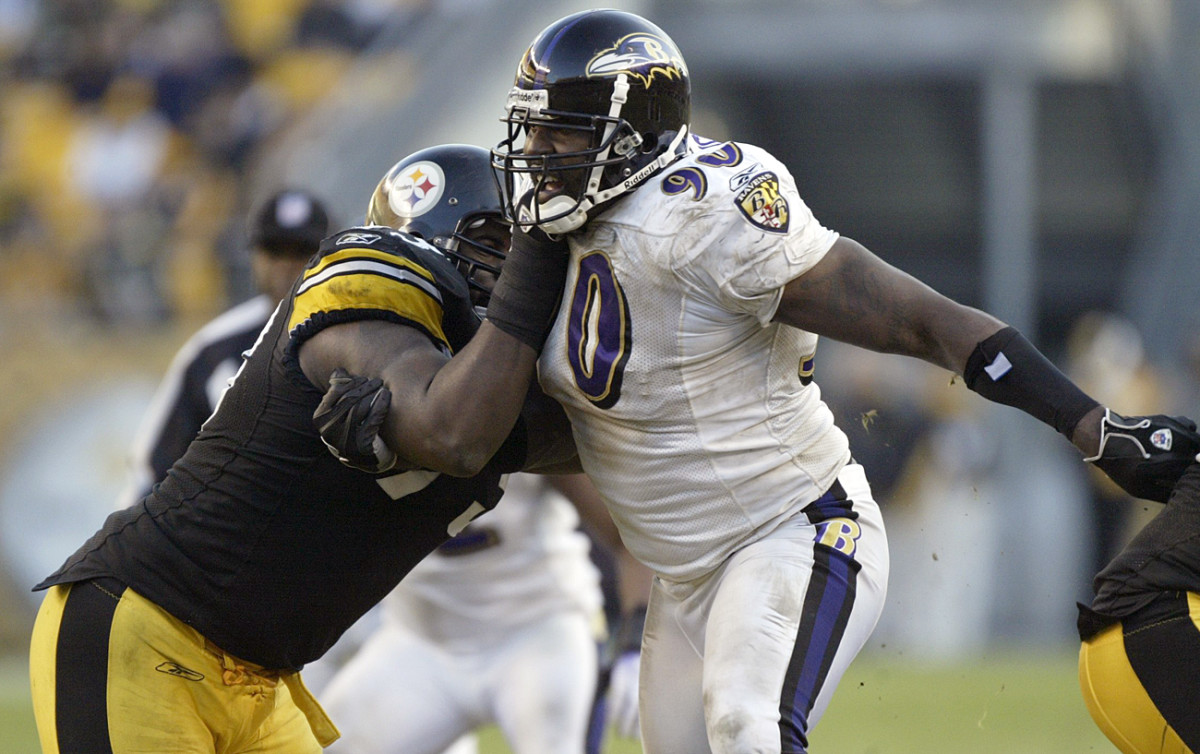
BRETT KEISEL, Steelers defensive end 2002-14: Going up against [Ravens left tackle] Jonathan Ogden was literally like trying to push a house backwards. He was a mountain. We would never talk a lot of trash. I remember as a younger player I made one play where, I was just supposed to be in the B gap, and the running back ran into the B gap, and I thought it was just amazing that I made a play against this guy. And he was like, “Dude, you were in a 4-technique. You were supposed to make that play.” So it gave me some humble pie.
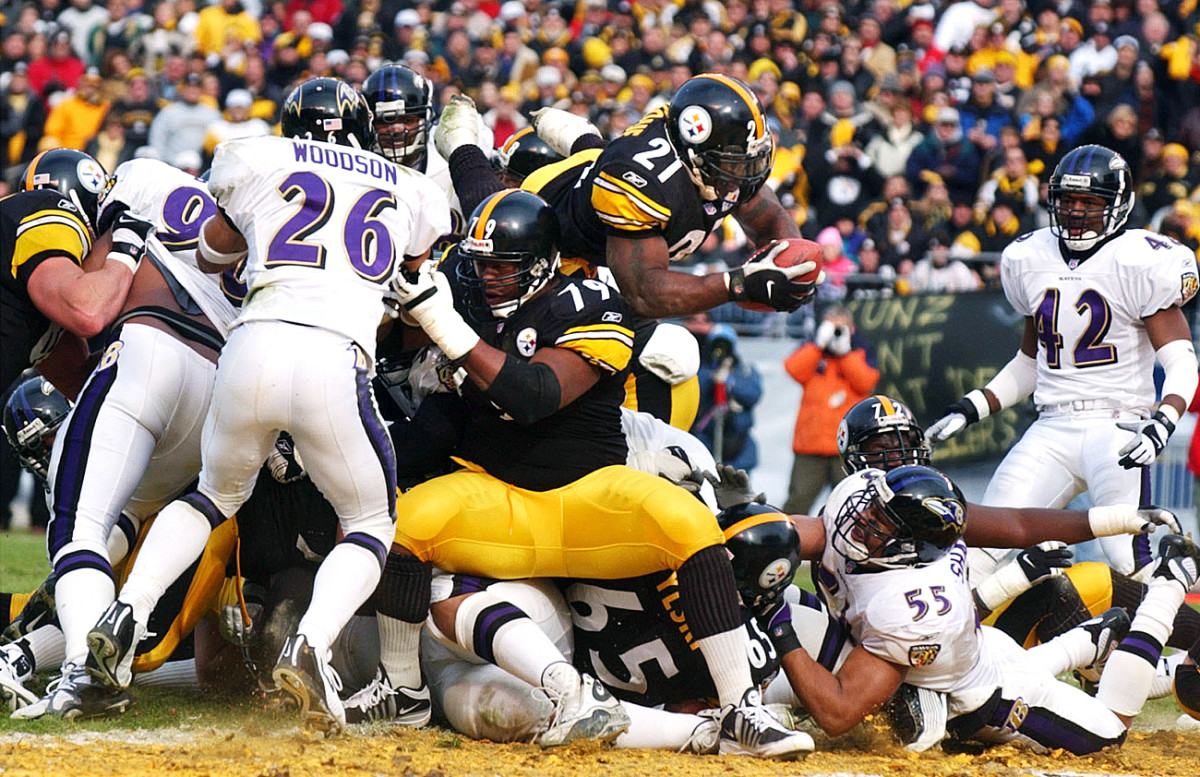
SCOTT: My introduction to the NFL on a grand stage was against the Steelers. Halloween Day 2005, Ray Lewis was out for the year with a hamstring injury, it was my first start and the world was watching. Everyone thought, who is this guy with a No. 57 jersey on? What a joke. Look for the Steelers to run the ball up and down the field vs. the Ravens. Rex [Ryan] put in a defense called the Hawk defense, and he catered it to my skill set. It was basically for me to sit nine yards off the ball, and he had a shift where the DTs lined up two yards off the ball. We never played it before. It was an old college option defense. I played free safety in college, so it was a hybrid free safety-linebacker spot, and it allowed me to be a free hitter. That game that kind of launched my career, because I never sat on the bench and didn’t start again.
BYRNE: Ingrid Harbaugh, John’s wife, went with us to a game a few years ago where we won, in the regular season. When we left the stadium it was darker outside. John and Ingrid were sitting in the front of the bus, and Ingrid looks out the window and says, "Look, there is a grandmother giving us the finger." And John says, "You haven’t seen anything."
• THE WIDE-OPEN MVP RACE: Peter King evaluates this year’s top candidates
HINES WARD, TONE-SETTER
COLON: Hines was kind of our arrow. He would run a route and come back, and guys would be pursuing the ball, and he would just clean ’em up. He would just crack them from the side. Baltimore used to consider him extremely dirty, which was an edge for us. A lot of times they worried about where Hines was at, rather than focusing on the game at hand. And he used to always get into it with Ray. He cleaned Ray up good one time, and Ray lost his s---. It was funny. Because you never expected it out of a 5’11” receiver who had a smile like a gremlin. They would try to kill Hines, and he would just get up and smile. The harder you hit him, the harder he smiled. Maybe it was more of a grimace, but he never let them know they hurt him.
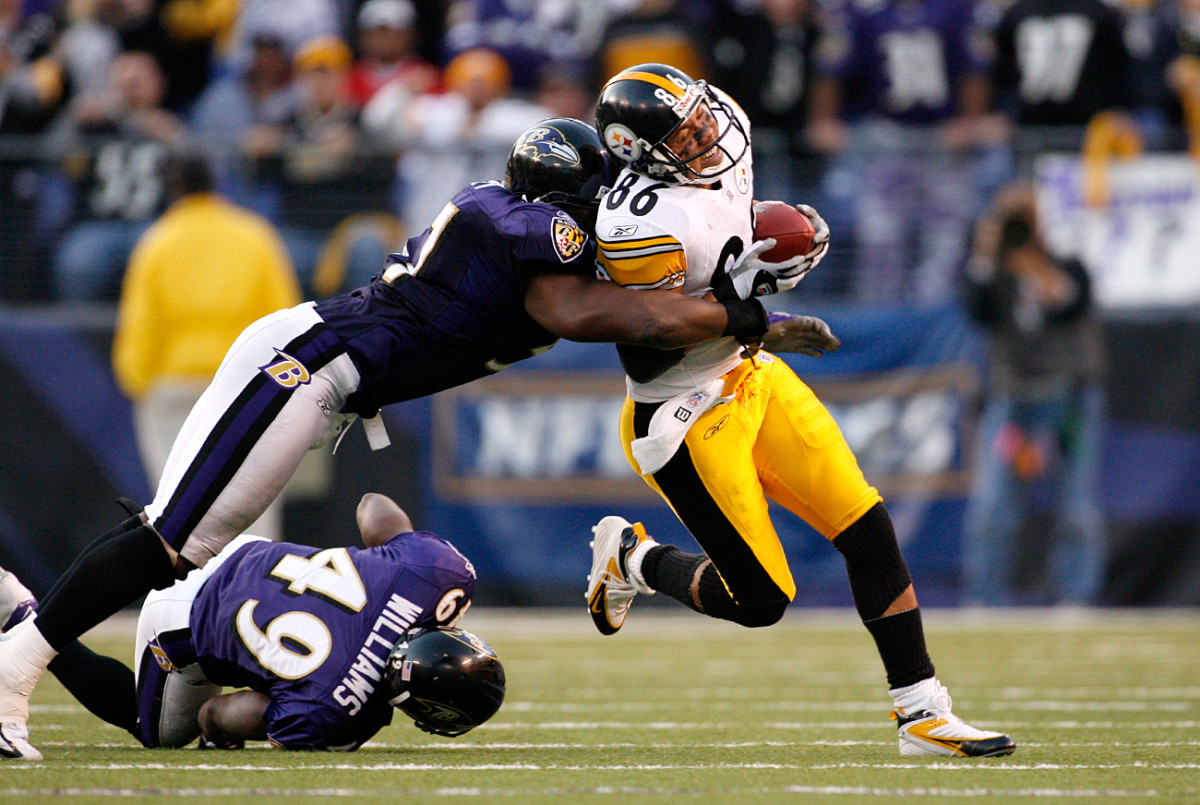
WARD: The rivalry made my career. When Ed Reed came into this league [in 2002], everybody was saying, this guy is the best safety in the game. So I took that personal. There’s this guy who is going to be known as the best safety in the game today; well, he is going to know who No. 86 is after the game is over with. Every time we faced him, I made it a point to let him know he is in for a long day messing with me. And vice versa. They would trash talk me, and I would just give them a smile, just smile big, and for a while I think there was a little bounty on me to knock the smile off my face. So I didn’t wait around to be the hit guy. I always took the approach, hit them before they hit me. That was always my motto.
SCOTT: I did try and kill him. I wanted to, in a football sense.
BILLICK: Hines Ward pissed me off because he was so good and so physical. But I would have loved to have the guy.
WARD: There was a playoff game [Divisional round, January 2011], and on the first play of the game, Coach Tomlin came over to me and said, hey, you need to set the tone for this game. On the first play, I go after Ed Reed, knock him to the ground. I got my forearm on his neck. I am on top of him. Next thing you know, I’m getting beat up by three Ravens players, and they pulled me off of him. I get the personal foul flag thrown on me. I’m thinking it’s going to be offsetting, and alright, let them know we came to play, but I ended up getting the flag throw on me. I looked over at the sideline and Tomlin is like, Good job. That was the first time I have ever heard a head coach say good job on a penalty on the first play of the game.
RASHARD MENDENHALL MEETS RAY LEWIS, SEPT. 2008
RASHARD MENDENHALL, Steelers running back, 2008-12: I am a rookie, 21 years old, getting ready to start for the first time. I’m focused on remembering the plays. All of a sudden I get a call from the Steelers [PR staff], and they’re saying I need to have an answer to this. I read the news story, and I’m like, wow. All of that about me texting Ray Rice before the game and talking stuff about the [Ravens] defense and Ray Lewis, saying I was going to have a big day, none of that ever happened. It was conjured up. I didn’t even have Ray Rice’s number.
ESPN Broadcast, Mike Tirico: Only a 10-point game, they need to establish some offense. They put Sean McHugh, the tight end back there at fullback to lead for Rashard Mendenhall. A little line up and show ’em what you’ve got. The problem is, that’s lunch for these guys. They love that.
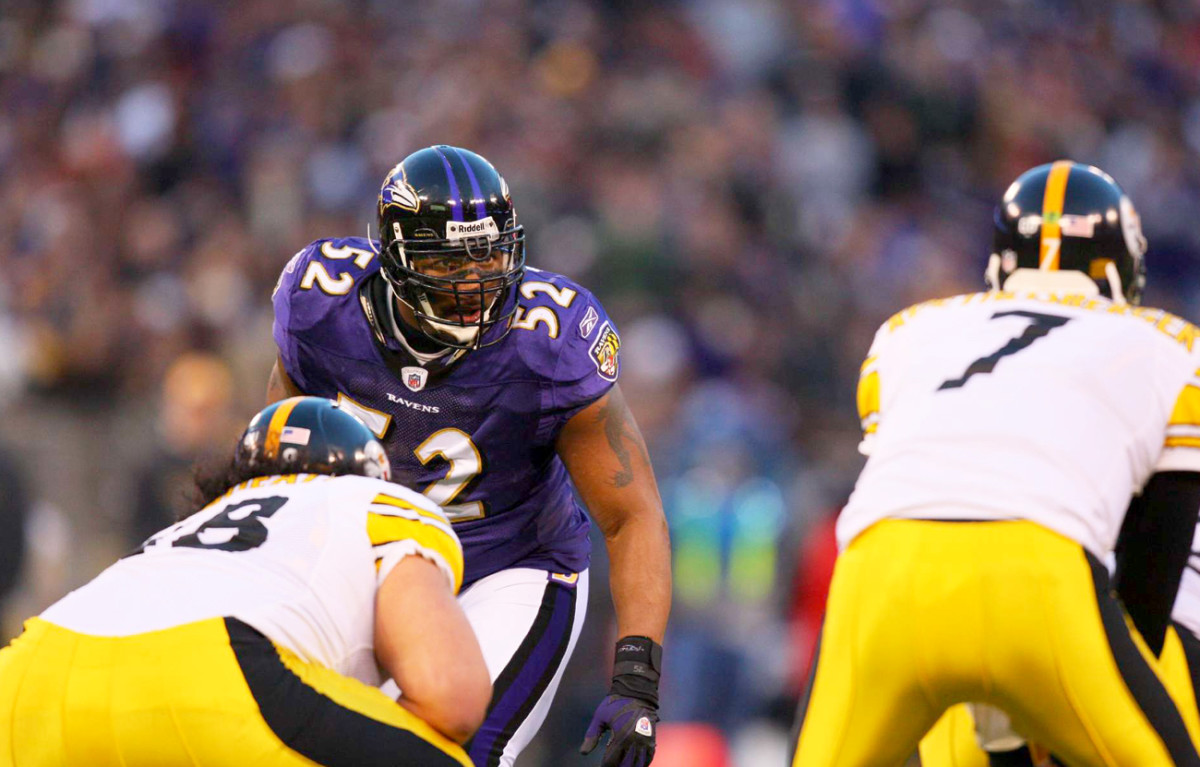
PRYCE: All I remember is hearing [what sounded like] a gunshot. And then I looked around, and Rashard Mendenhall’s arm was hanging off of his body.
COLON: I think we were running a dive play, and it just so happened, the hole split wide open. Like you could just put a Mack truck through it. And he and Ray Lewis were one on one, going right at each other. I could hear on the side of my helmet, crack. I popped up and was looking around. I just saw Mendenhall grab his shoulder and run off the field. And Ray was going crazy. He sounded like a WWE wrestler.
MENDENHALL: I remember getting up, and I wanted to go back to the huddle, but I knew something was not right. I ran to the sideline with my shoulder hanging down. I couldn’t even hold it up while I was running, but I didn’t want to show anyone. I went to the X-ray room, and they said, yeah, your scapula is fractured. The hit wasn’t a bigger or crazier hit than normal, but the impact was all at one point, and that was my scapula. The doctors even said it was not a familiar injury in football, but something they usually see in car accidents. So that ended my rookie year.
I saw Ray later that year at the Super Bowl, and he was really cool. He said he didn’t mean to do it, and he had prayed for me. We built a professional respect from there, a running back and a linebacker playing two to three times a year, year after year. We had a play, 22 double, where the whole line is double-teamed, so I’m reading the “Mike” linebacker as I’m pressing the line of scrimmage. I don’t make my decision until the linebacker makes his decision. I’m watching Ray, and whichever way he goes, I’m going the opposite way. I’m holding up until the last second, and he’s holding up until the last second. And we’d be looking eye to eye.
A few weeks later, on an Atlanta radio show, Suggs said “the bounty was out” on Mendenhall and on Ward, “we just didn’t get him between the whistles.” Suggs quickly backtracked from the comment, denying the existence of any bounties, and he also received a warning letter from the league.
PRYCE: That is some of him being a professional wrestler, the WWE nature. If you want somebody to sell a football game, ask Terrell Suggs. Especially back then. The T-shirts would come out, and the middle fingers, and the this and the that, and I was like, what is that? But there was no bounty, I can tell you that right now.
SUGGS: I don’t know about no bounty. I don’t know where you get that from. We just play football. (Laughs).
‘SOMEBODY IS GOING TO DIE TODAY’: AFC CHAMPIONSHIP GAME, JAN. 2009
BRIGANCE: I remember the anxious anticipation of the next and most significant chapter of the Ravens-Steelers rivalry. From the opening coin toss, standing midfield with my former teammate, Tony Siragusa, you knew it was going to be a physical battle. The stands were electric. For us to win, we had to play our best game, with minimal errors. Joe Flacco had been playing exceptionally well and would face his greatest test of his young career against the league’s top defense. It seemed like an uphill battle, but the men were up for the task.
BYRNE: They gave us stickers that you had to put on your pass to get on the field. We all had official passes, like our head coach for example, and they said we also had to a have a sticker. The security guy is putting them on, and John Harbaugh sees what the sticker is. It’s a jackass. A laughing jackass. Harbs tells him, stop, we are not doing that. He takes my official pass in his left hand, and with his right finger, starts scratching it off. “They are not going to make jackasses of us,” he says.
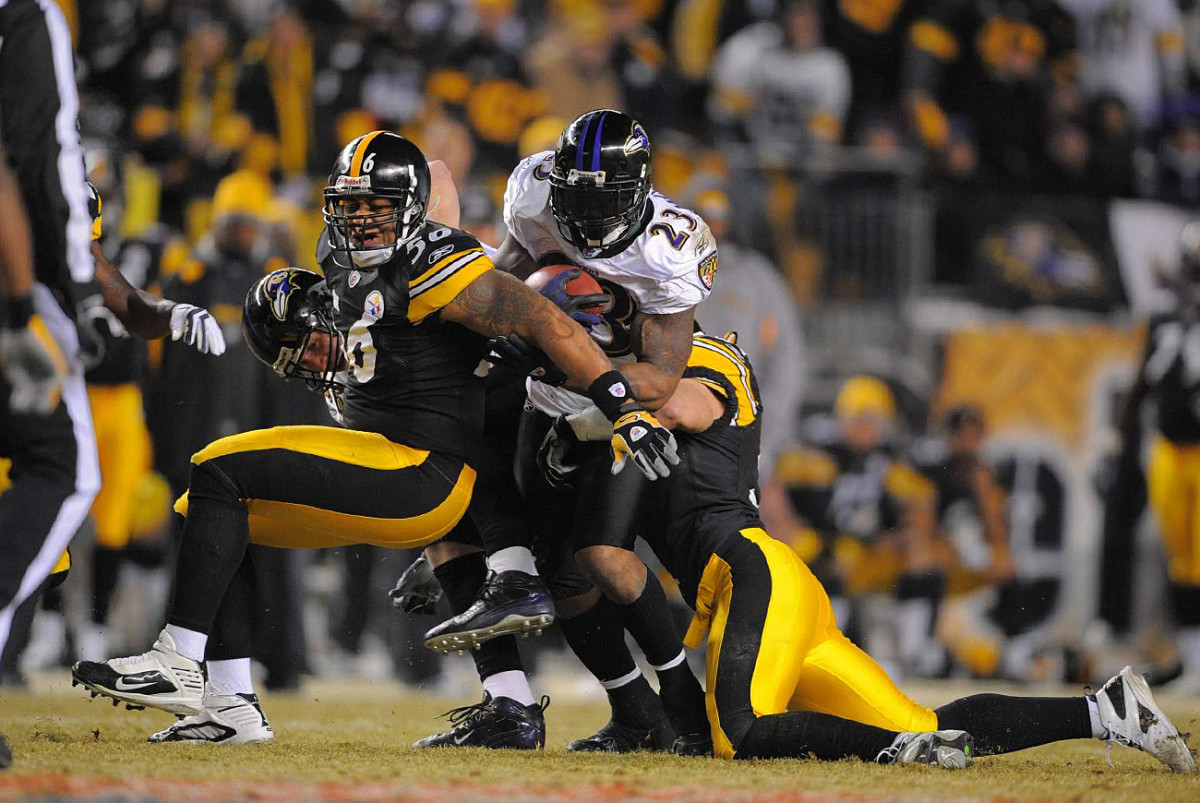
Now, we go down to the field and they have a defensive tackle-sized security guy with a long ponytail who stops John and me. He says you can’t go on the field without an official pass and sticker. John says, “We’re not wearing the stickers,” and the guy says, “Then you’re not going on the field.” I said, “Come on, you know who he is.” Our honorary captain that day was Tony Siragusa, and I see him down there and yell down, “Hey Tony, we have an issue. The security guy is not letting us on the field.” Tony says, “You got a problem, pal? These guys are going on the field.” Tony was slightly larger than this guy. So we went down on the field. And the next time we came out, they had replaced the ponytailed guy with another guy.
COLON: I can always remember this. I was going against Haloti Ngata. We both prided ourselves on being bullies. Pushing a guy past his will; breaking a guy’s will by the end of the game. Going into the AFC Championship Game, it was this feeling I will never forget. We got the ball to start the game, and I locked eyes with him, and he locked eyes with me. He just gave me that nod. There was no verbal communication. It was just a nod, like, somebody is going to die today. That was the agreement we made. That we were going to go to war. We were going to empty the clip on each other, and whoever was able to get off the field was going to be the winner. At the end of the game, there was no talking. He just walked up to me, gave me a head butt, and he walked away like, Alright, bro, you got this one.
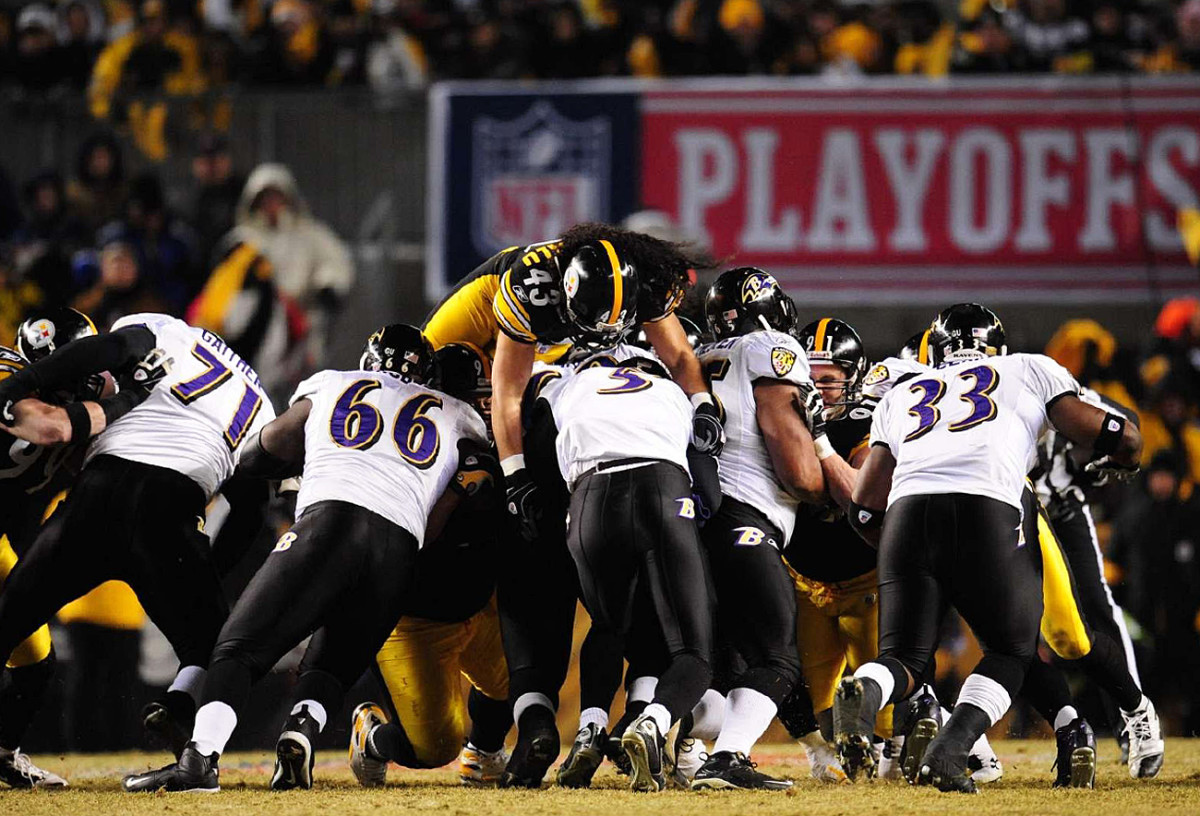
CBS Broadcast, Jim Nantz: “Picked off, Polamalu. Polamalu, going right. The field is open. Aaron Smith shields [Joe] Flacco, and Polamalu takes it home. Super Bowl XLIII, Pittsburgh might be bound for that, thanks to No. 43.”
TOMLIN: When Troy picked that ball off, against Joe late in the AFC Championship Game, and the building was literally shaking, it was one of those moments that you’ll remember forever.
KEISEL: It is the only game I have ever watched film on where the film itself is actually shaking.
RYAN CLARK, Steelers safety, 2006-13: Troy ran the other way, and I was mad because I didn’t get the glory of my block. To me, it’s the most important play in the rivalry. It sealed the deal for us to go to the Super Bowl, and it was a big play in a big moment of a big year by one of the all-time greats.
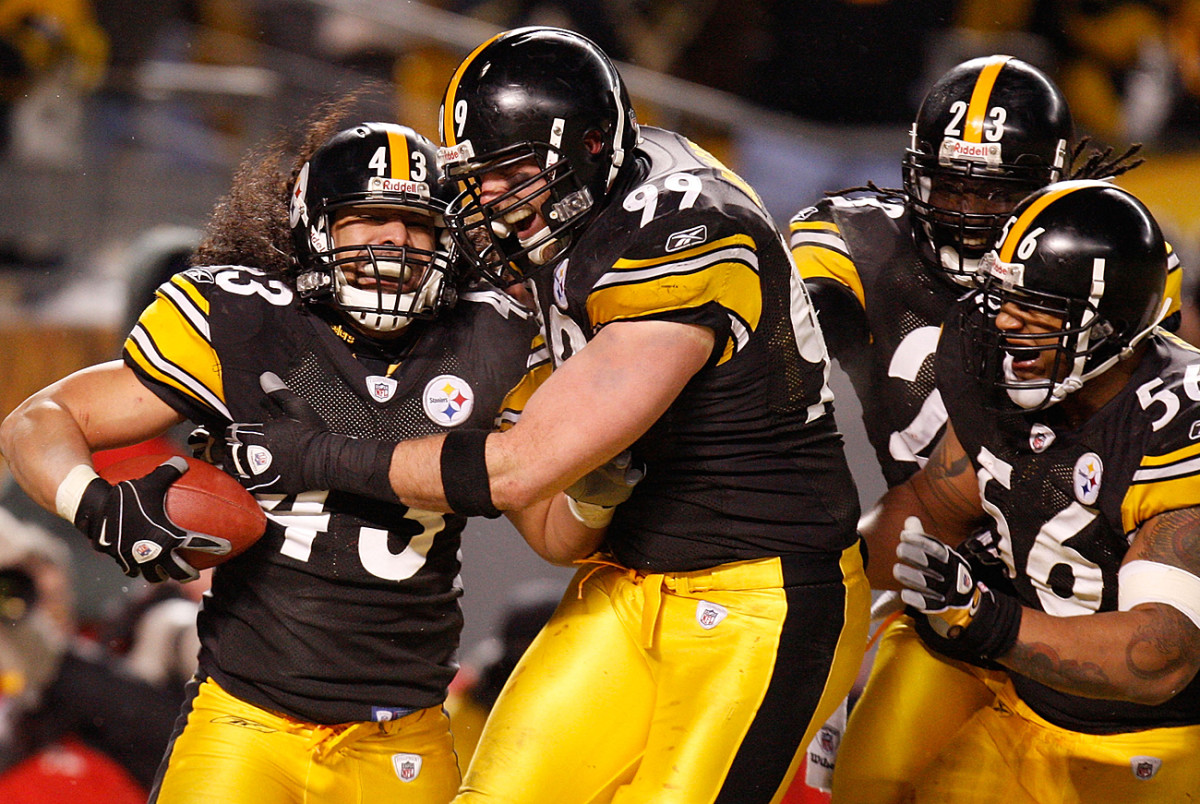
BRIGANCE: It was heartbreaking!
SUGGS: It stung. It was very much an insult to injury. From that year on, it was like everything we did was to beat the Steelers.
THE WILLIS MCGAHEE HIT
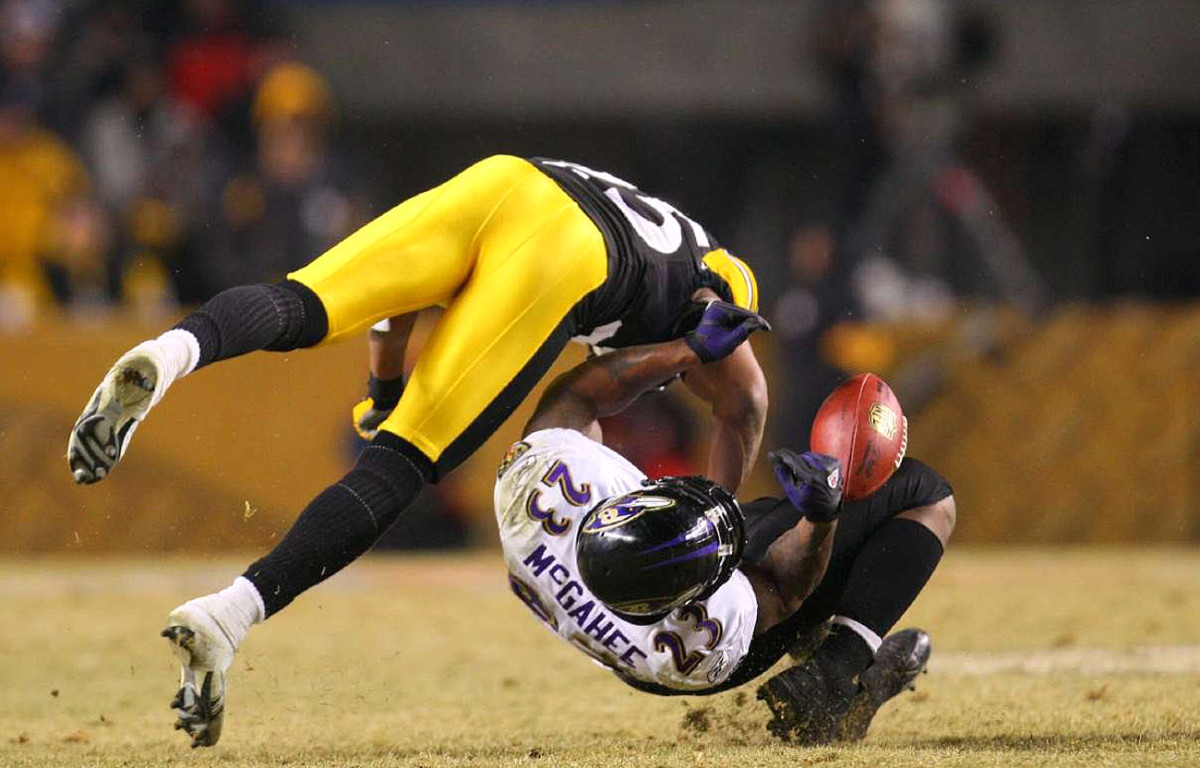
CLARK: The next thing that happened after Troy’s interception was me hitting Willis McGahee. The week before, the San Diego Charges ran the same play against us in kind of the same situation, the two-minute drill, and Darren Sproles runs kind of a short post route up the middle, catches the ball and splits Troy and me. We got in the same situation. Willis McGahee moves to the left side of Joe Flacco, so I tried to give him the same look that San Diego had, hoping they ran the same play. I was in quarters coverage, which means my quarter of the field extends from the hash to the numbers. But I wanted to give him the look like I was in half-field coverage. When I saw Willis come out, I said, you know what, I am going to start running at him, and I am not going to stop until I hit him. That was basically what it was. There is a saying in football, don’t blink. Don’t get to the point of attack and blink, go through him and finish the play. That’s what I did. And he kind of just didn’t move.
PRYCE: I remember Willis lying on the ground with his arm up in the air. And I remember saying, I think he’s dead.
COLON: He pretty much put him on a stretcher to end the game.
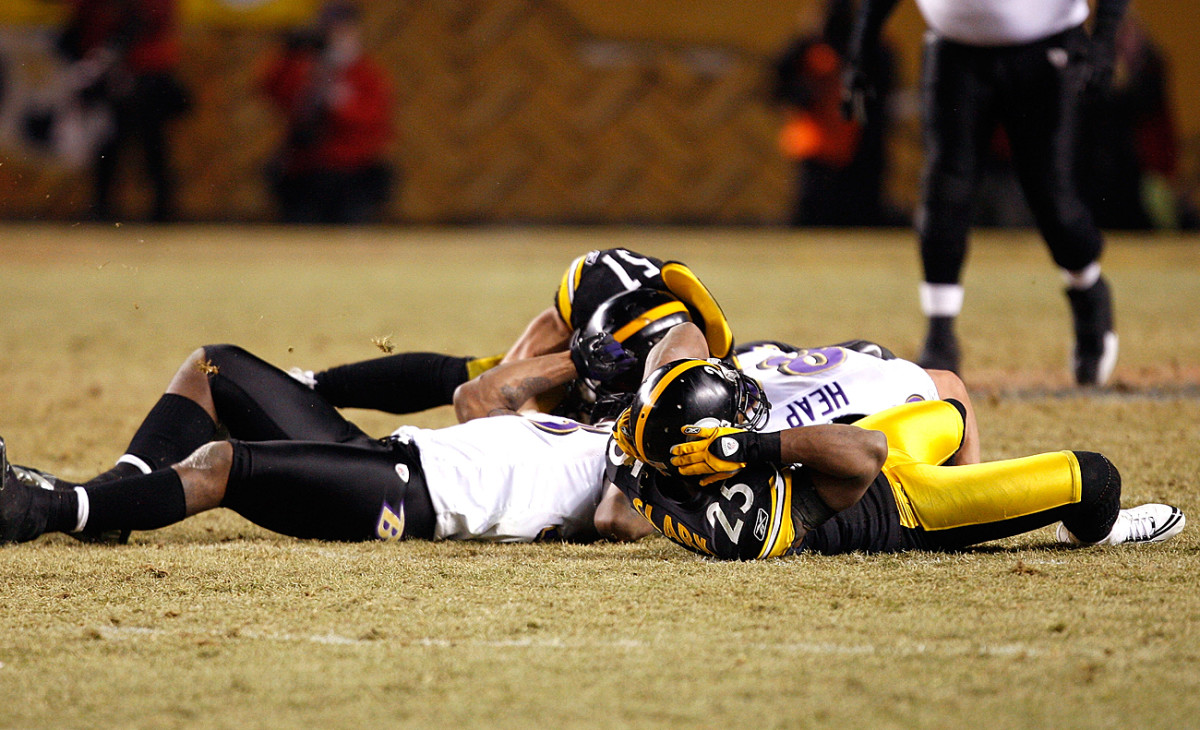
KEISEL: That’s the hardest hit I have ever seen, and I told Ryan that when it happened.
CLARK: I just remember getting up and walking off the field and asking, did we get the ball? [McGahee lost the ball on the hit. The officials ruled fumble, and the Steelers recovered.] That was pretty much all I was concerned with. And after that, I was just happy we had won the game. I saw him later, that summer. There was nothing to talk about. It’s football. I was glad he was alright. And other than that, life goes on. It was like, hey man, what’s up? I’m good, how are you? Want a drink? That’s pretty much how it goes. We understand what playing football is about.
That is the play that symbolizes what people felt like the rivalry was about. It was about physicality. It was about imposing your will on somebody else. As my career went on after that play, there were a lot of hits that looked nothing like that, or that you couldn’t even debate whether or not they were legal, they would call flags on just because of that play. Because of what that play looked like. Because of what the world saw it as. I think that play, and many others like it from the Pittsburgh Steelers during that time, were huge reasons why a lot of these rules were changed. I think people in Pittsburgh, people involved in the rivalry, actually take pride in it. They take pride in the fact that those teams we had were part of rules changes. That, because of the way we played the game, they had to legislate some of that physicality out of football.
THE $100,000 FINE, DEC. 2013
NBC broadcast, Al Michaels: Fielded at the goal line by Jones. Jacoby Jones gets by Suisham and taken down at the 27-yard line. Only Cortez Allen stood between Jones and the goal line.
Cris Collinsworth: Oh, here we go, here’s Tomlin over here. Tomlin is essentially on the field here and you just wonder—he’s trying to get out of the way there—but did that force Jacoby Jones to lean back in to the tackle by Cortez Allen. Don’t want to in any way say that was something intentional, but if he had picked off the official on that play or touched the player, either way that’s a big penalty. He is looking the other way but glancing back over his shoulder. You can see he kind of did force Jacoby Jones back into the field. A little mission accomplished, almost. And he is snickering. I mean, you know, my man, he is a player now.
The NFL subsequently fined Tomlin $100,000, the second-largest reported fine given to a head coach.
TOMLIN: I don’t remember much about it, other than the fine. I am still a little hacked off about that.
THE STORY THAT IS NOT A LIE
SCOTT: We are losing big in Pittsburgh one year, and I was known for always going to the opposing sideline during timeouts. I am arguing with Dan Kreider, the fullback then, in front of Mike Tomlin. Tomlin has his arms crossed, listening. So I say, “Coach, he’s talking a lot of s---. Put him in the game, and run an iso, and I bet I knock his ass out.” So, Tomlin asks Kreider, “You want him?” He says, “Hell yeah, I want him coach!” Tomlin uncrossed his arms, threw his hands and pointed for it. Now Kreider is running in mad. He’s putting his chin strap on. I run out, and lo and behold, he runs the play. The down block came in, and I hit him, “pow!” and I tackle Willie Parker at the same time. Kreider jumps up too fast, runs to the sideline, but he only made it back to the numbers before he collapses. They had to call a TV timeout.
I do a financial literacy program, and I have been at the Steelers facility and told that story, and the people at Morgan Stanley thought I was embellishing. But you can ask Tomlin. That’s when I became a fan of Mike Tomlin, and he became a fan of me. He said he was going to run the play, and he gave us what we wanted.
TOMLIN: I will never confirm. But Bart is not a storyteller.
THE NEXT CHAPTER
PRYCE: Of the people that lived that mid 2000s-2010 rivalry, it is basically a QB and an outside linebacker left. Suggs and Joe, and Ben and James Harrison. It’s kind of like the Florida State-Miami rivalry. There’s the height of it.
COLON: Of course I am going to look from my perspective and say it can’t be better than Hines Ward and Ed Reed and Ray Lewis and Haloti Ngata and Aaron Smith and James Harrison and James Farrior and Ben Roethlisberger. But I’m sure when the tape rolls this Christmas, it is going to be a bloodbath like it was then.
BRIGANCE: The rivalry continues to evolve with different players, but the hatred remains the same. It’s the Hatfields and McCoys, NFL style.
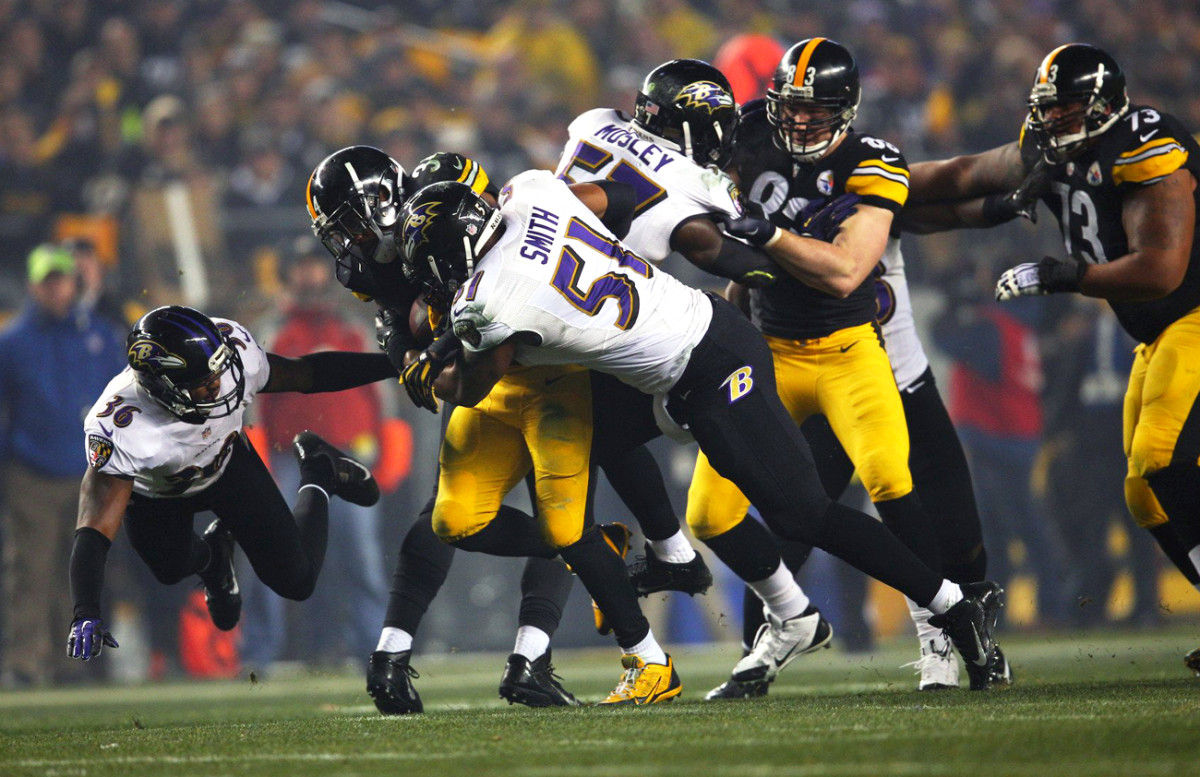
JOHN URSCHEL, Ravens offensive lineman, 2014- : It was intense from the time we walked out onto the field. Night game, Pittsburgh, Heinz Field, fans on top of you. The way I'd describe it is the heat from the fans just exuded onto the field. You could feel the entire stadium hate you. It was nothing like I've ever felt. I've played at the Horseshoe (at Ohio State), at Alabama ... nothing like this. They just hated us. There was fire coming from the stands. The stadium just kept rocking. The towels, the noise, the heat. I watched this game growing up, the Ravens and Steelers, and obviously you see the great rivalry. But I felt it then, and it was amazing. It’s intense, just intense.
That was the AFC Wild Card game in January 2015, the fifth-round draft pick’s first start in the rivalry. It was also the first Ravens playoff win versus Pittsburgh. Told about the intensity of years past, and how a cast of many hit people harder than they are ever supposed to be hit, Urschel already knew the legend, and couldn’t quite grasp it.
URSCHEL: I've heard that from some guys around here. That’d be amazing.
* * *
A RIVALRY IN PICTURES: STEELERS-RAVENS THROUGH THE YEARS
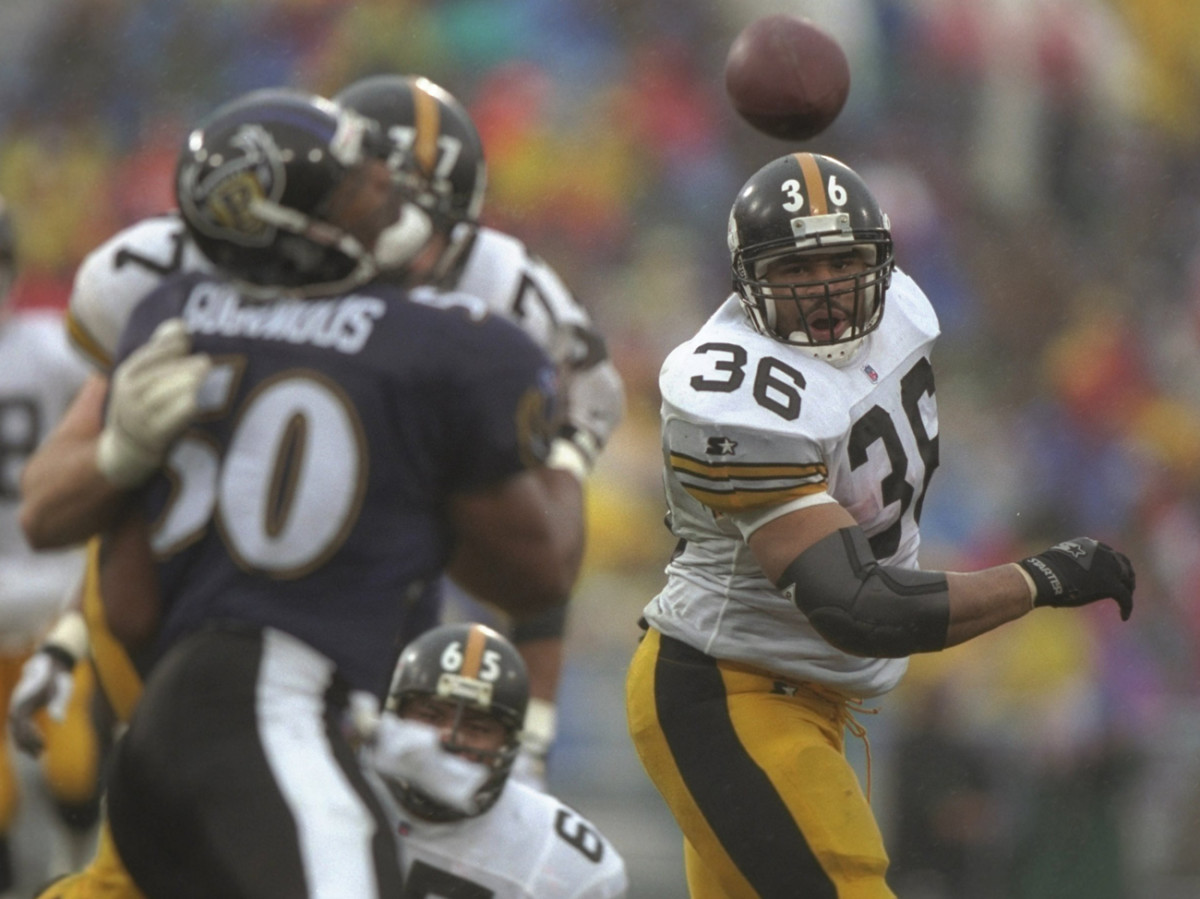
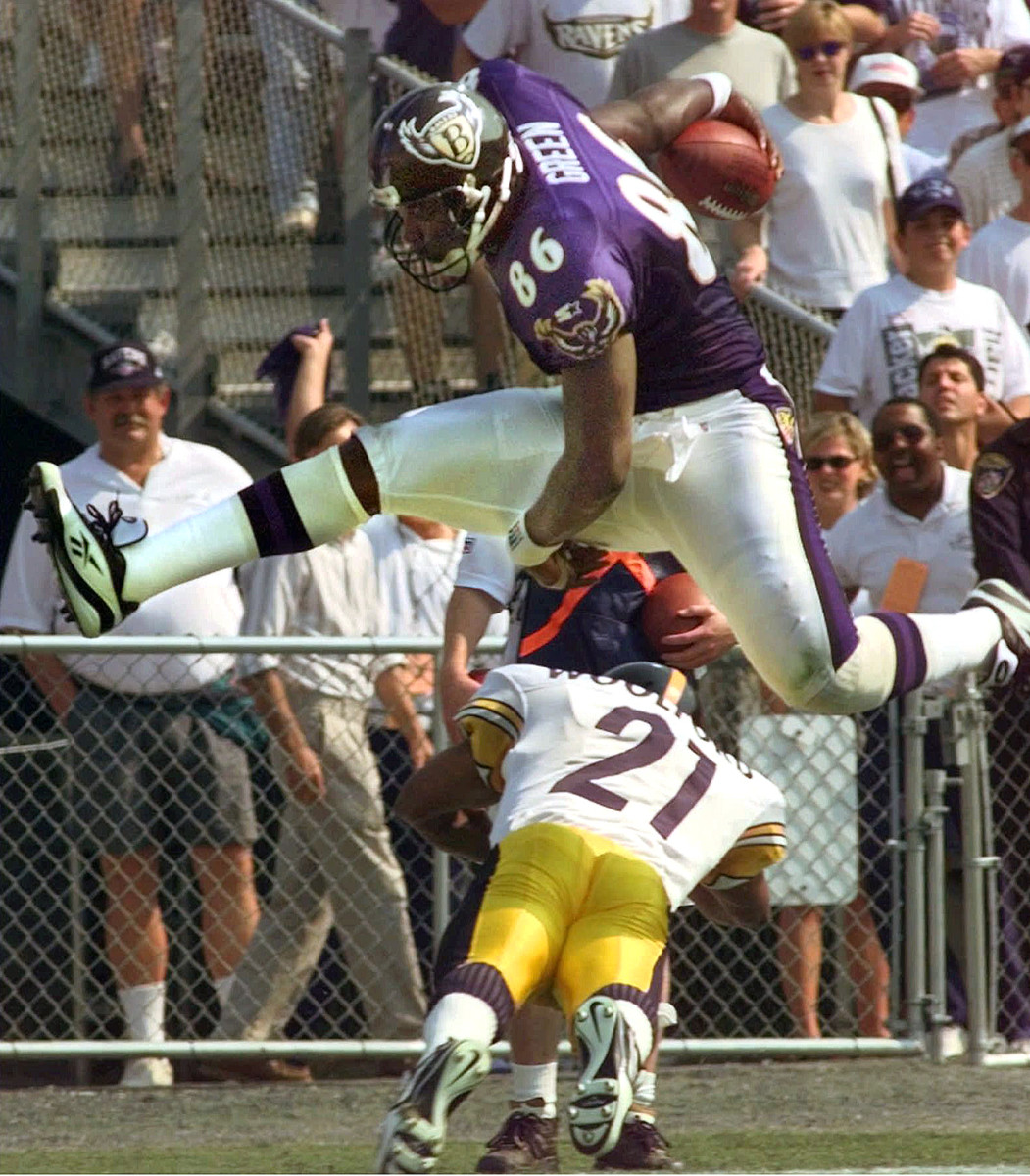
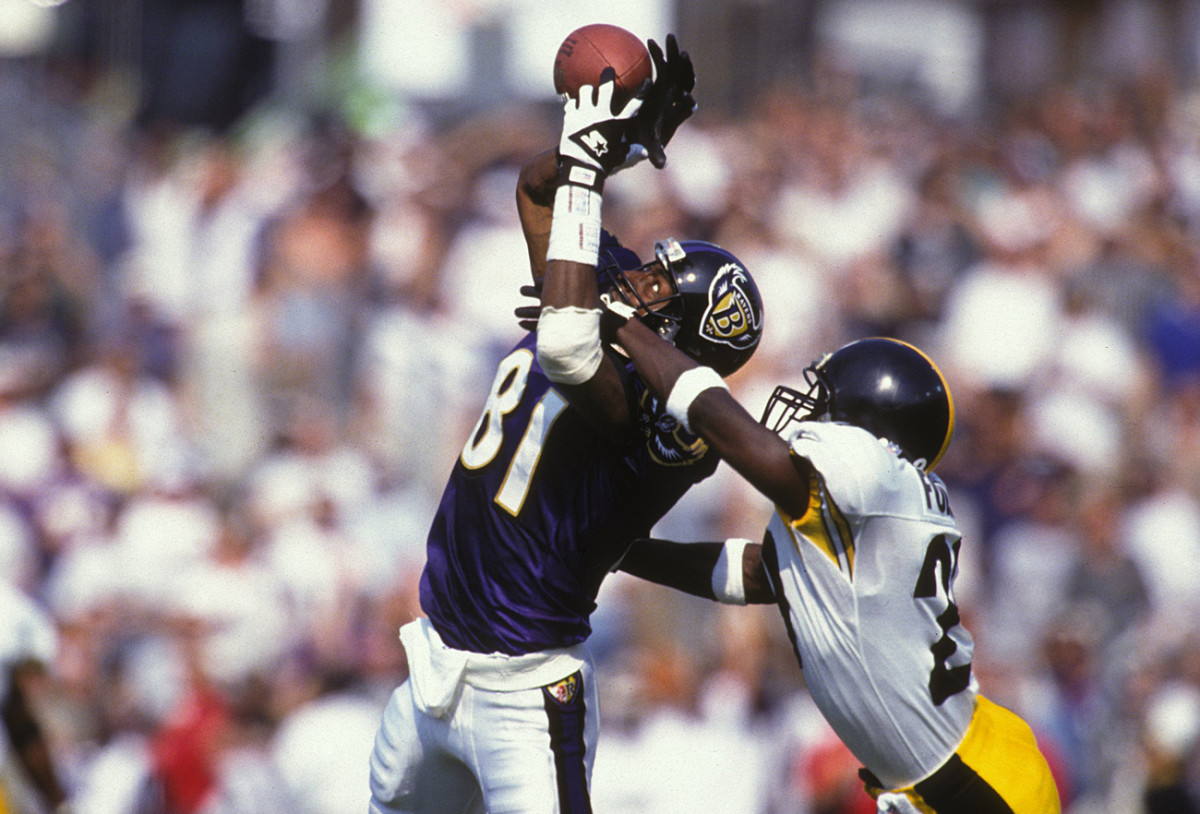
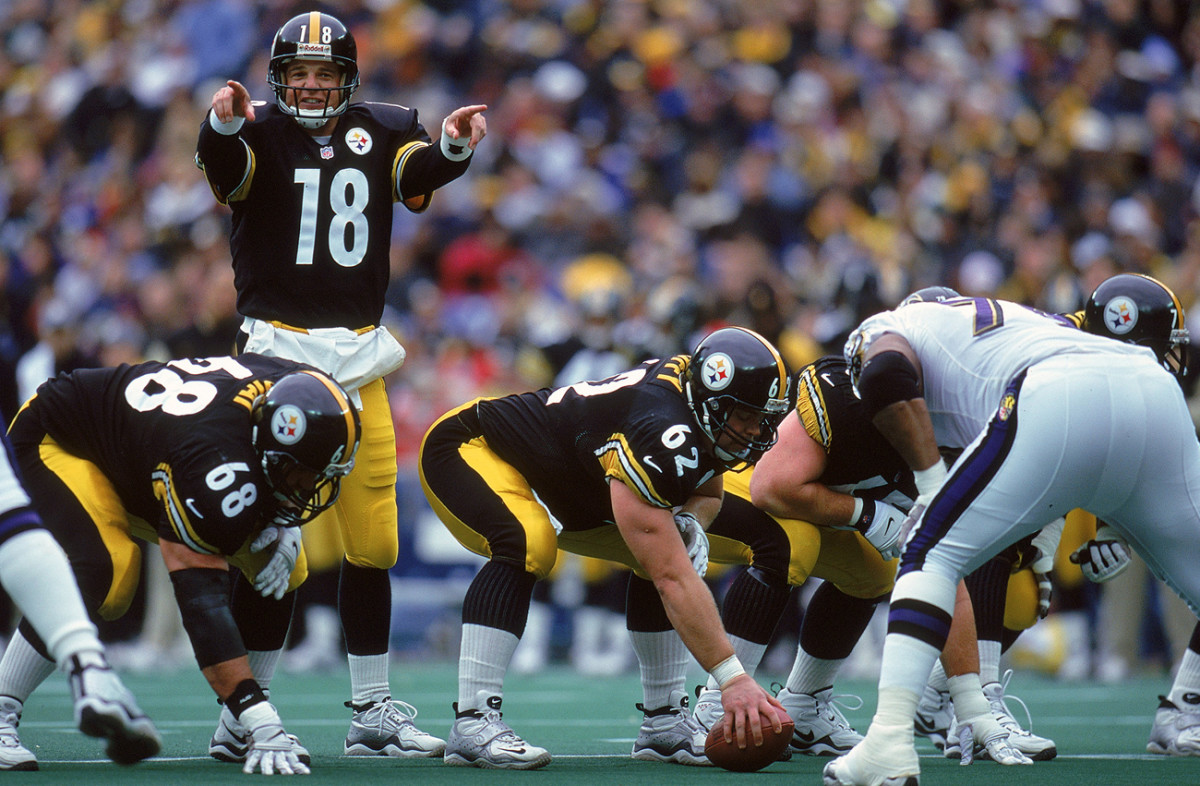
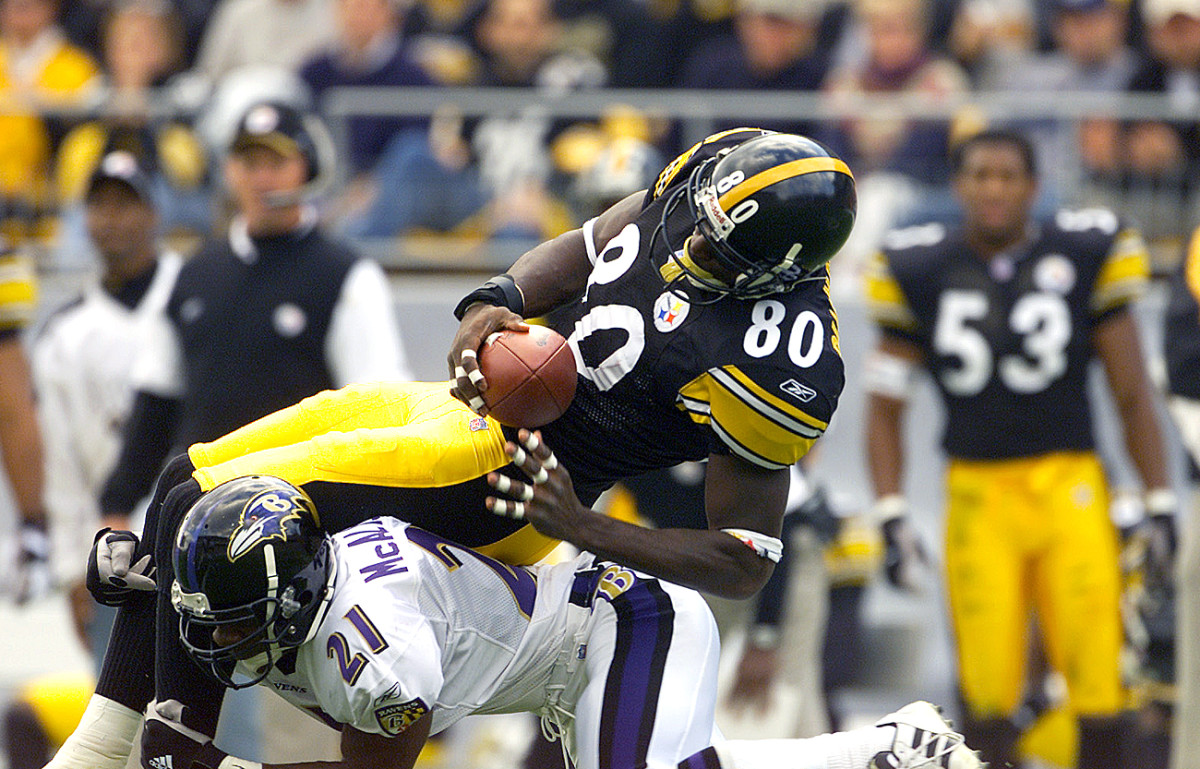
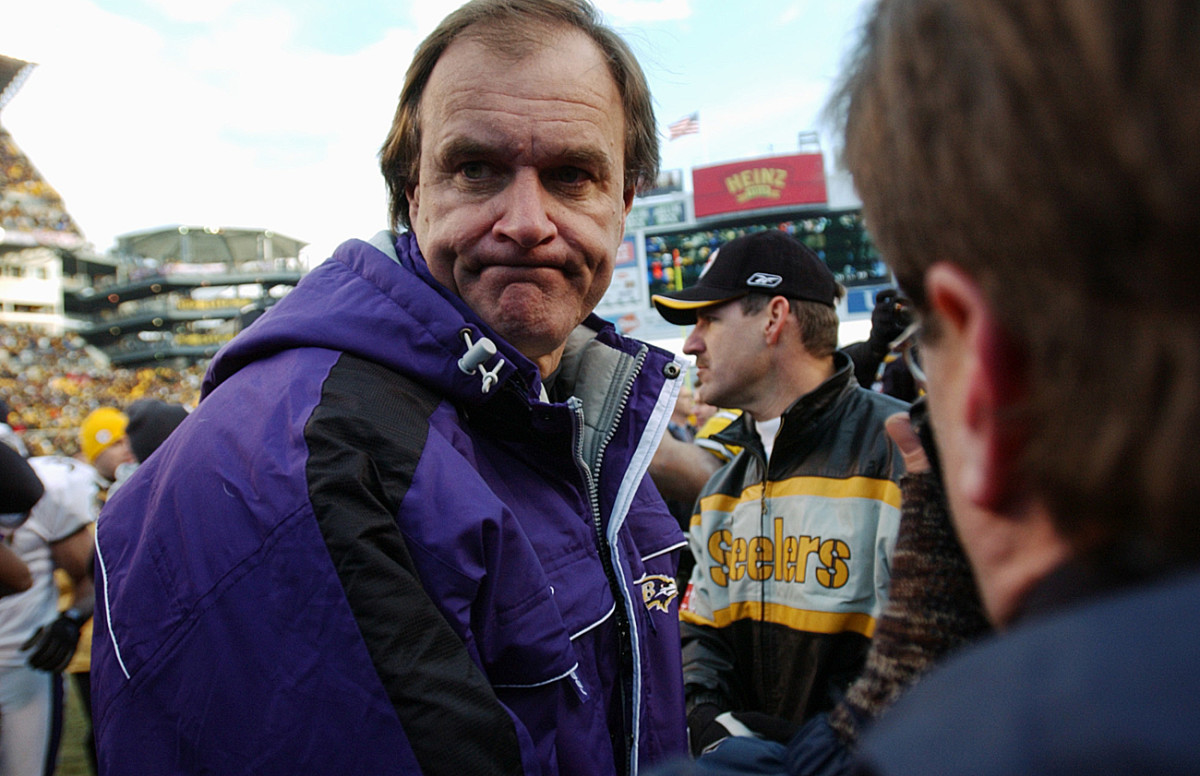

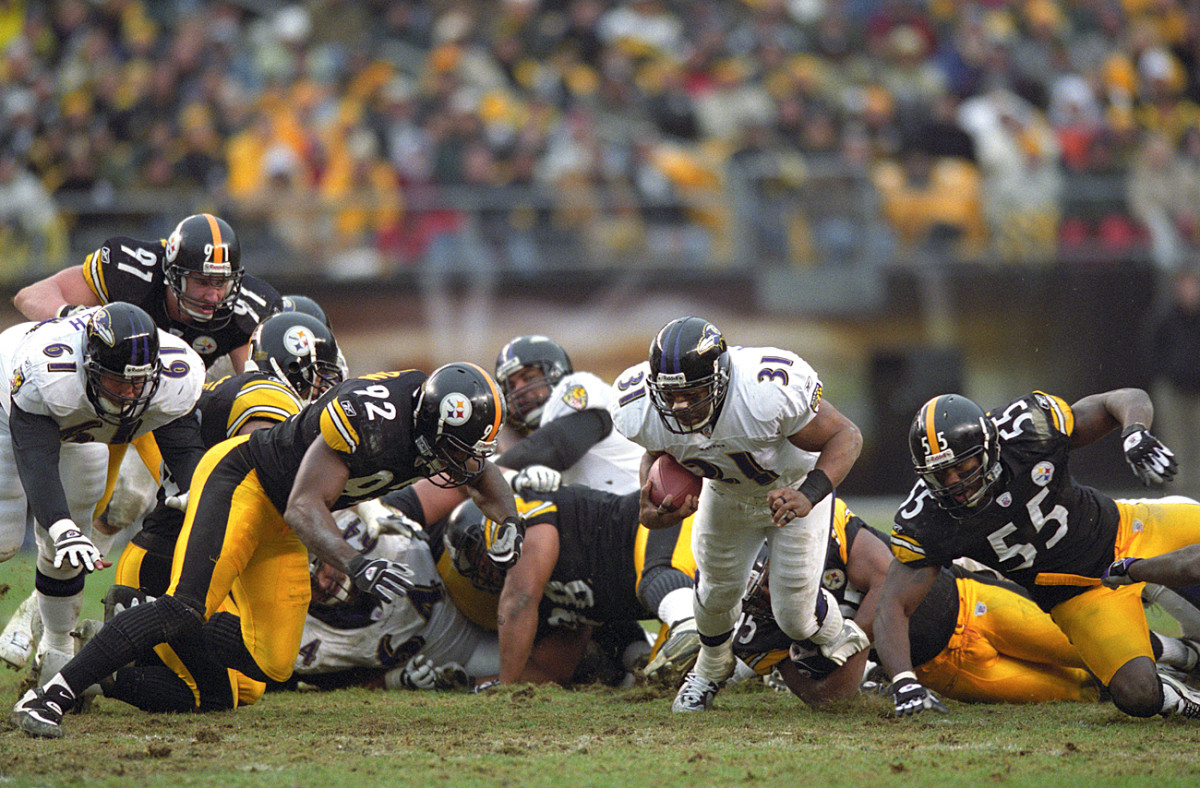
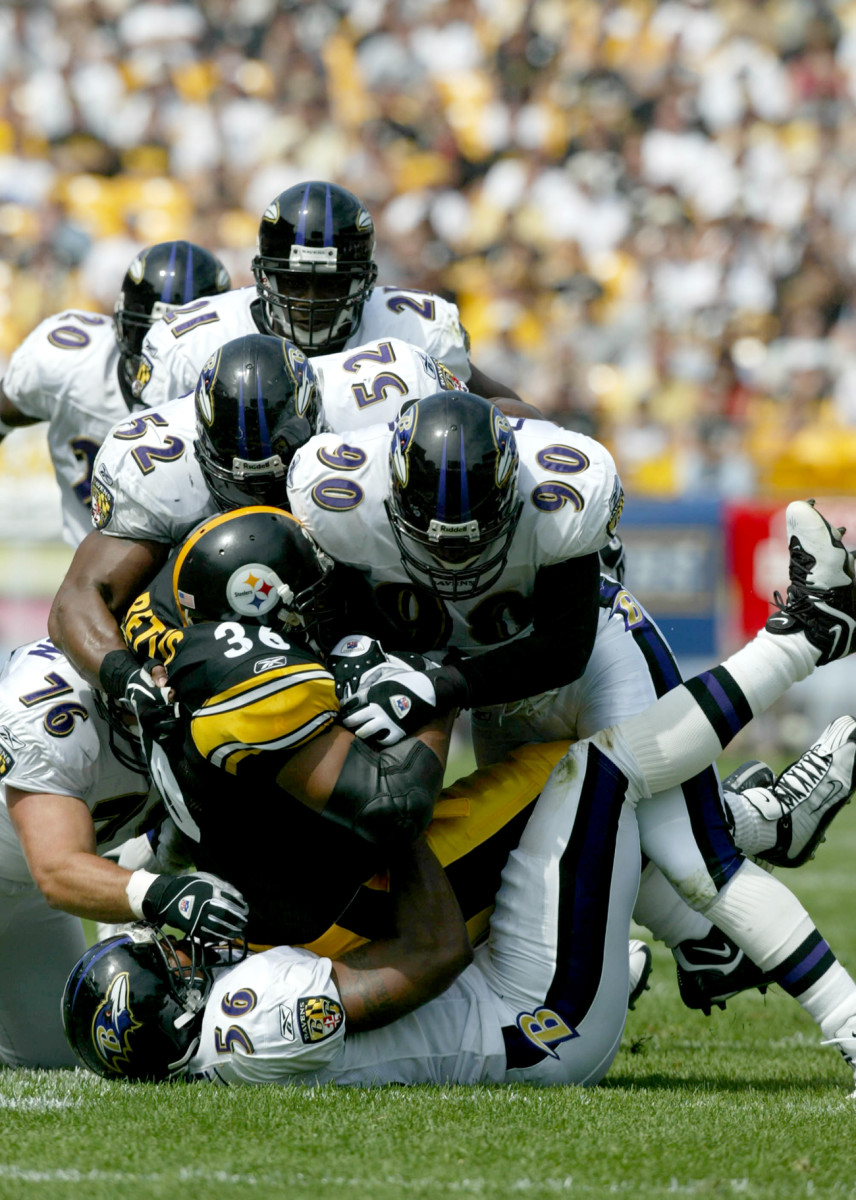
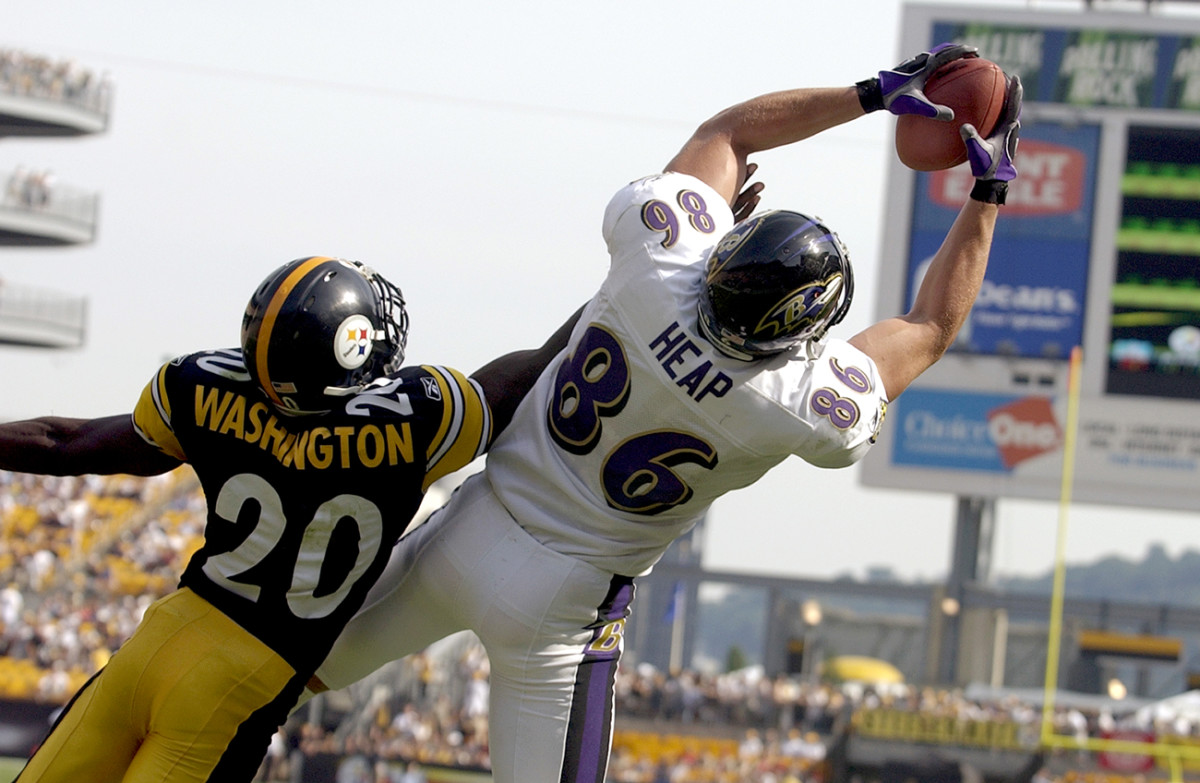
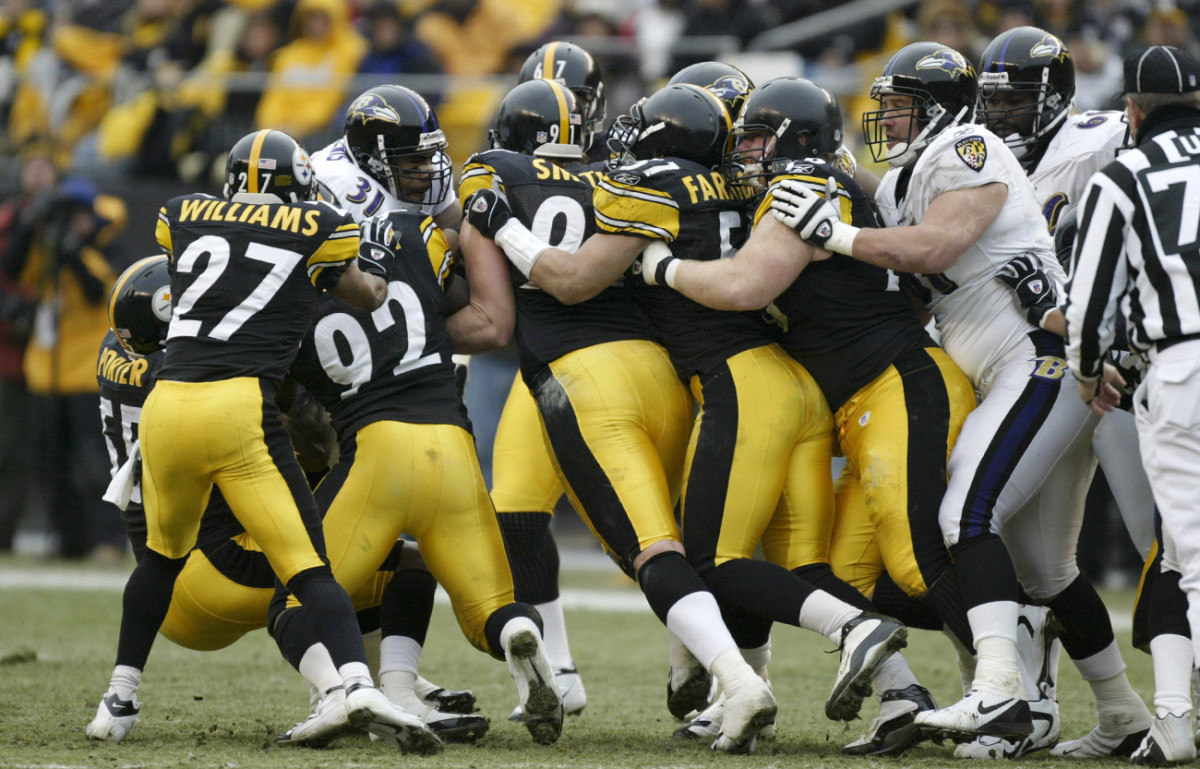
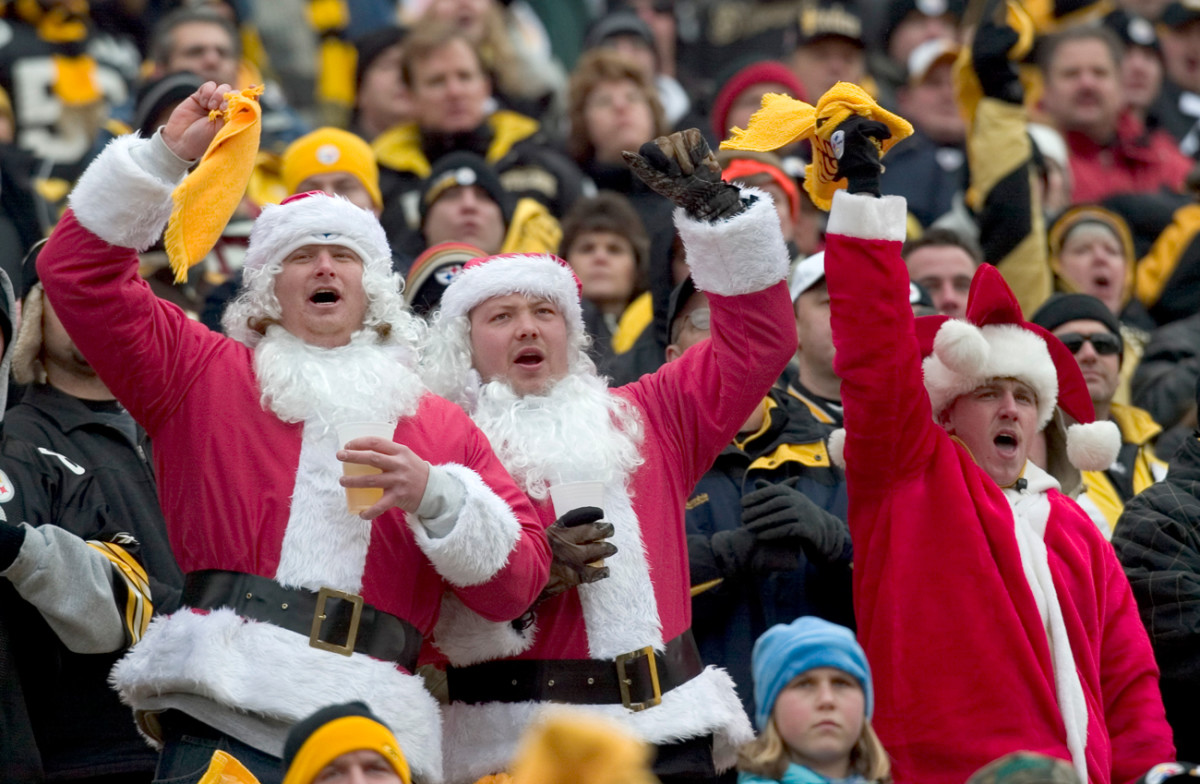
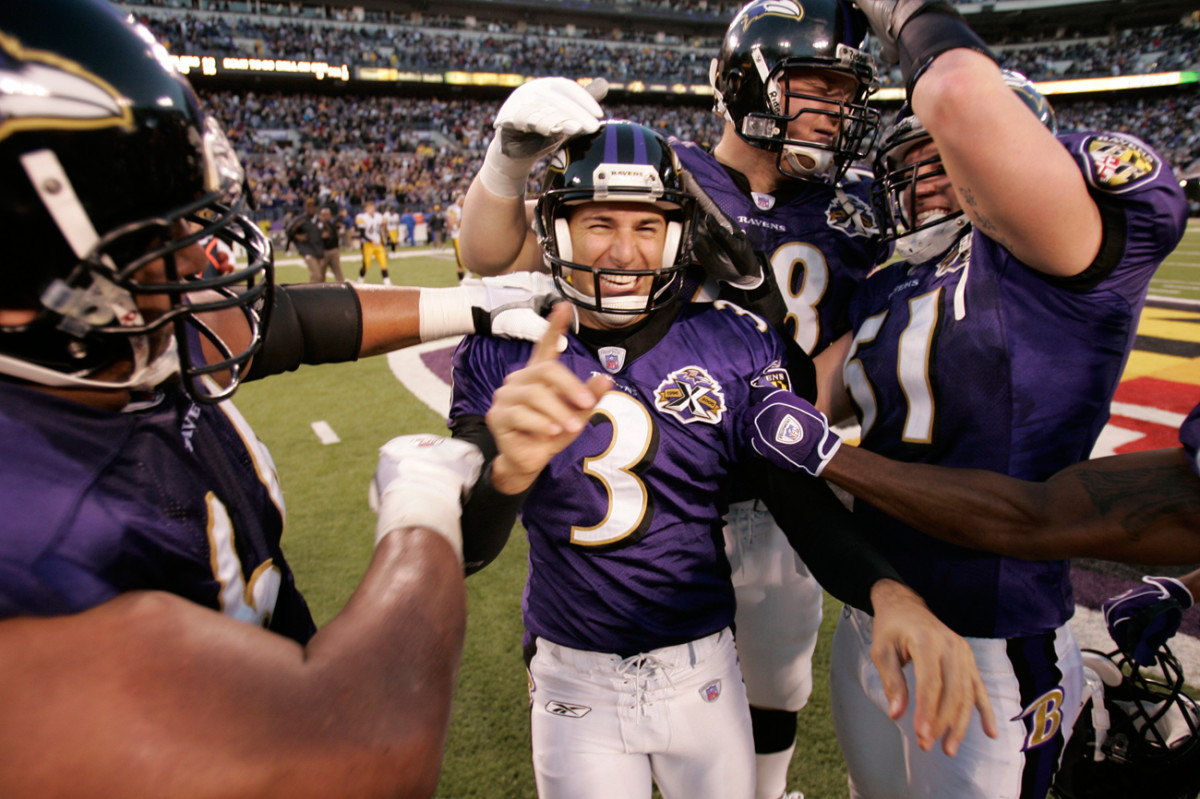
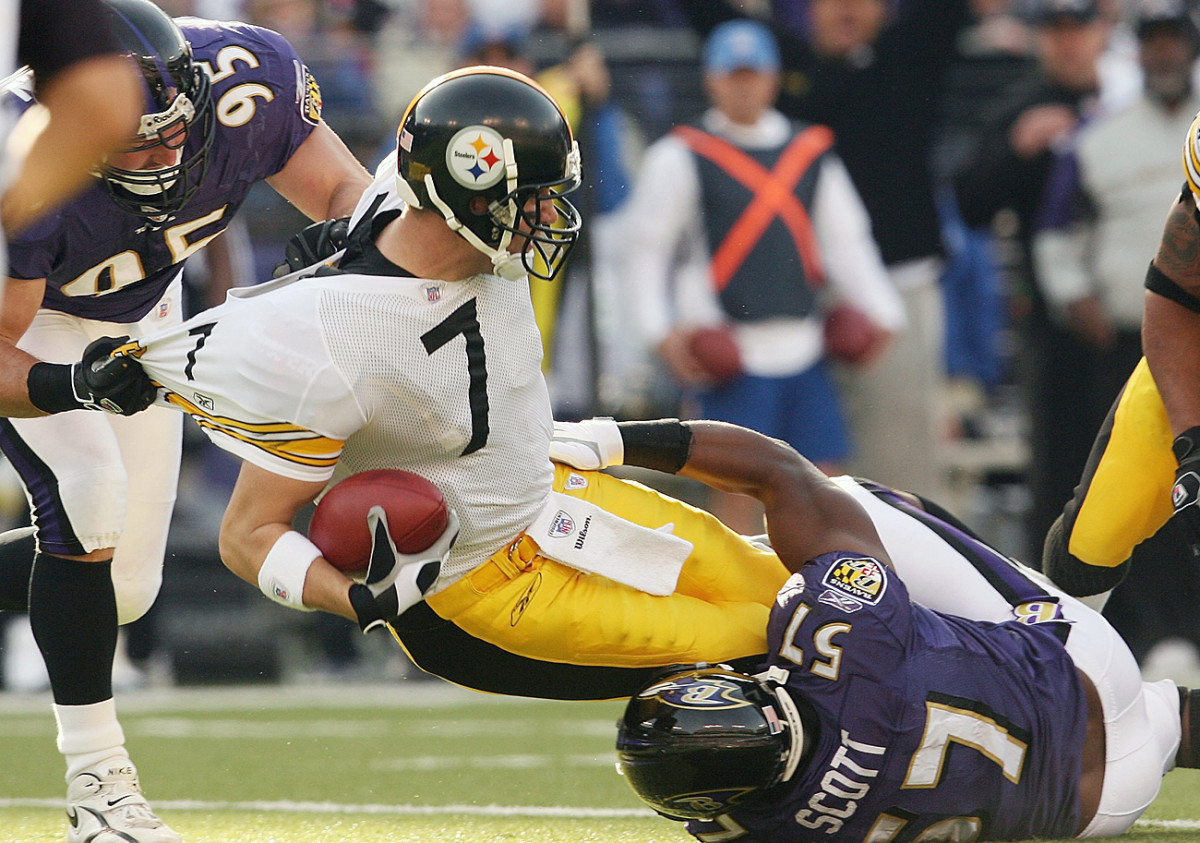
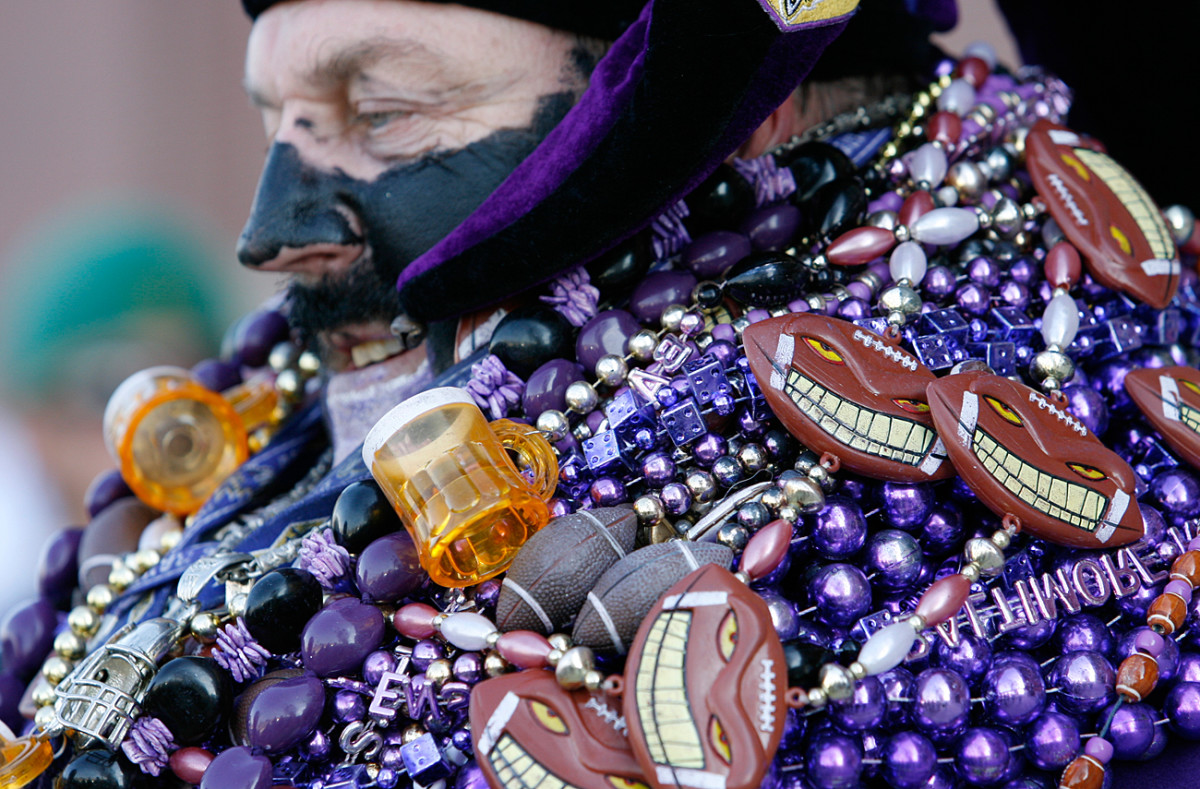
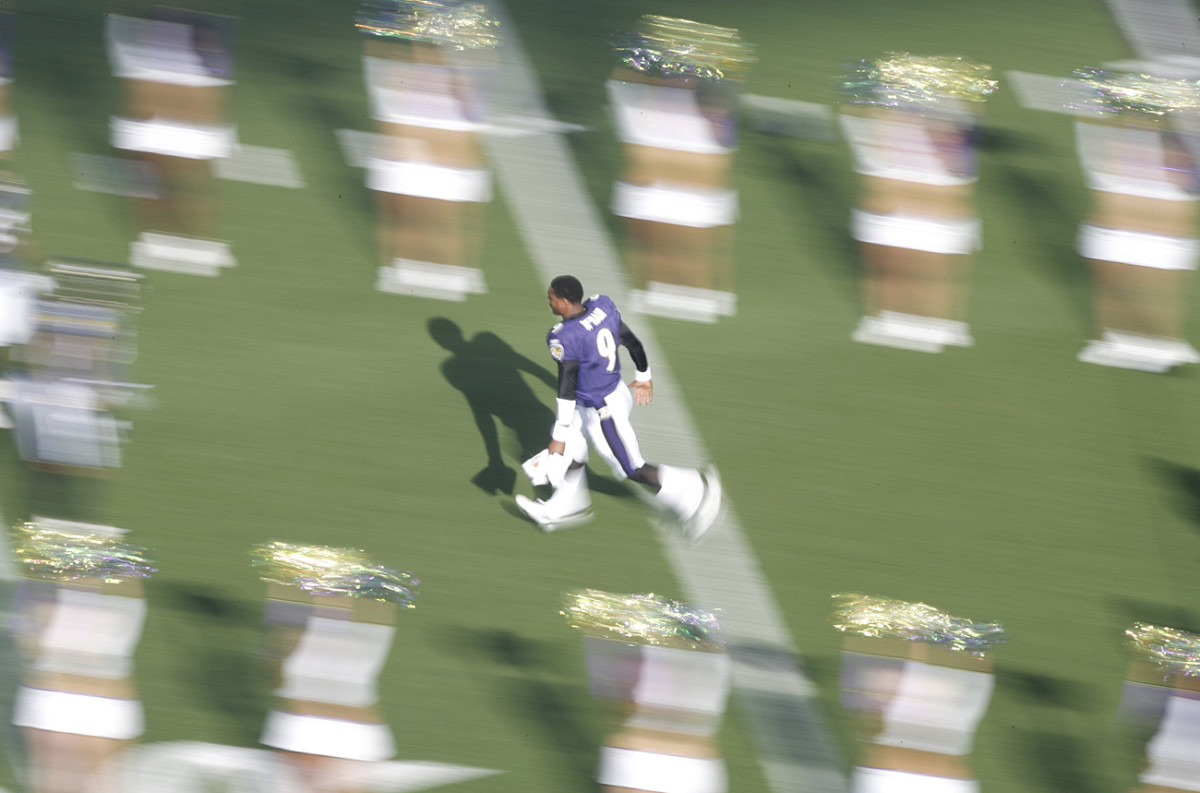
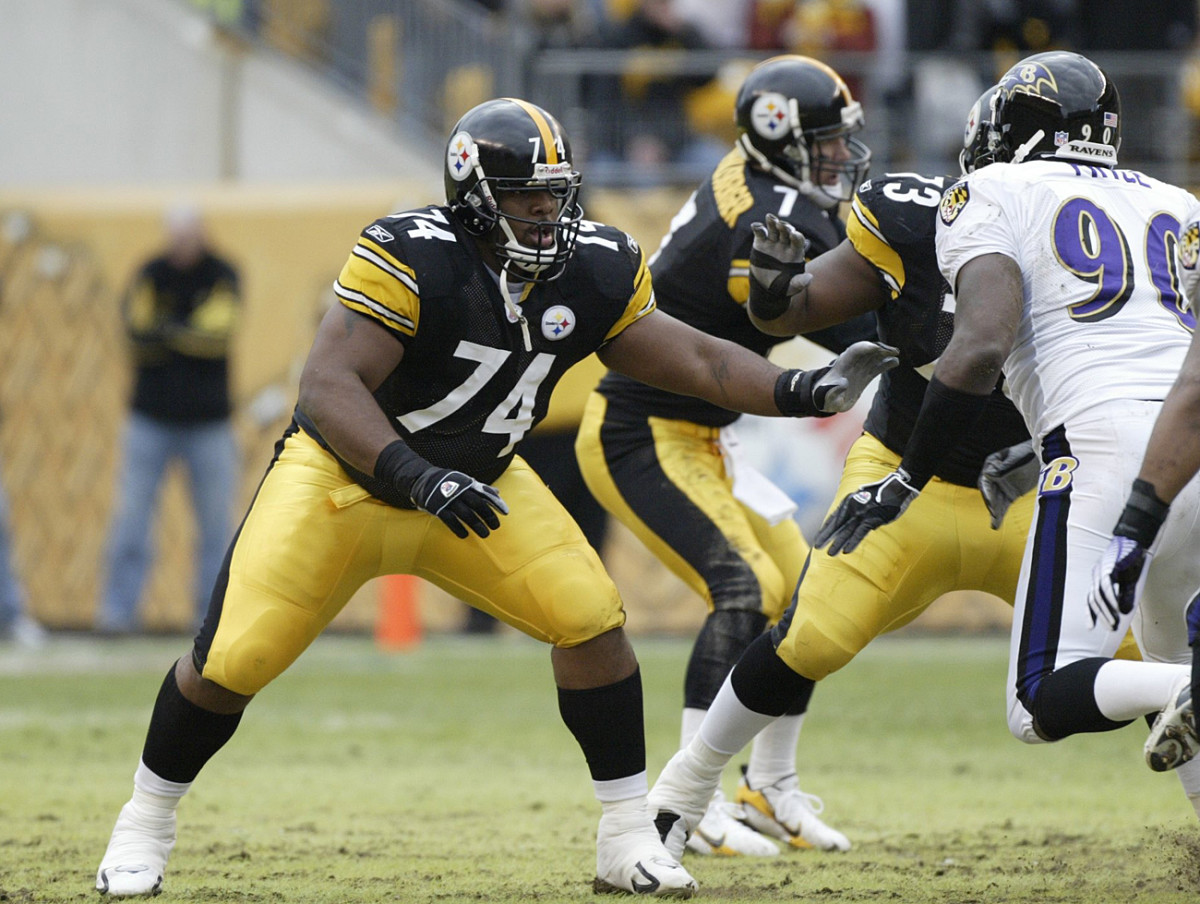
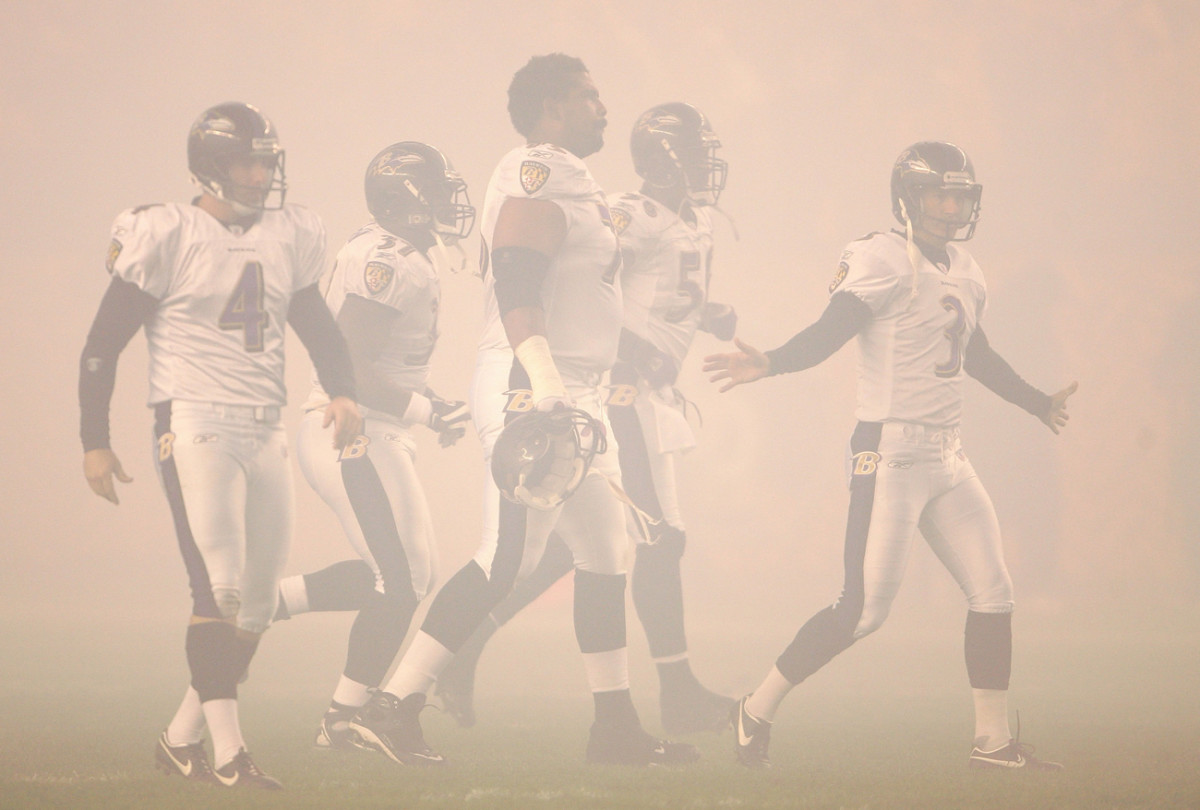
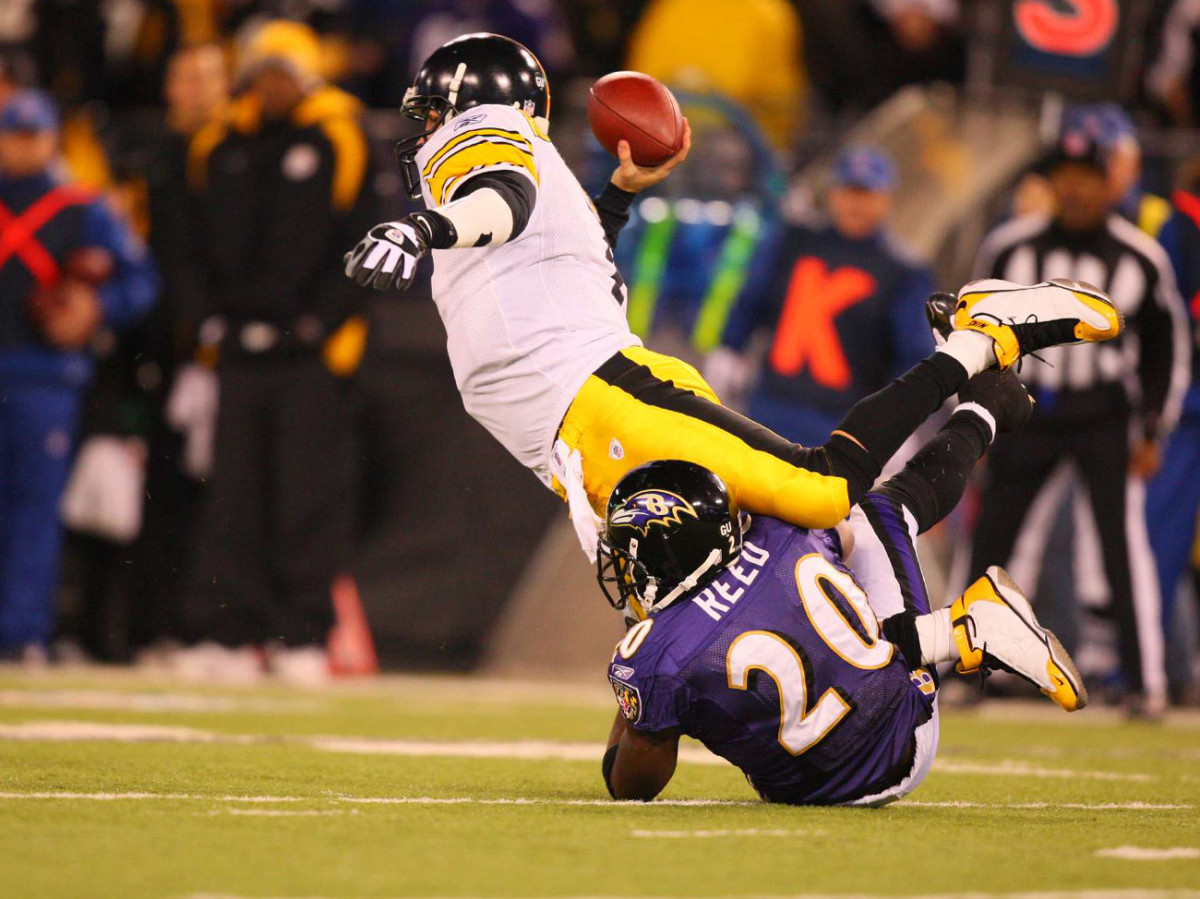
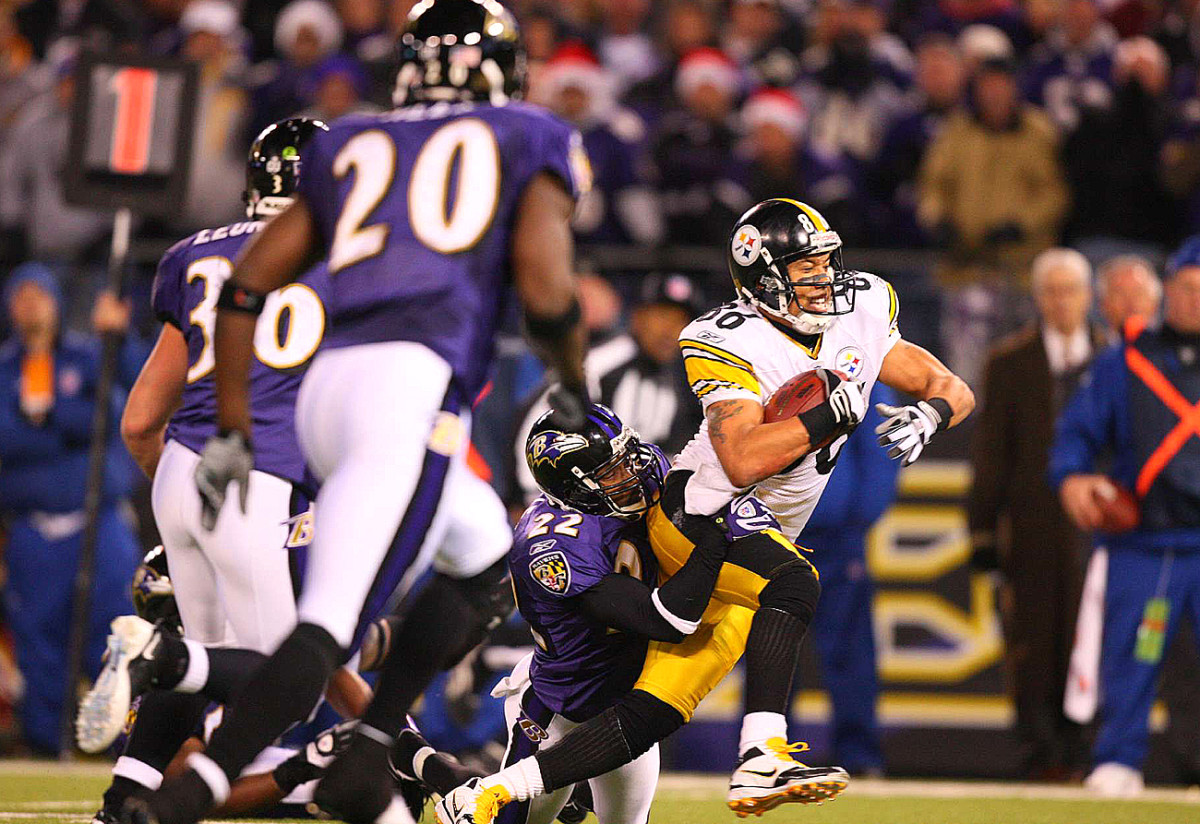
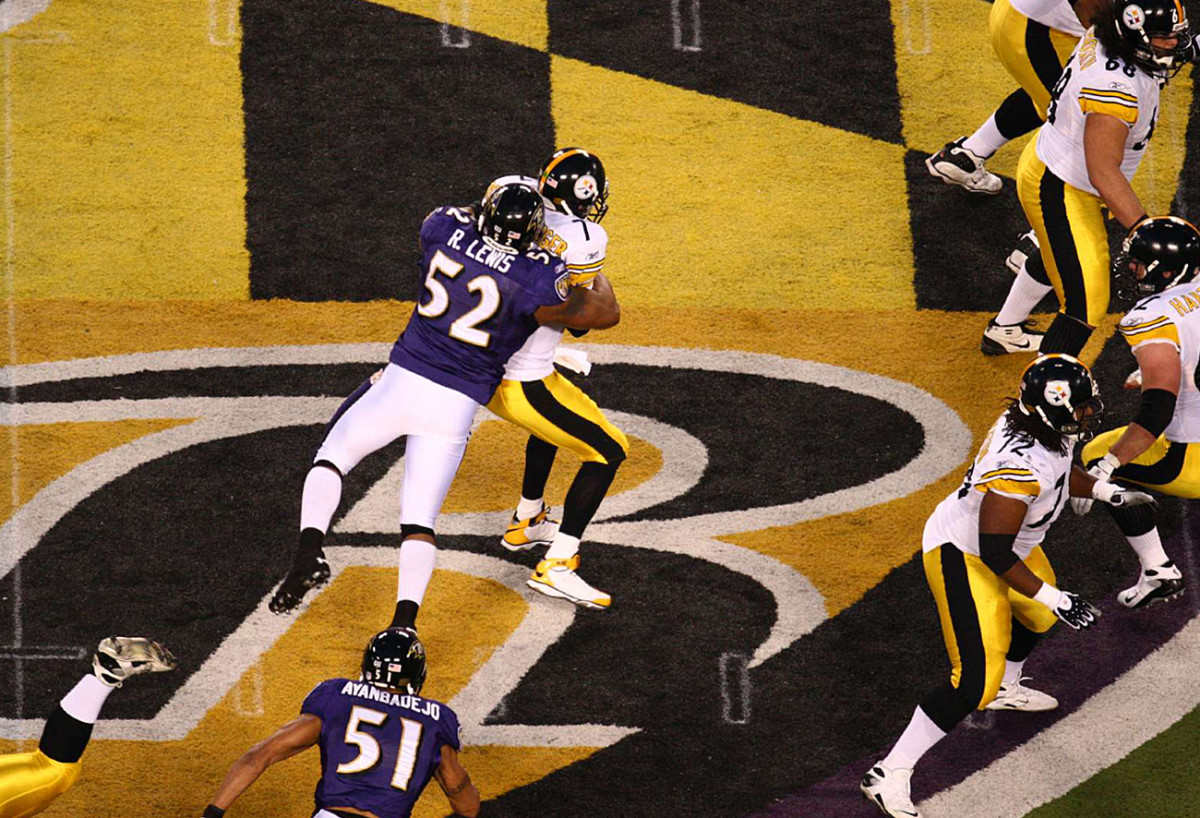
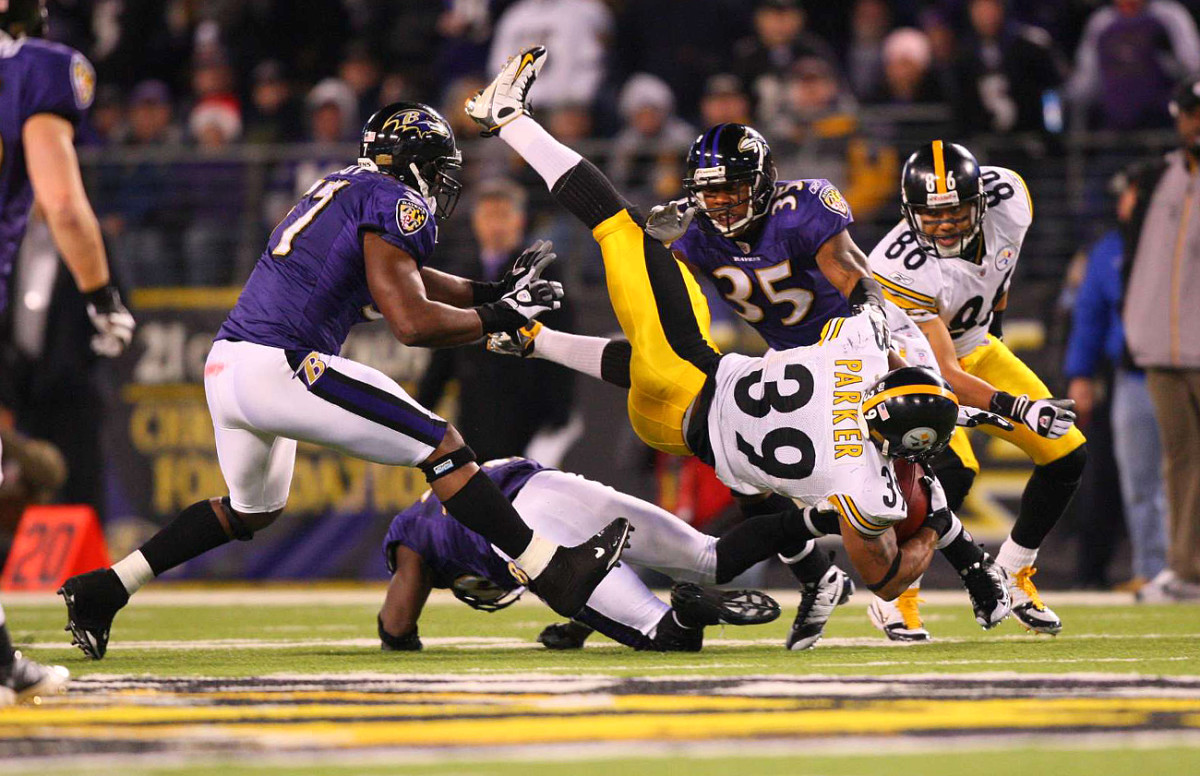
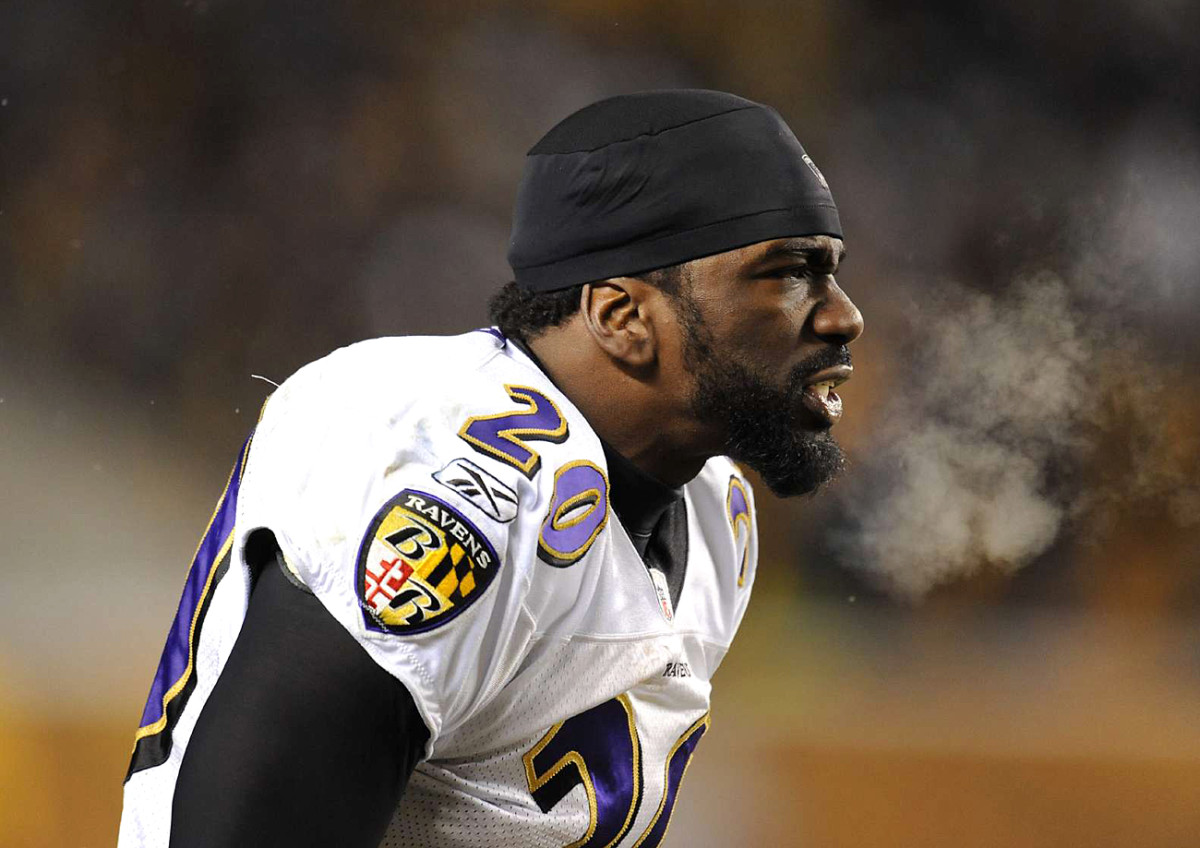
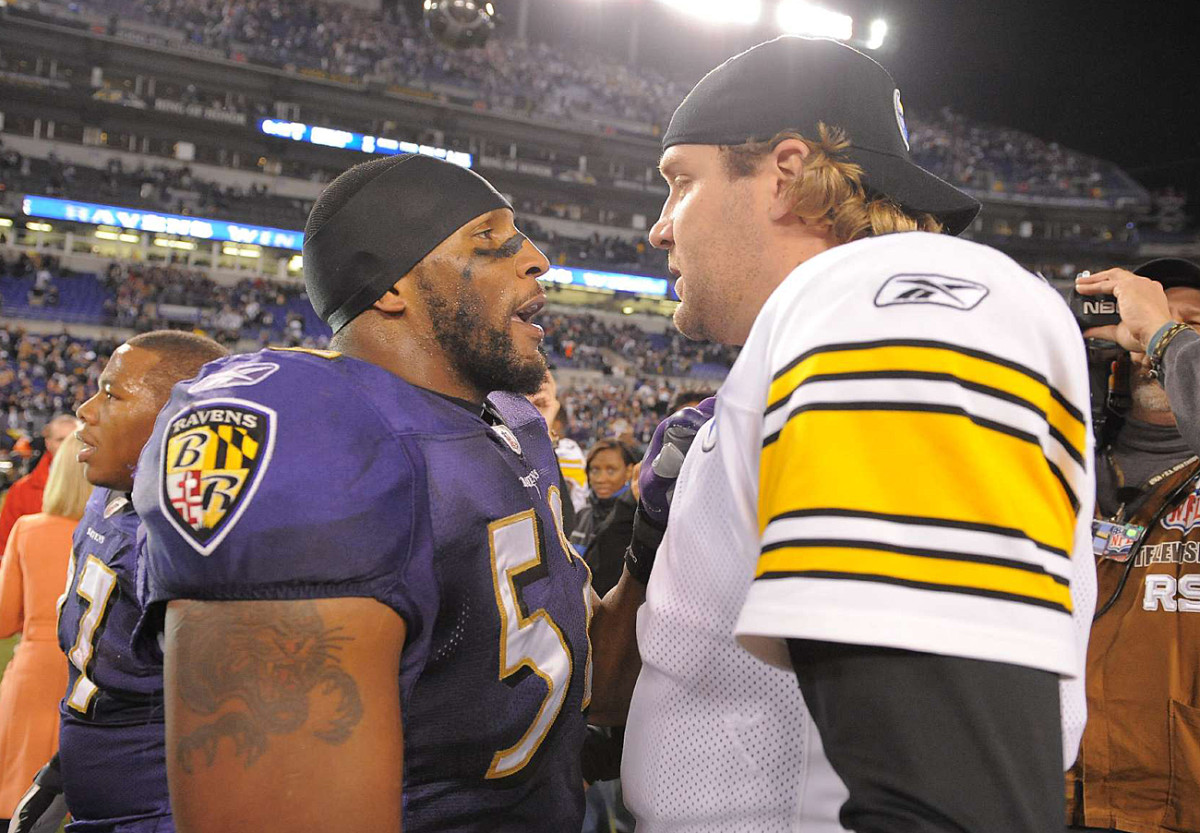
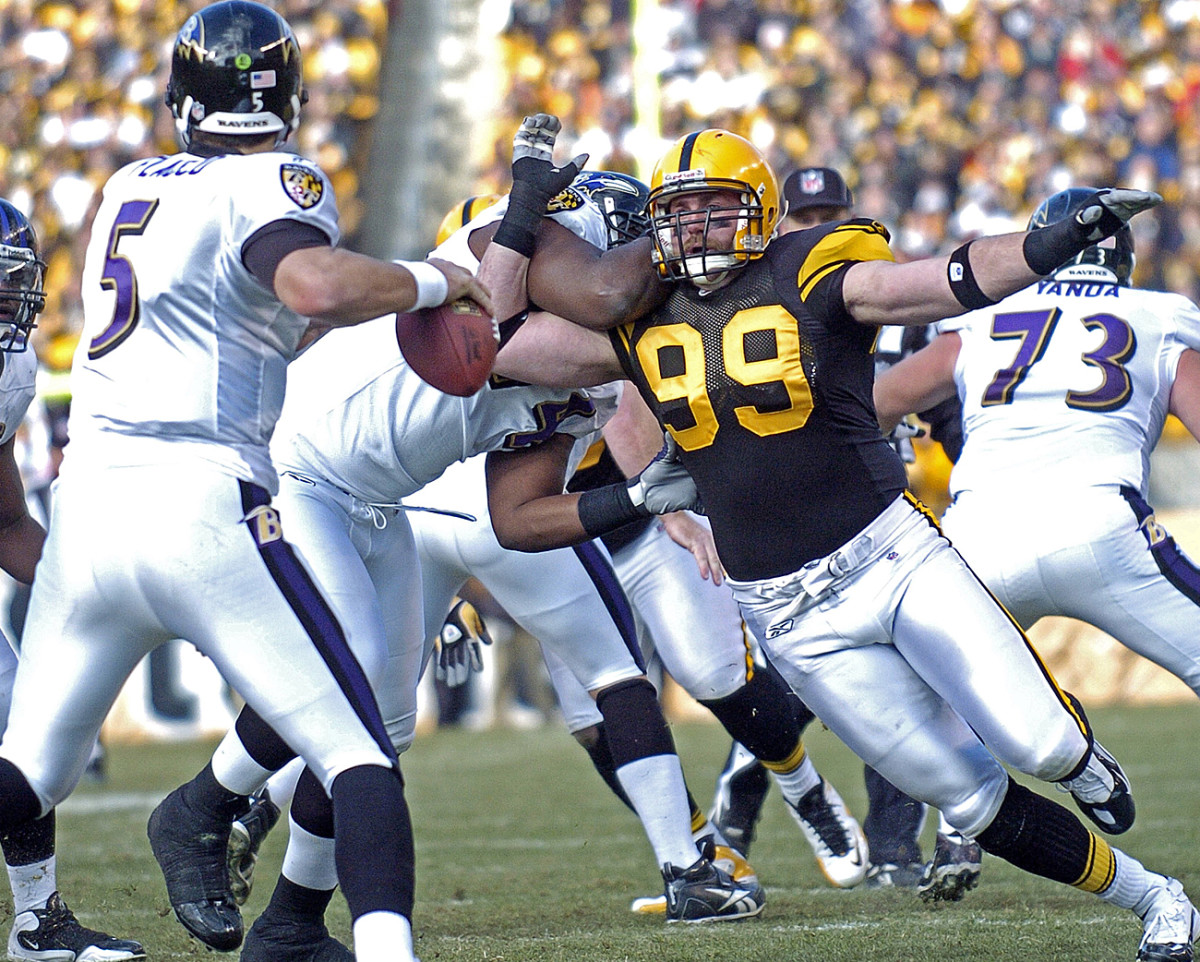
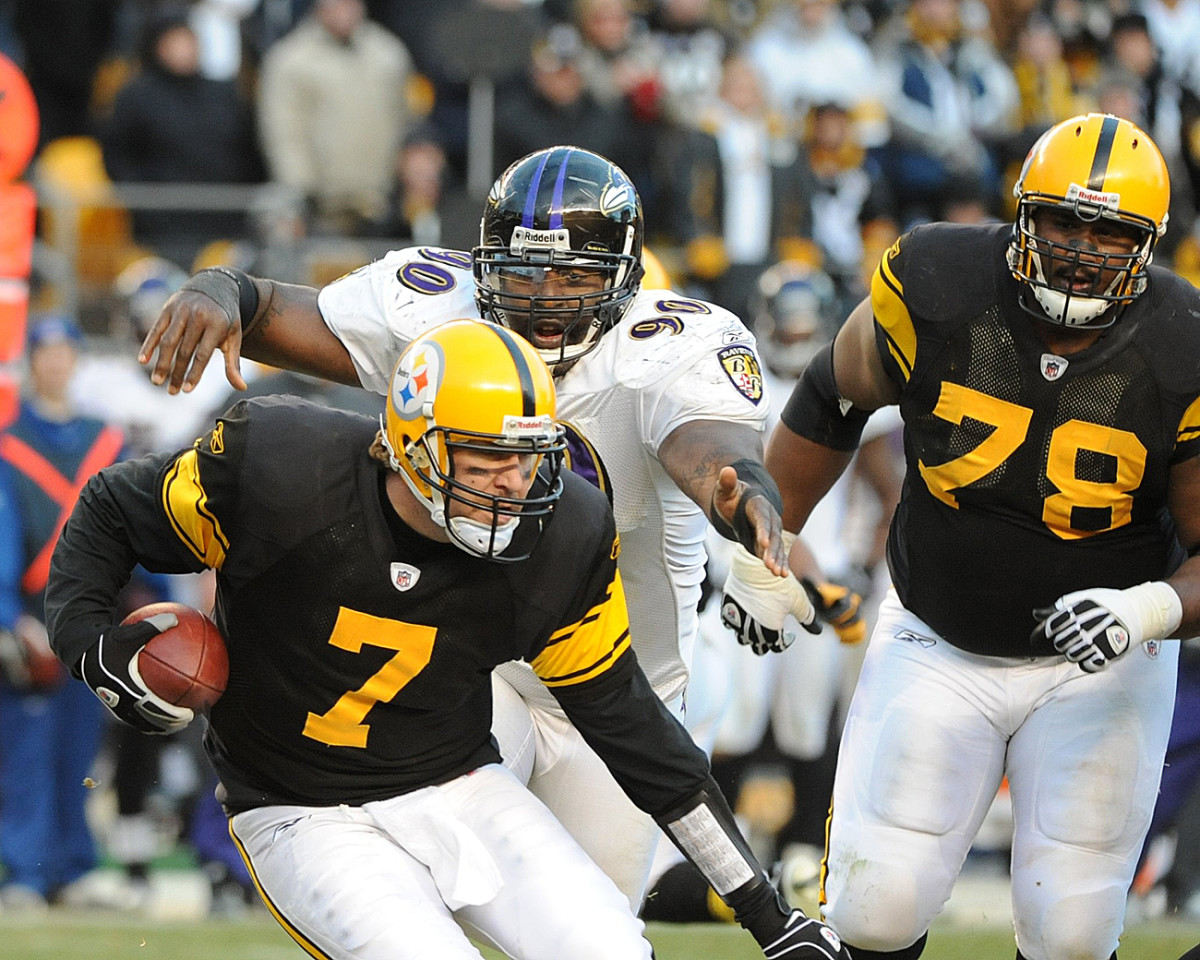
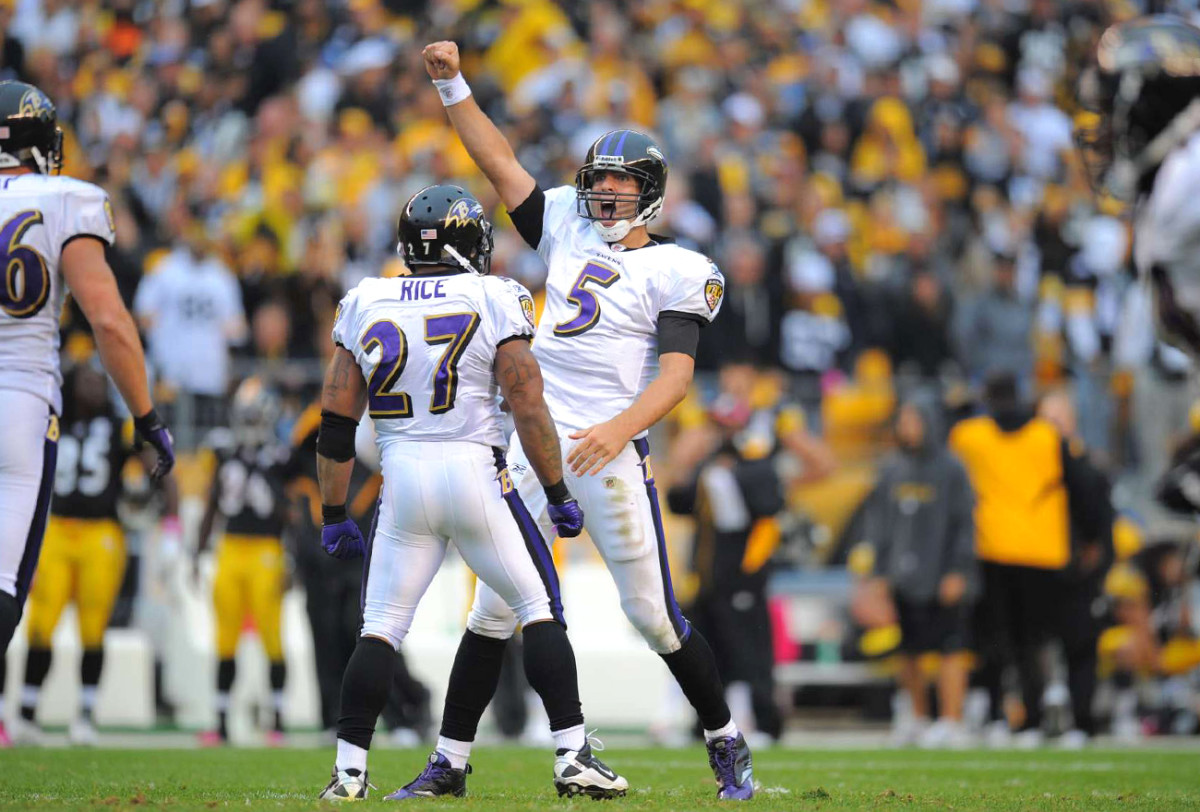
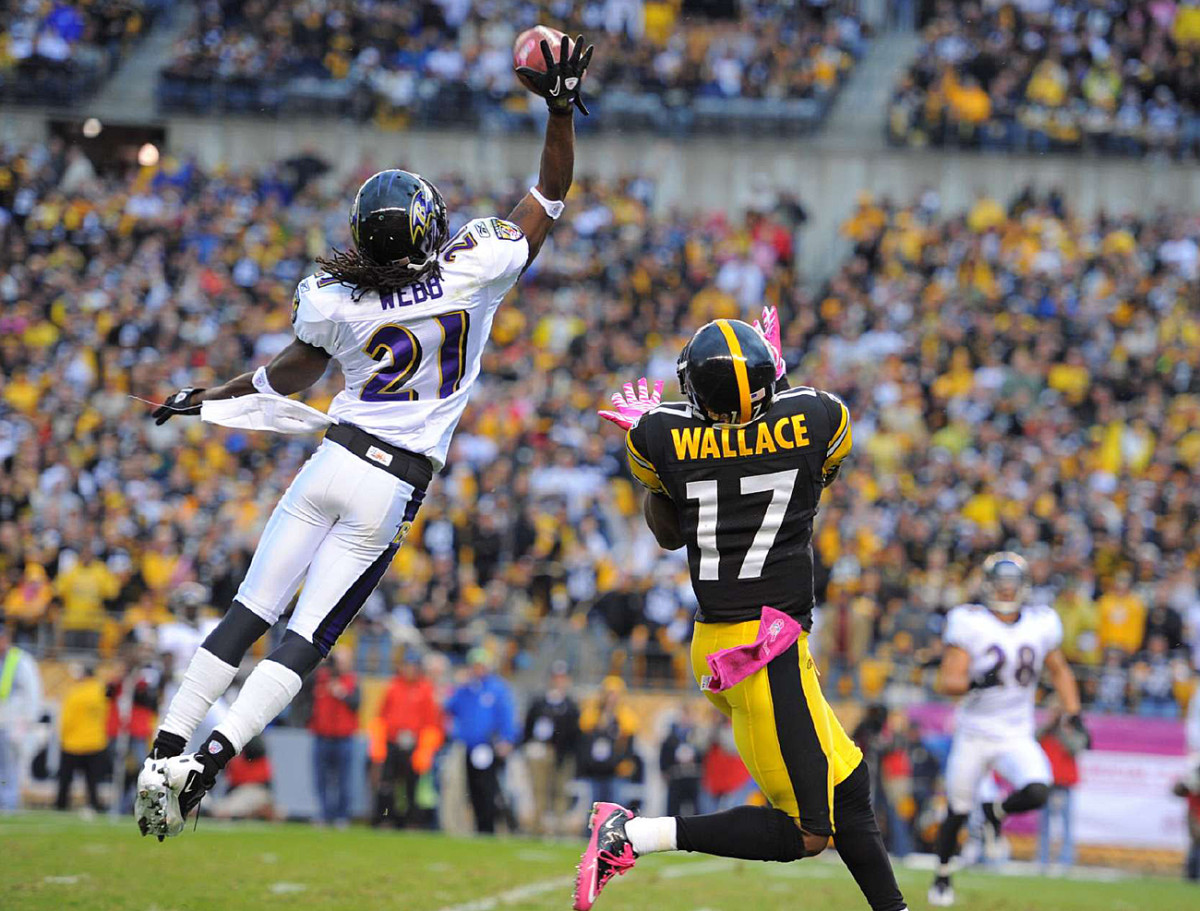
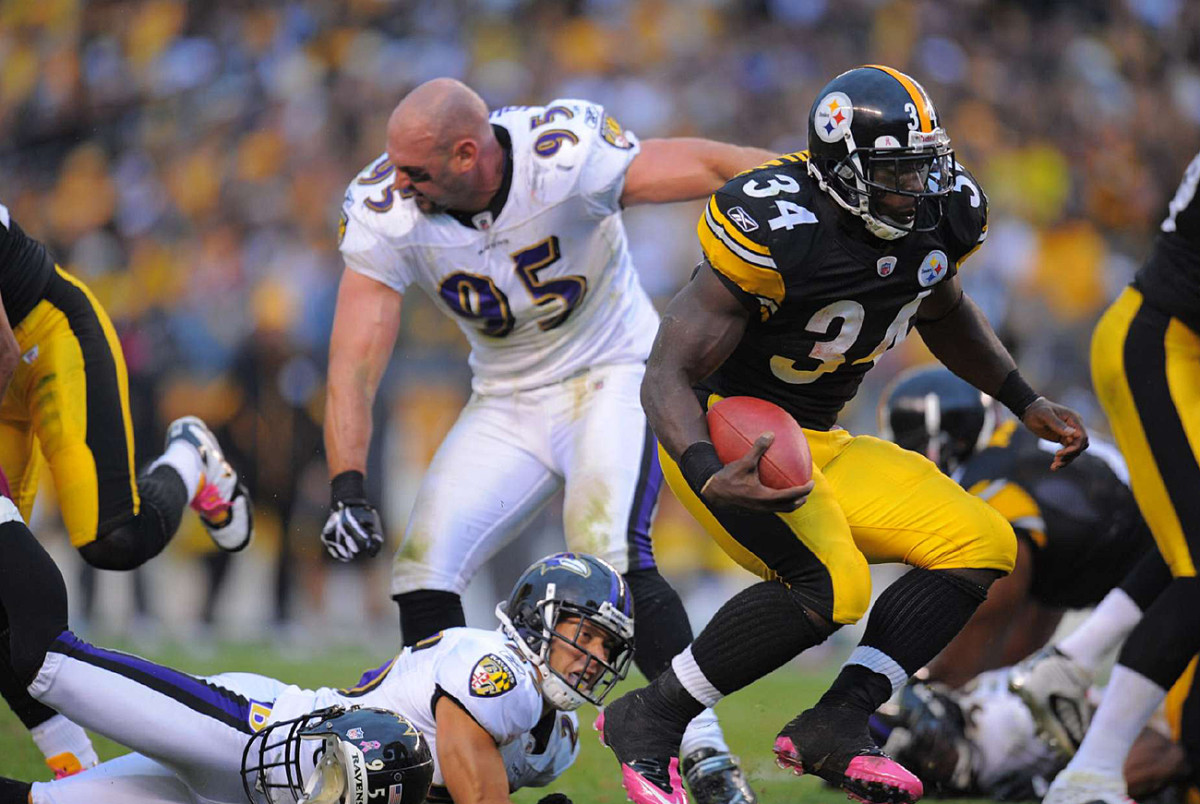
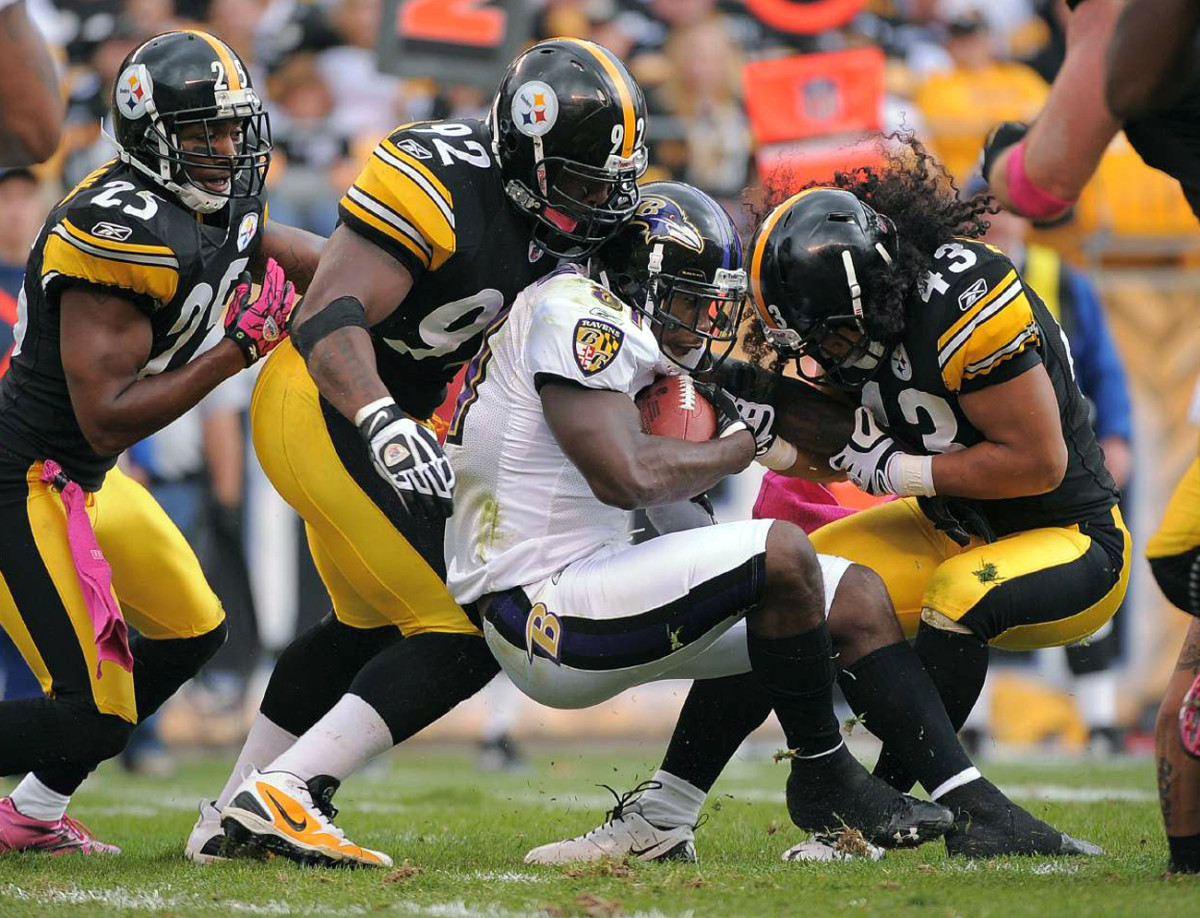
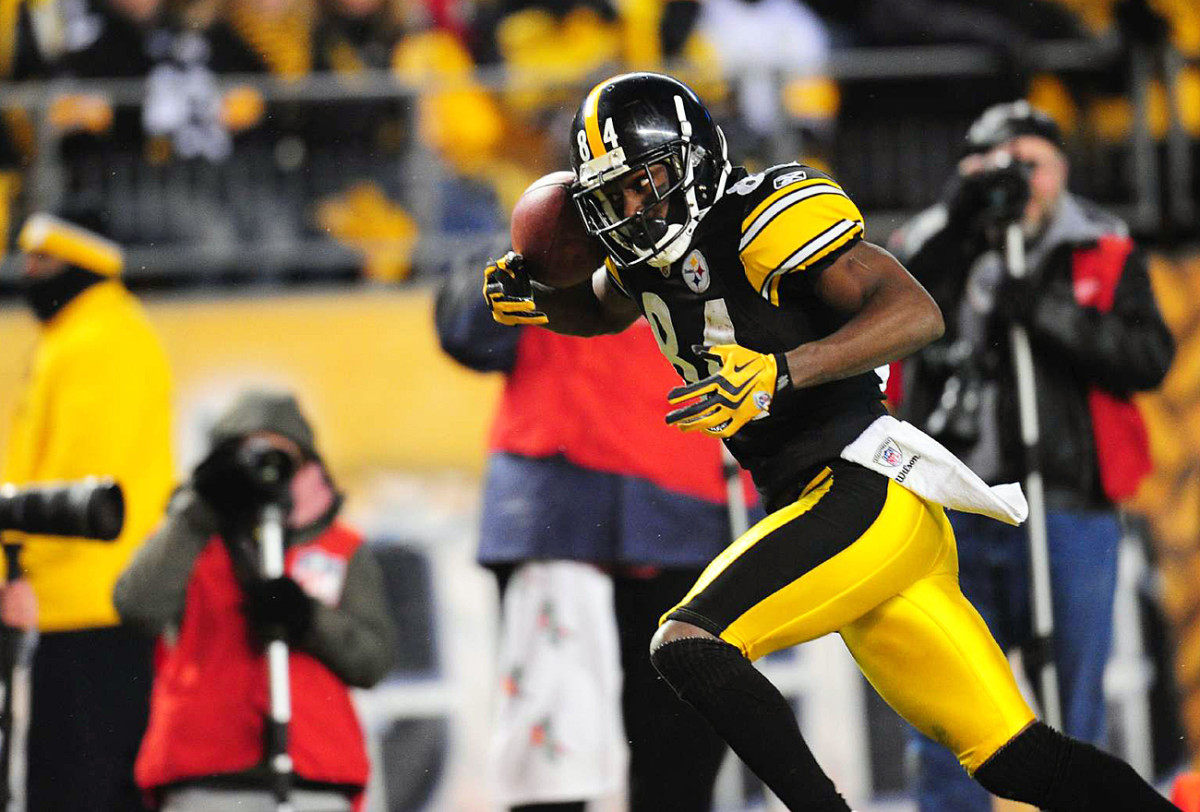
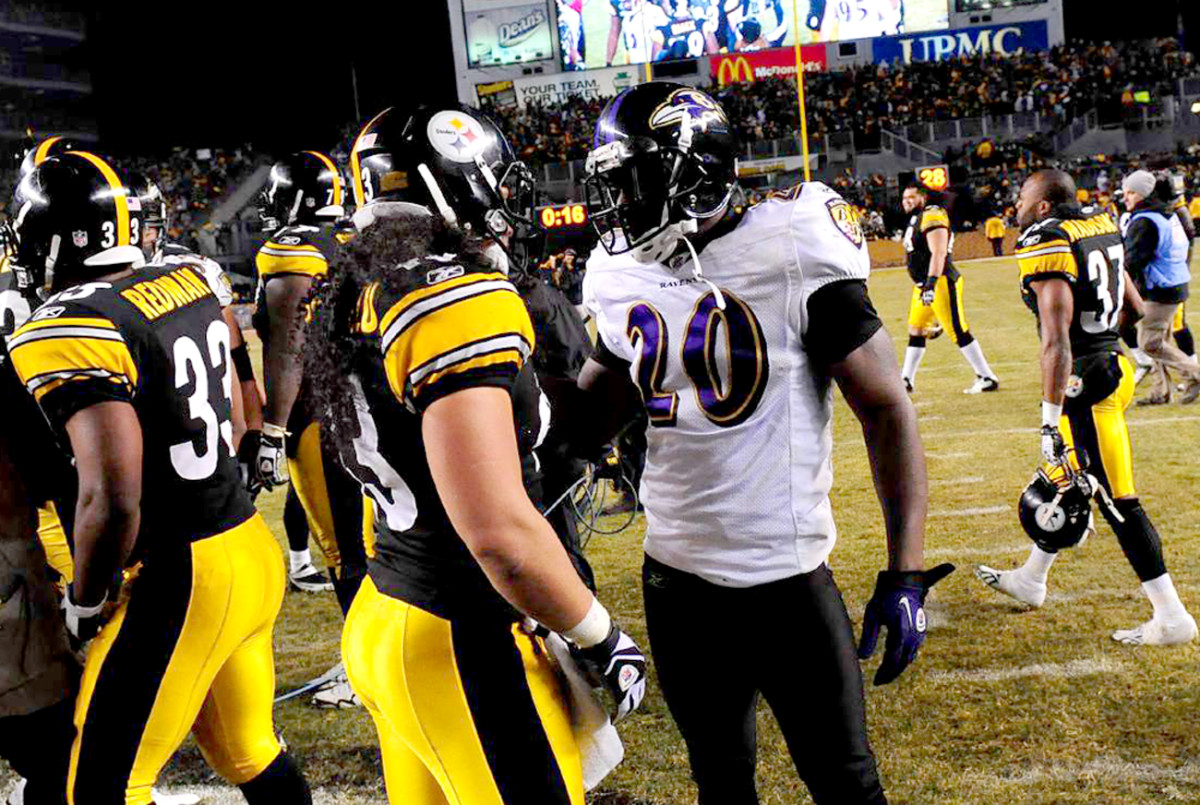

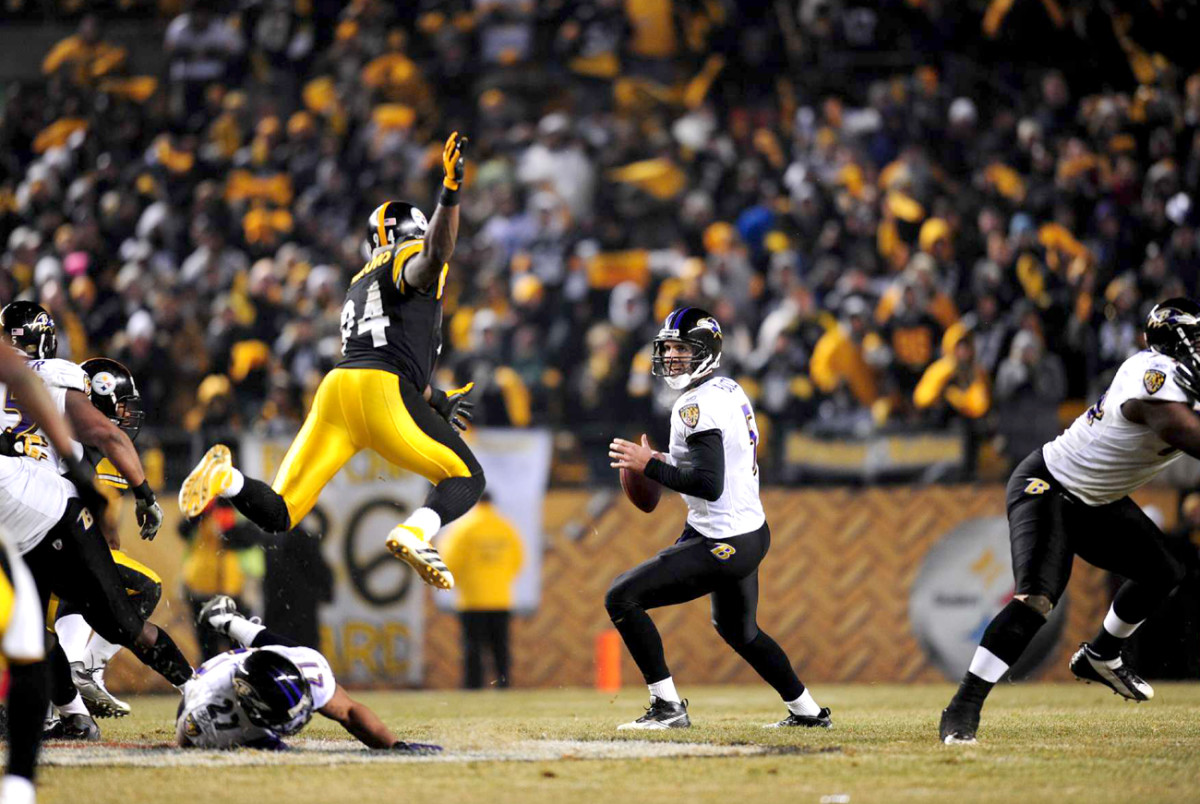
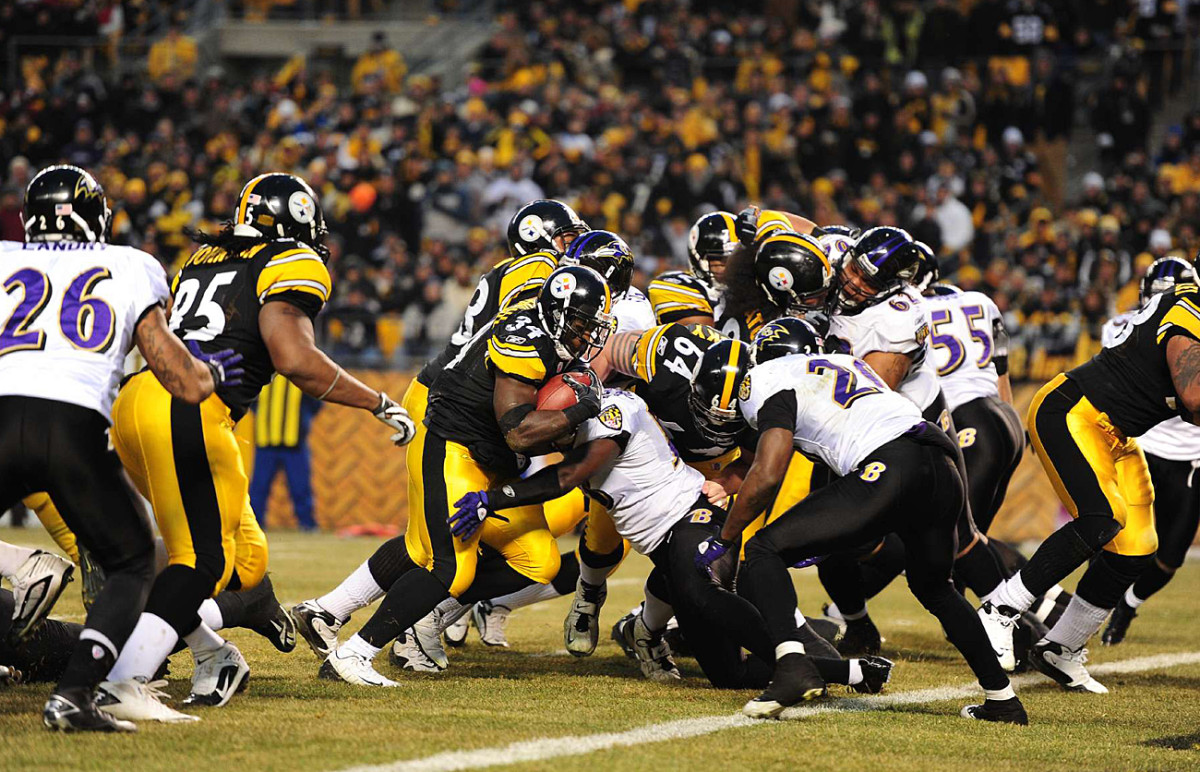
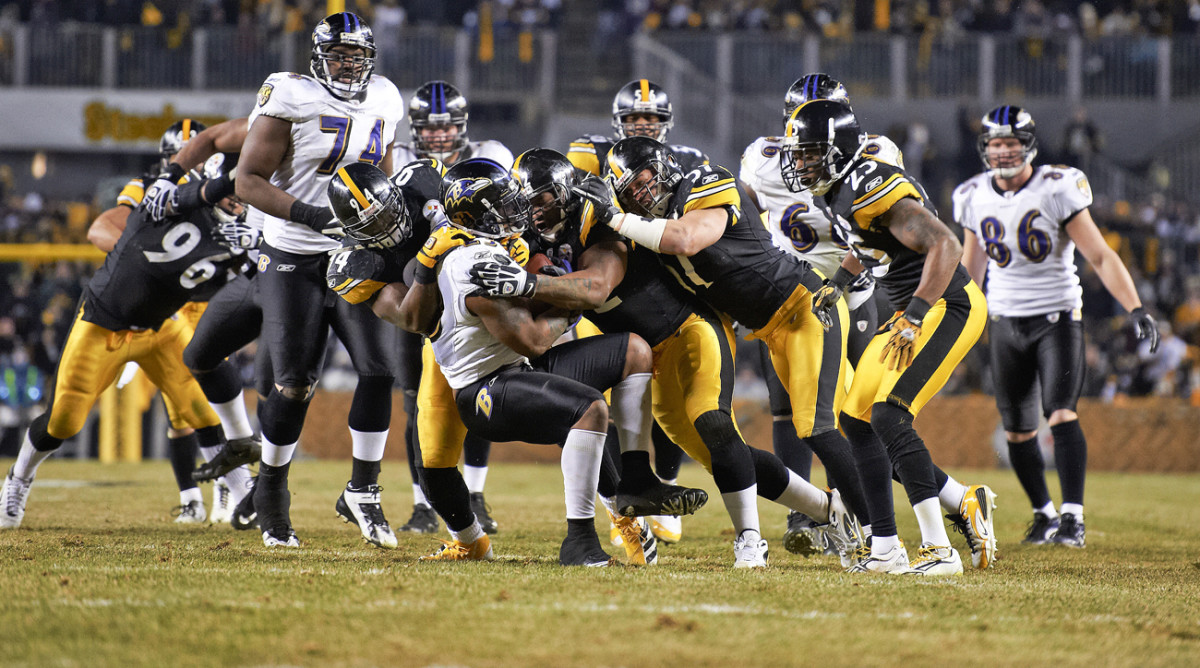
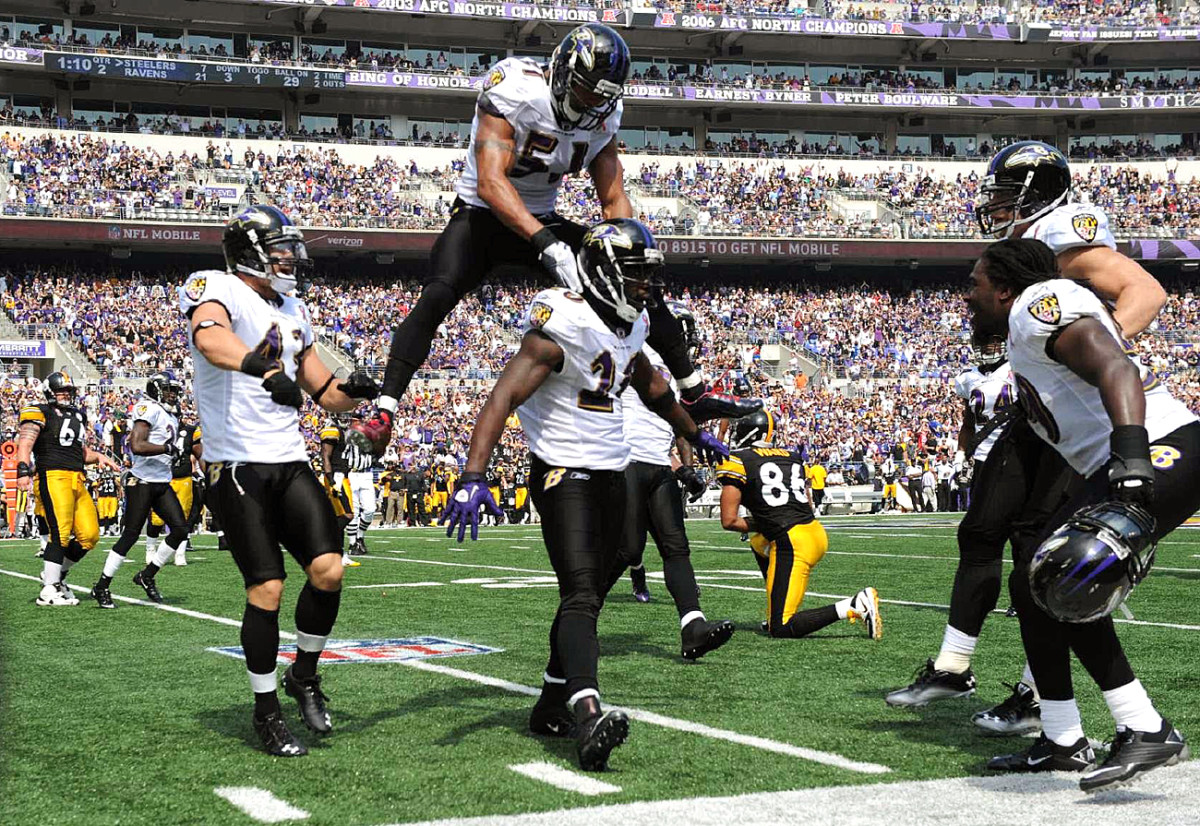
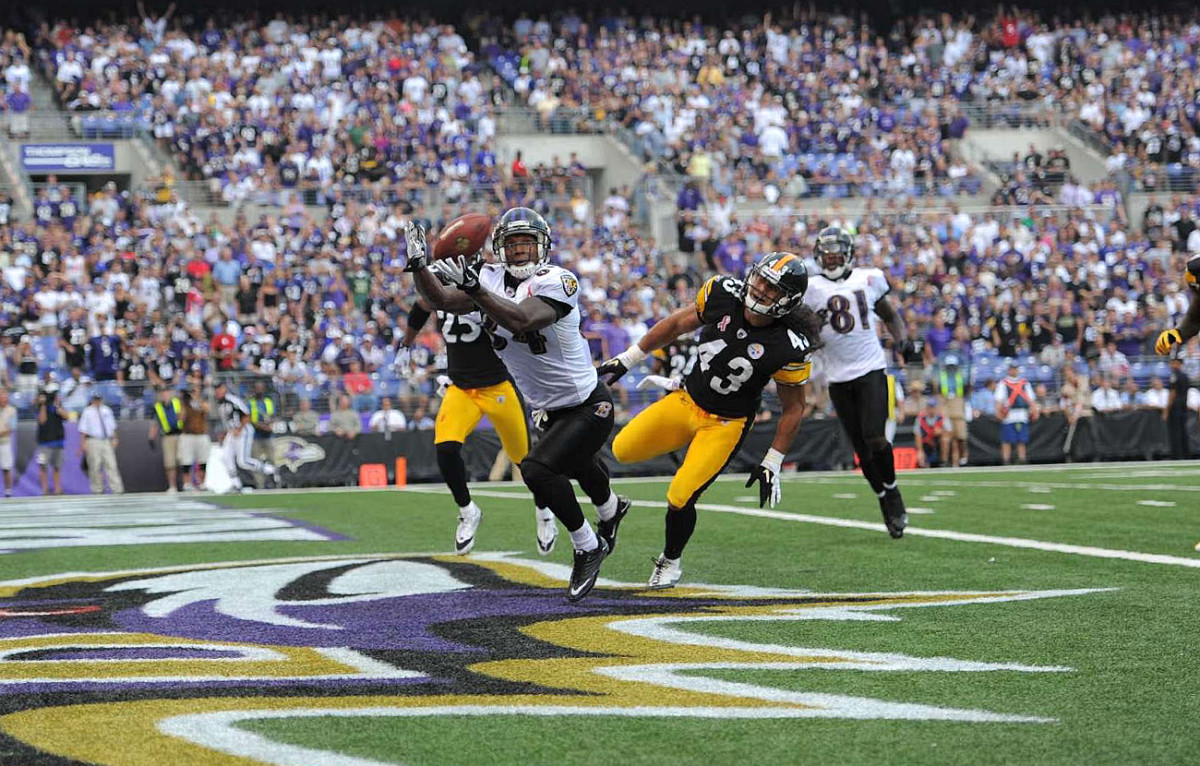
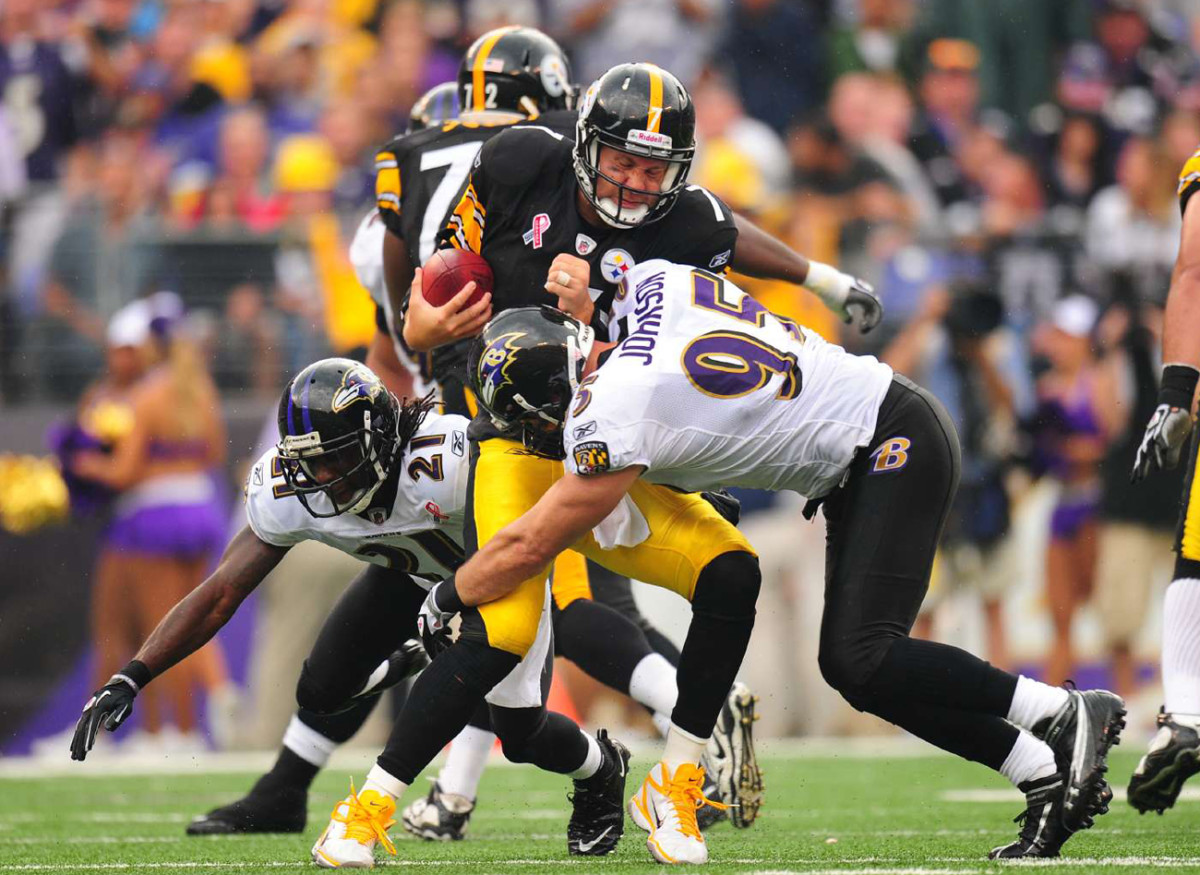
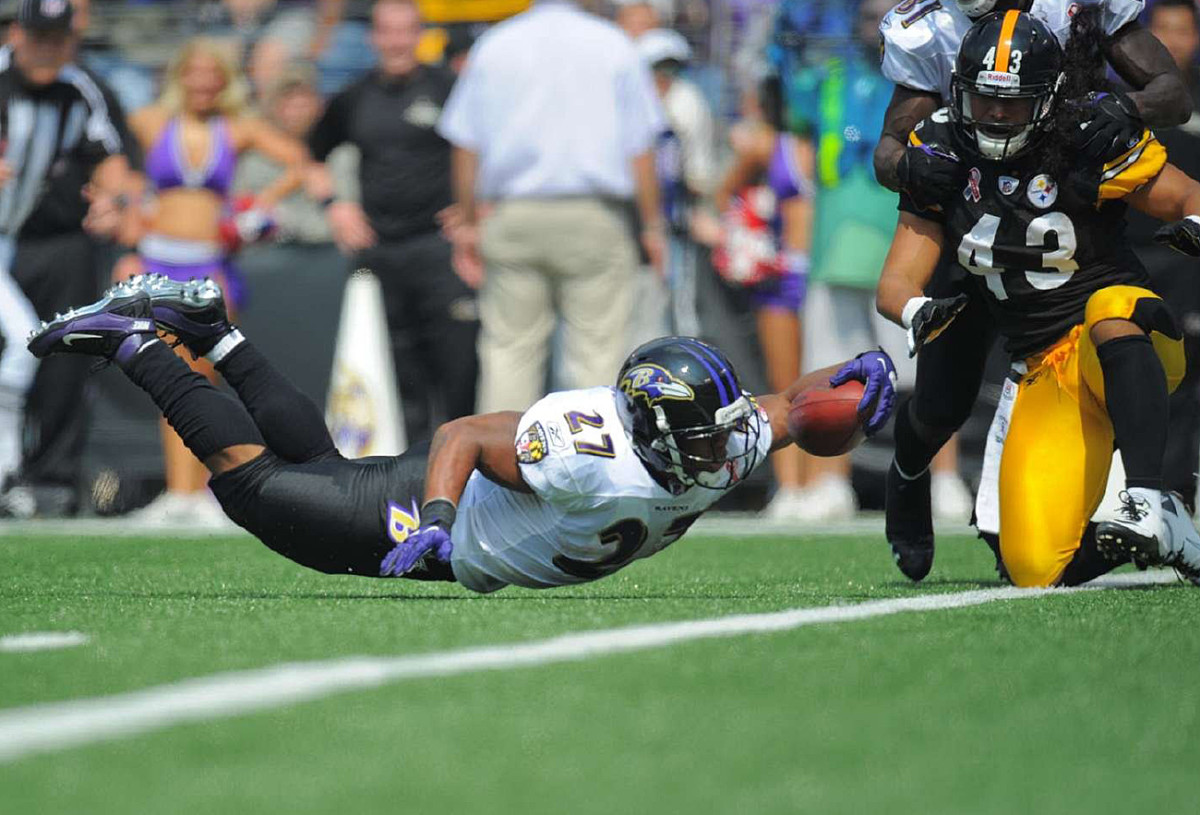
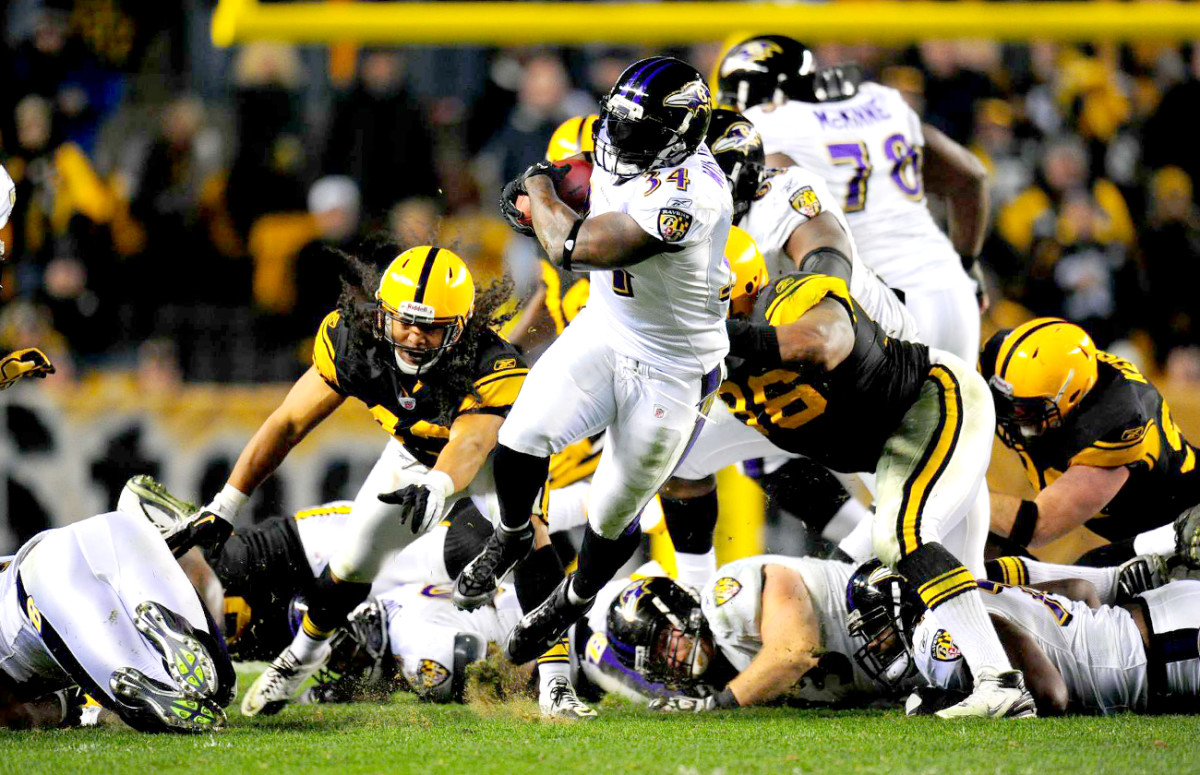
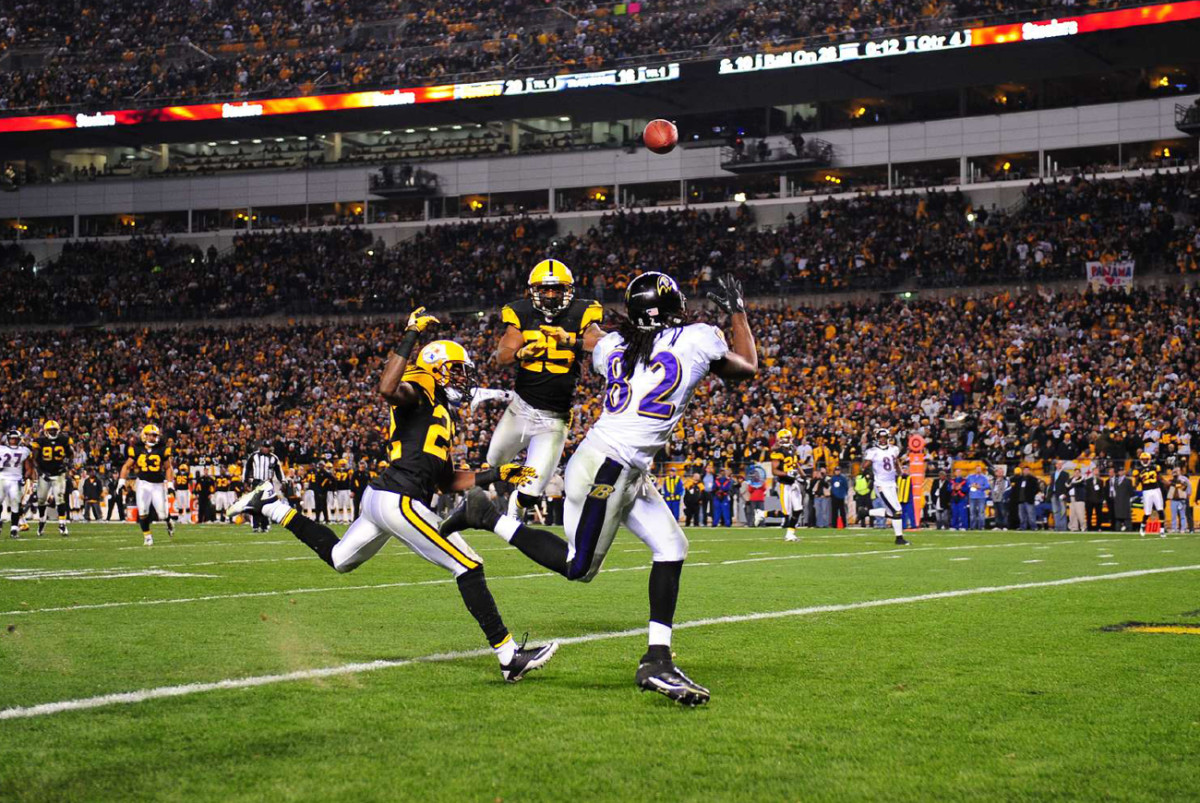
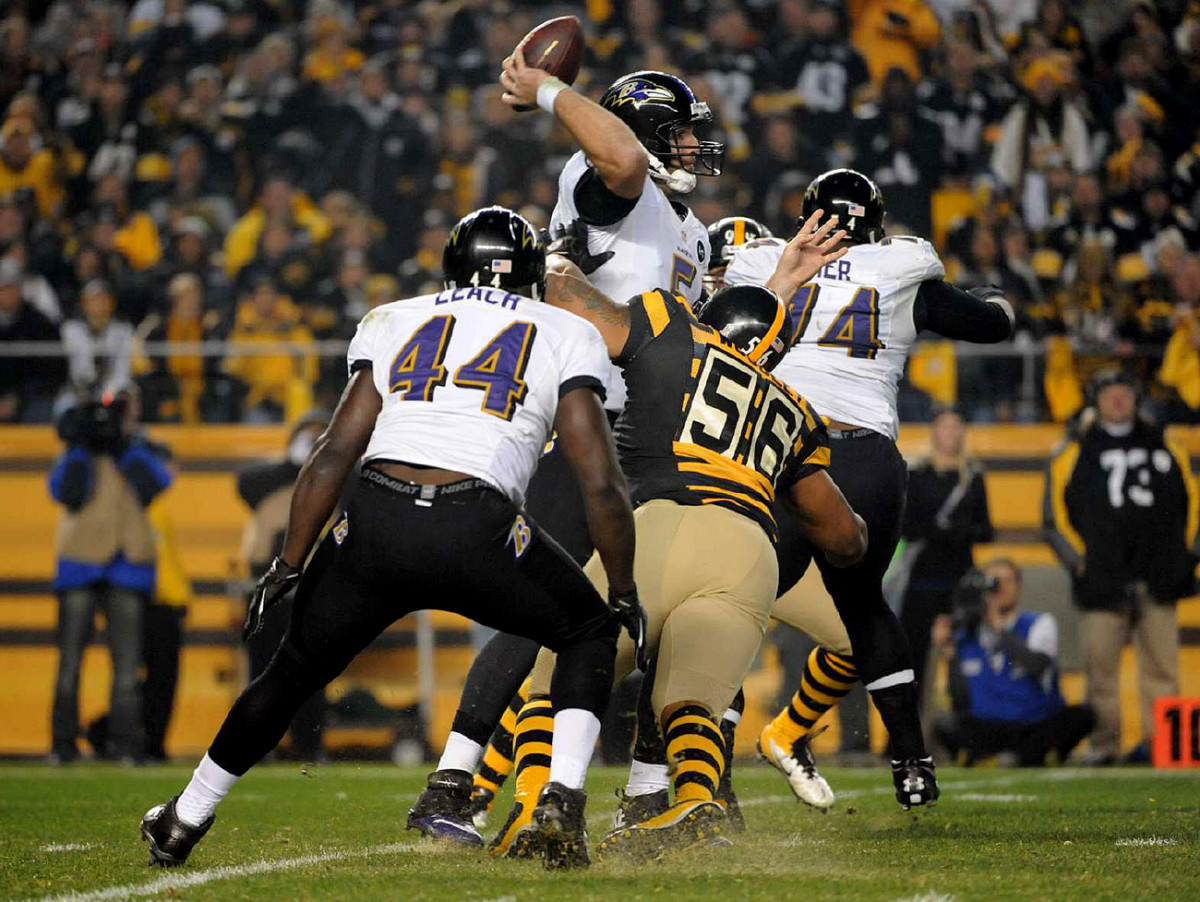
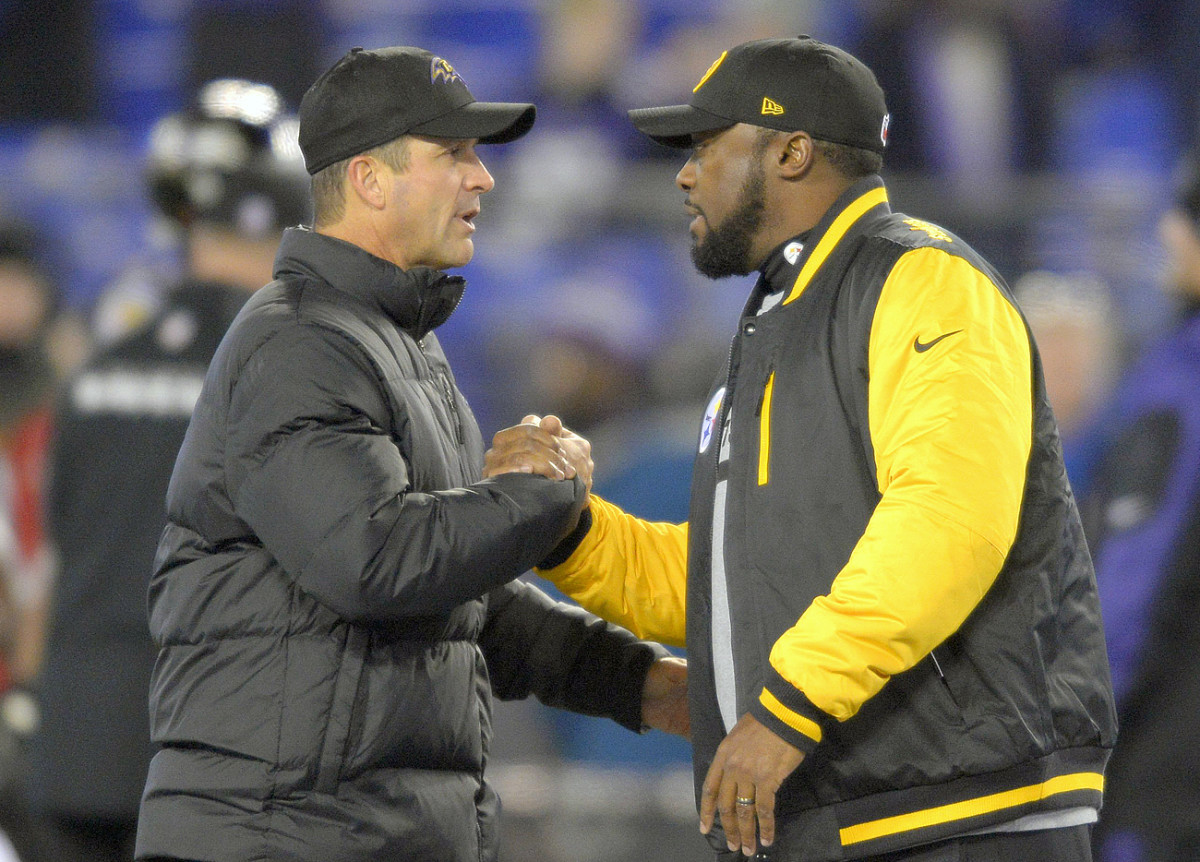
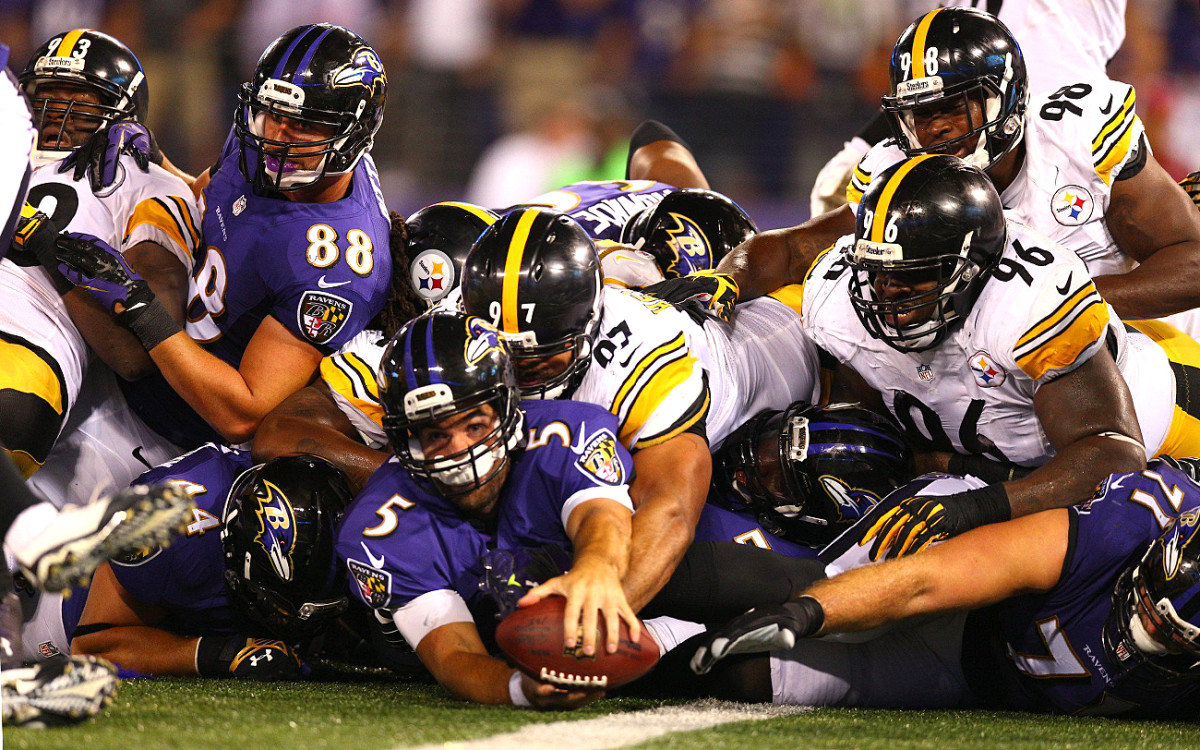
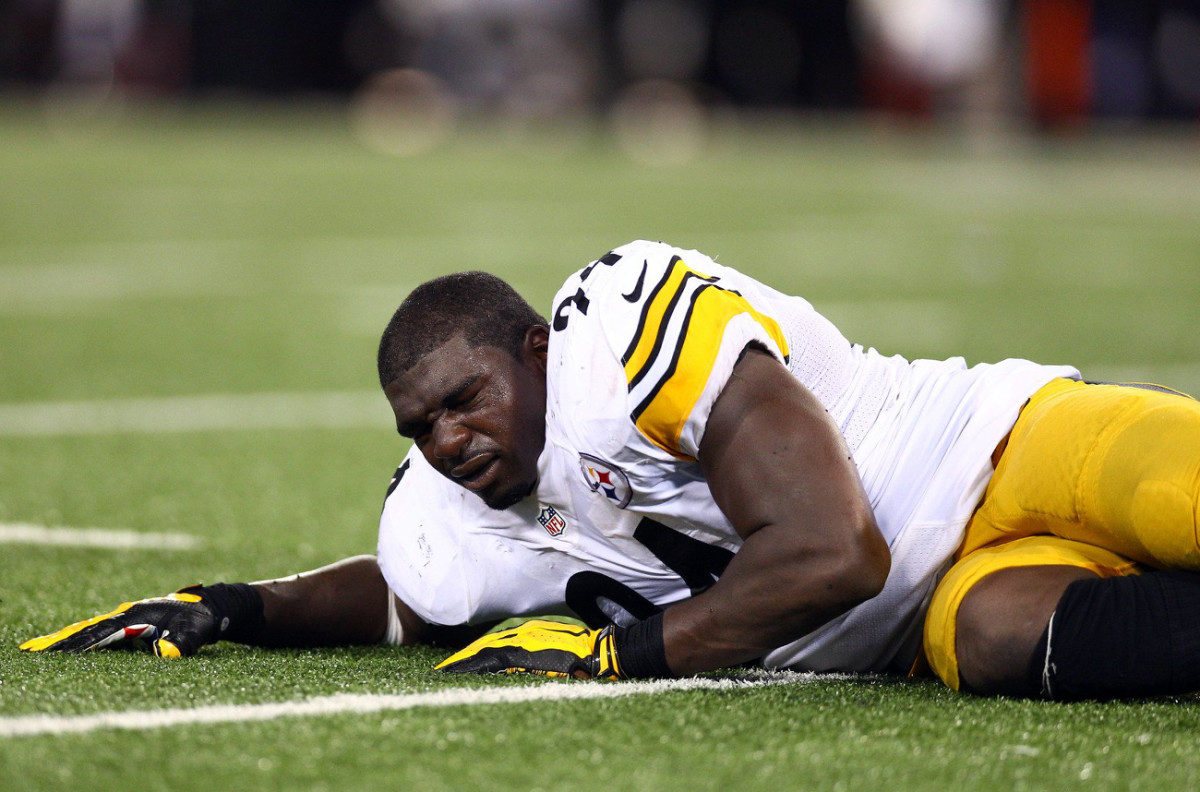
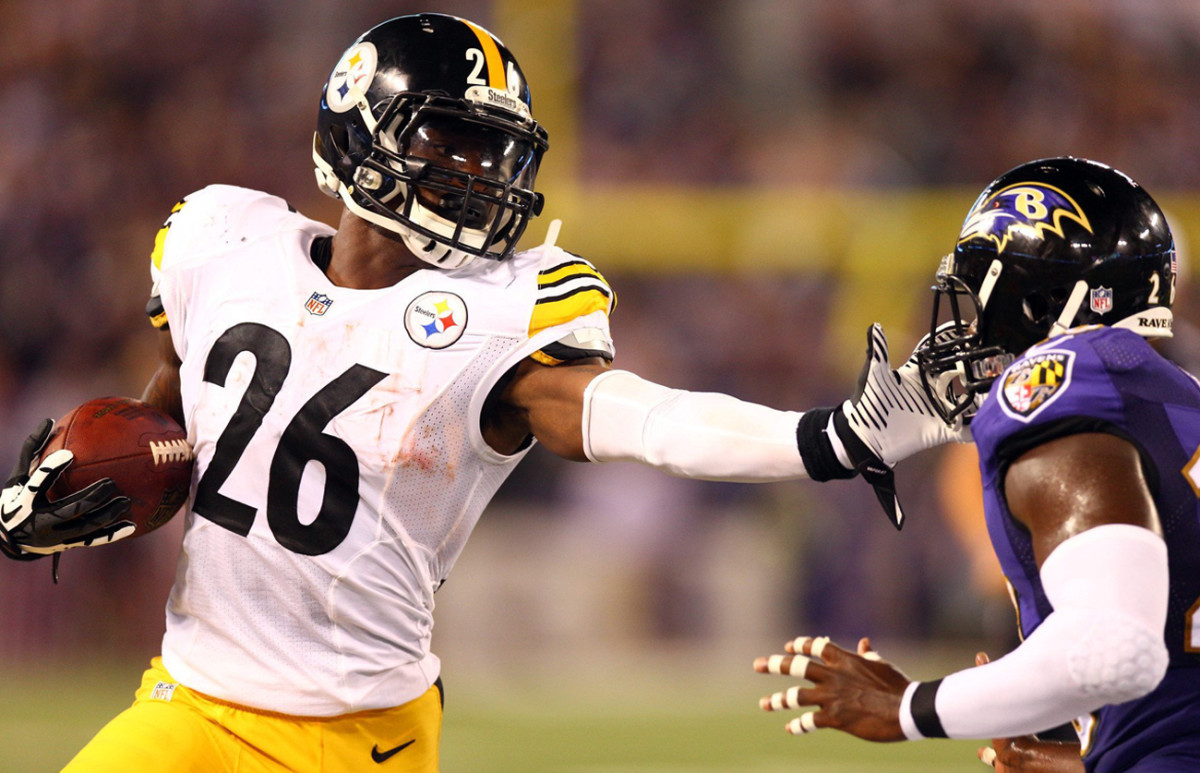
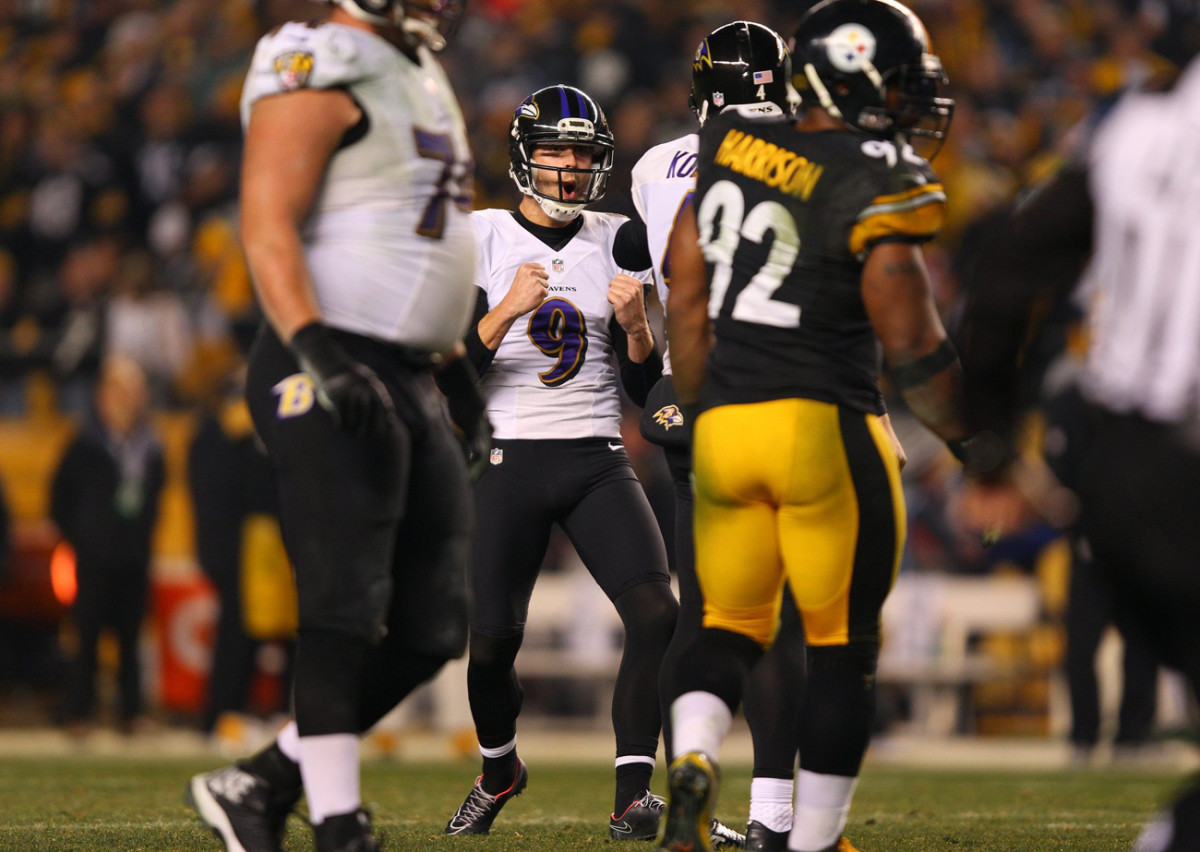
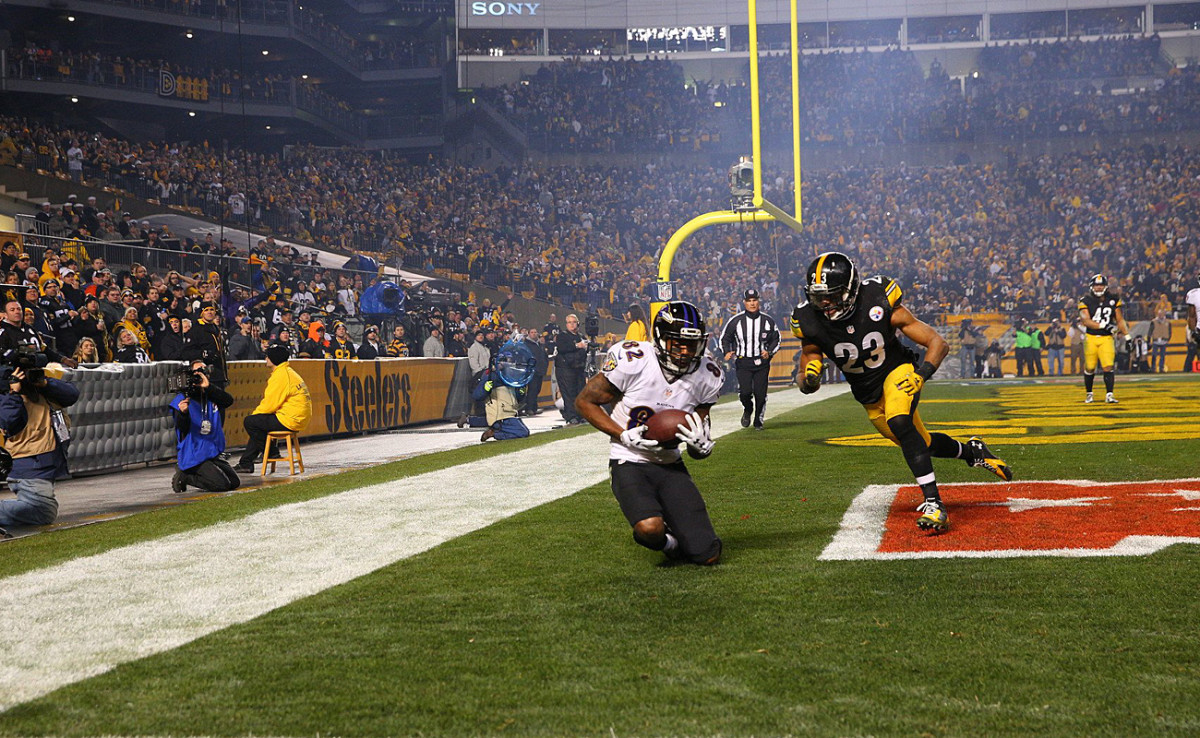
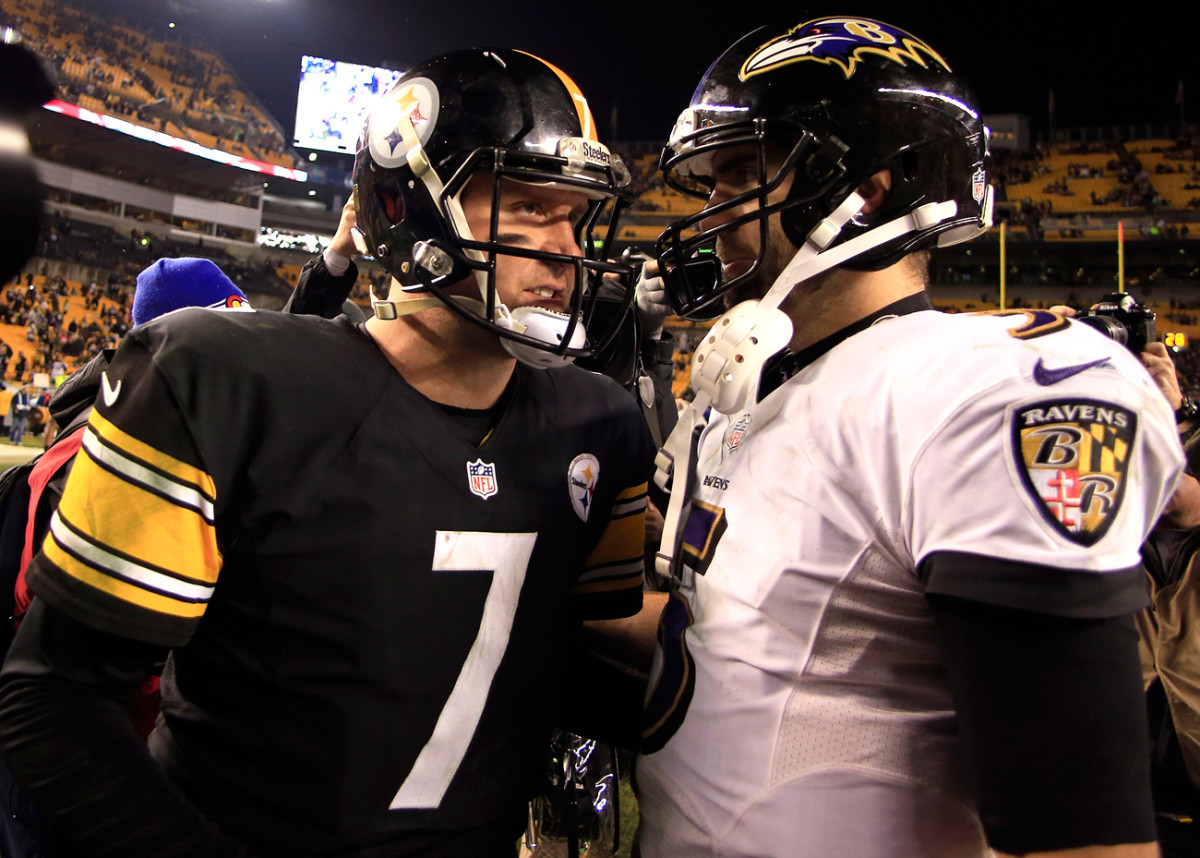
Question or comment? Email us at talkback@themmqb.com.
